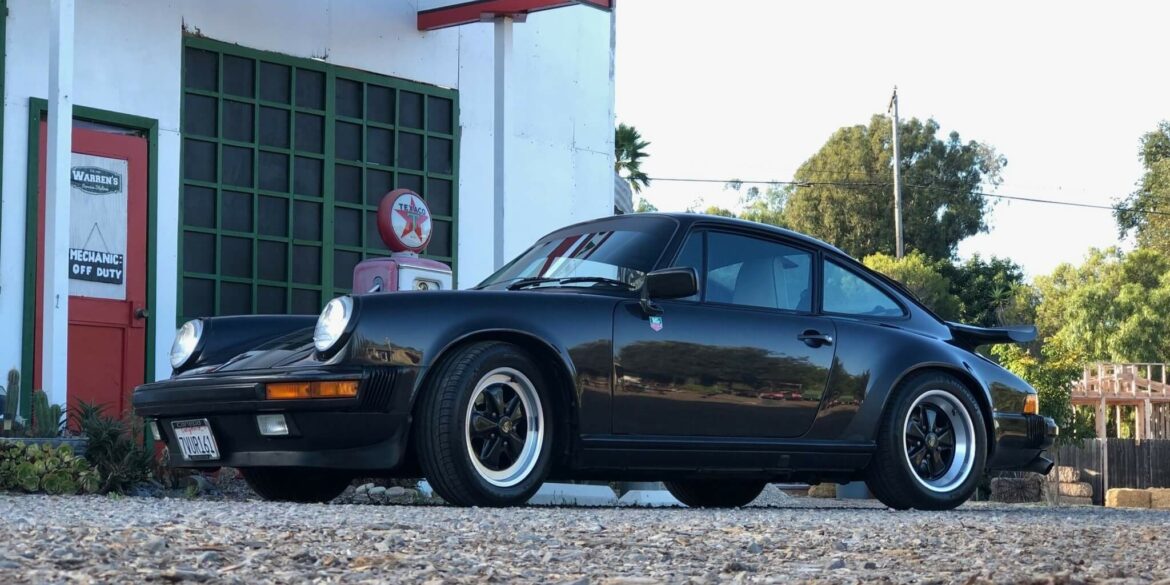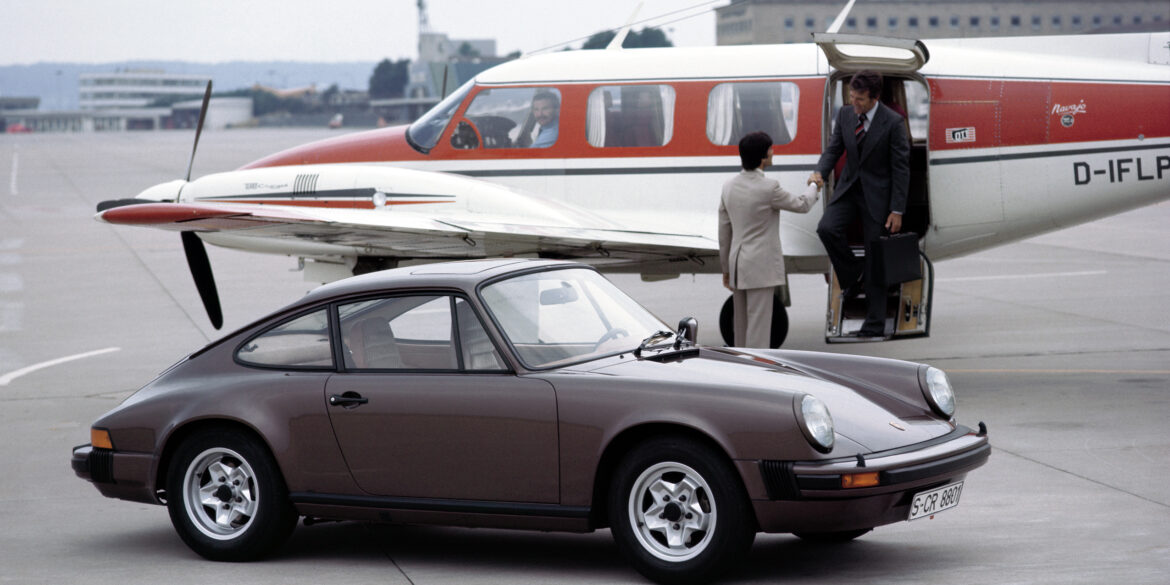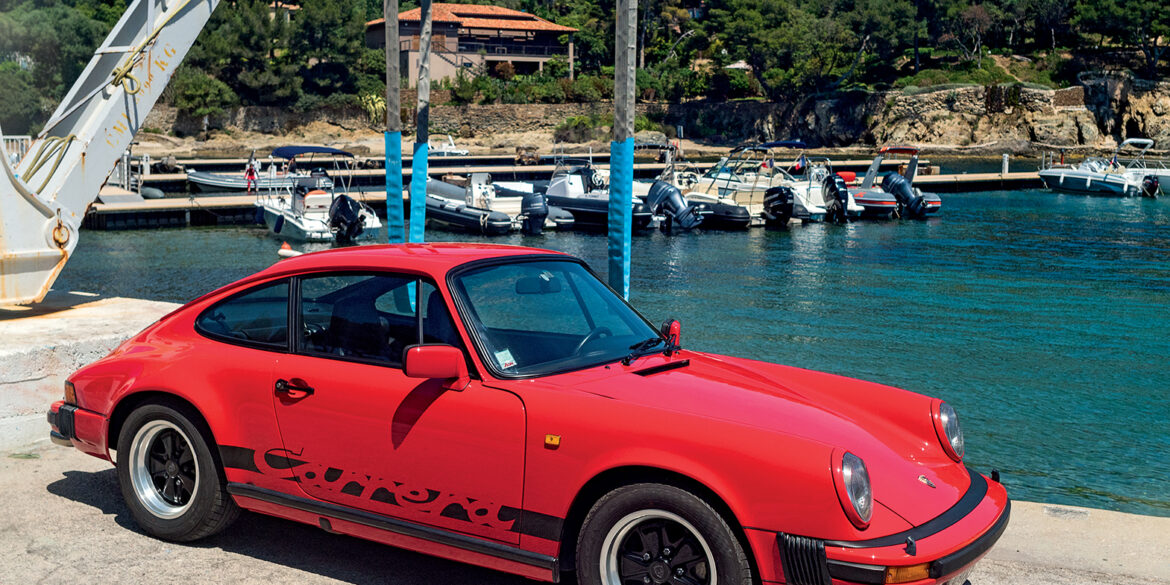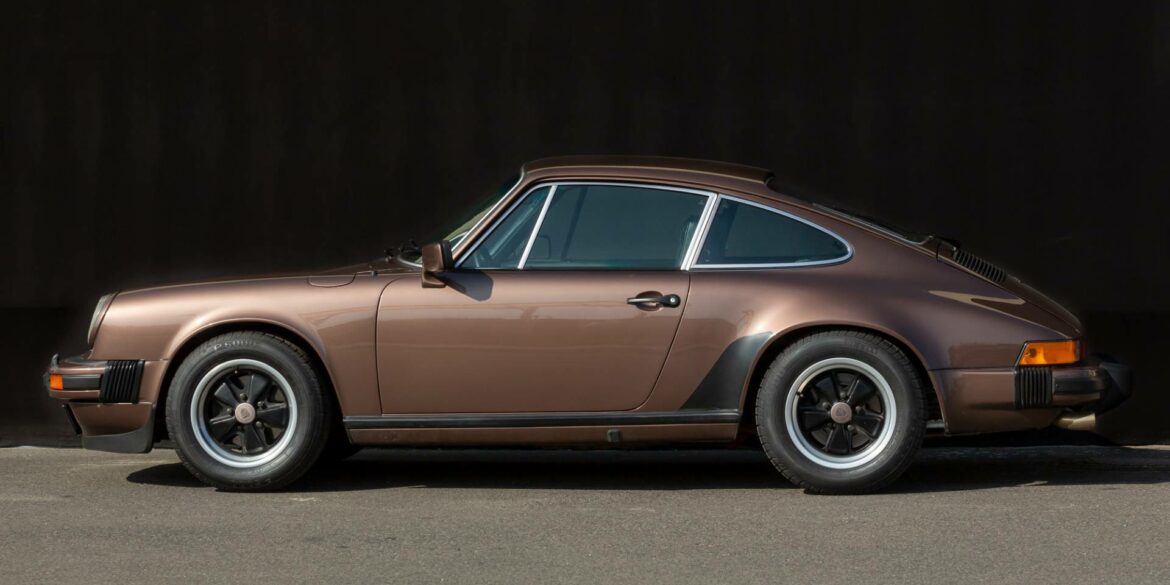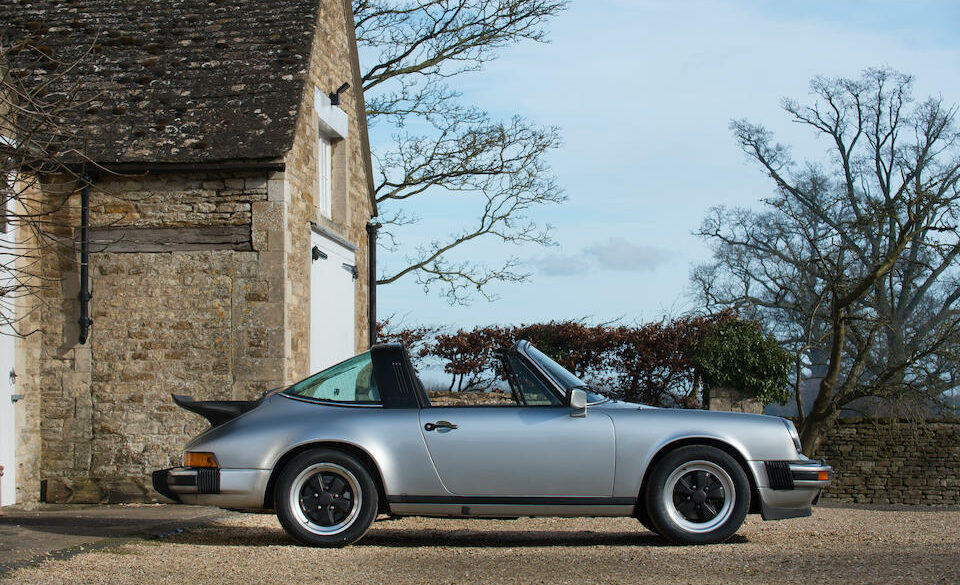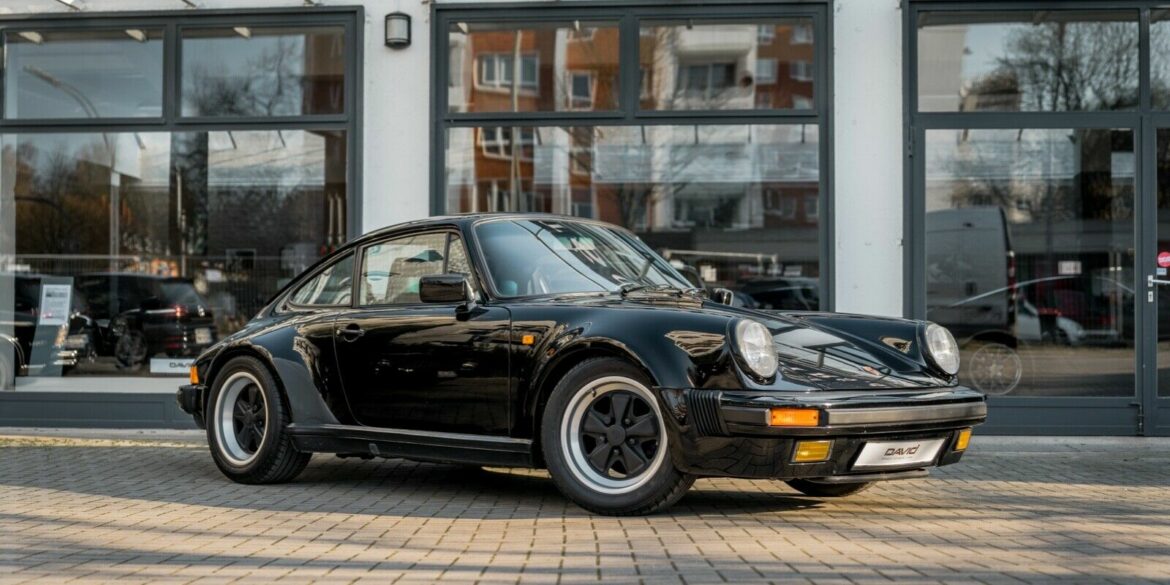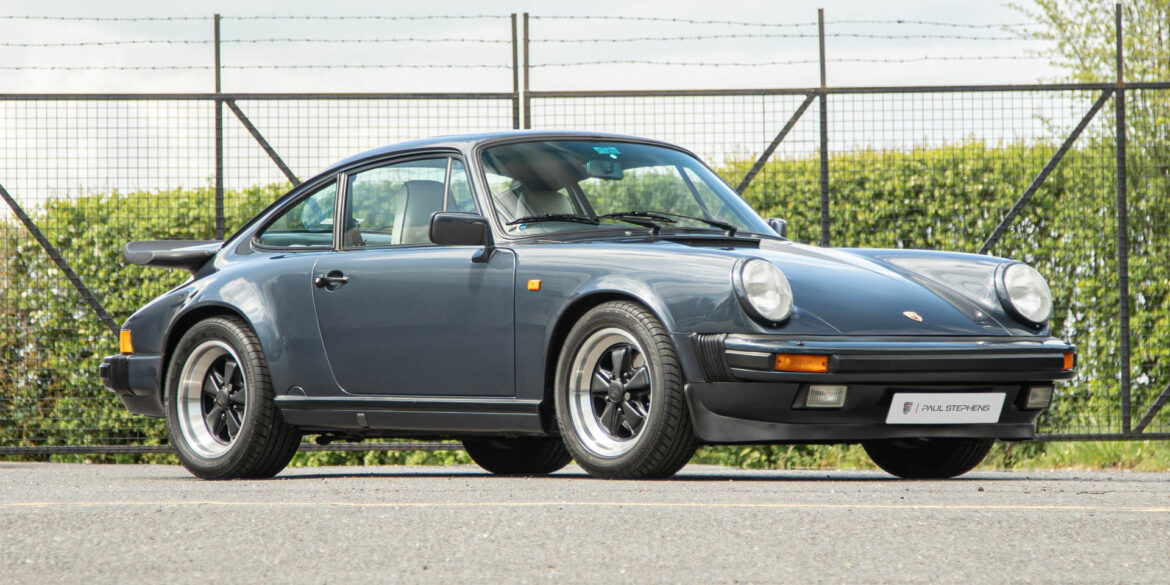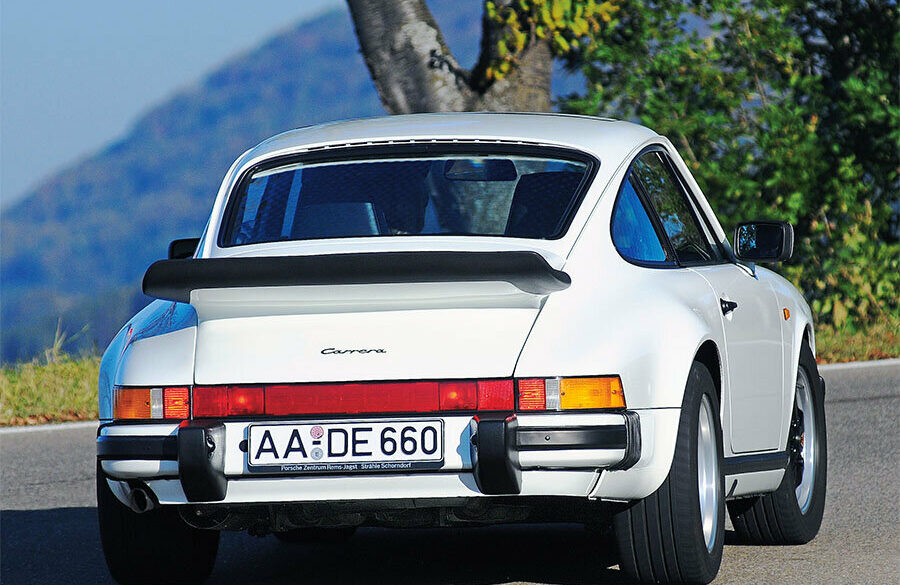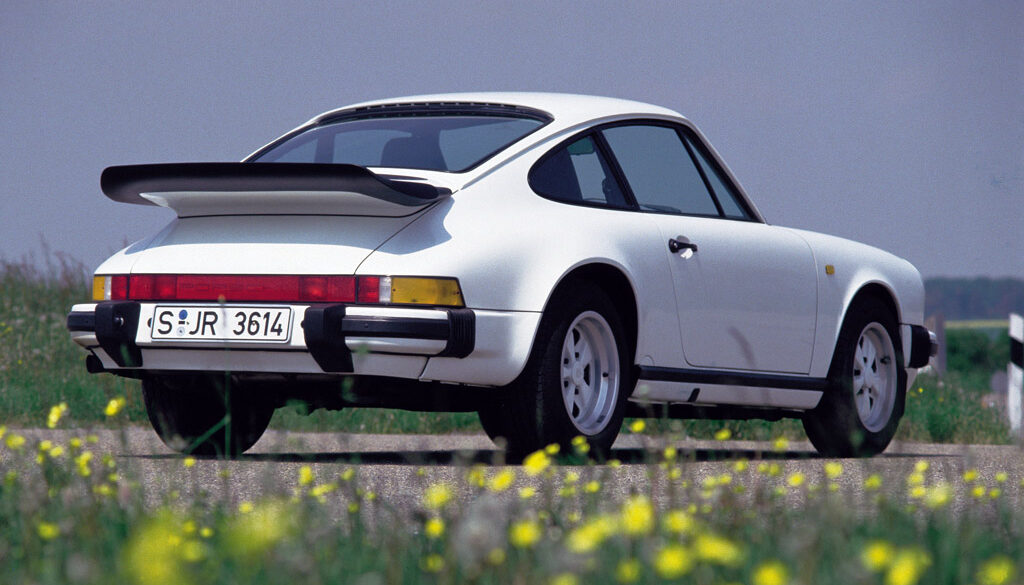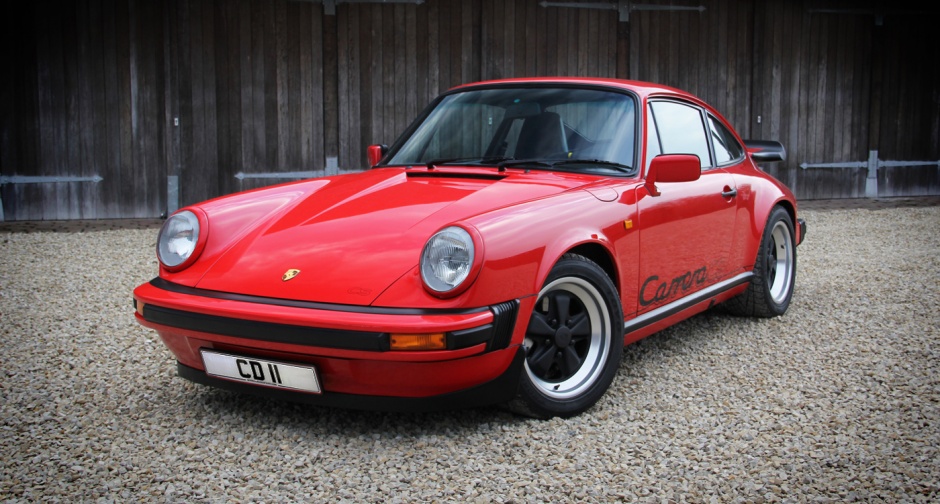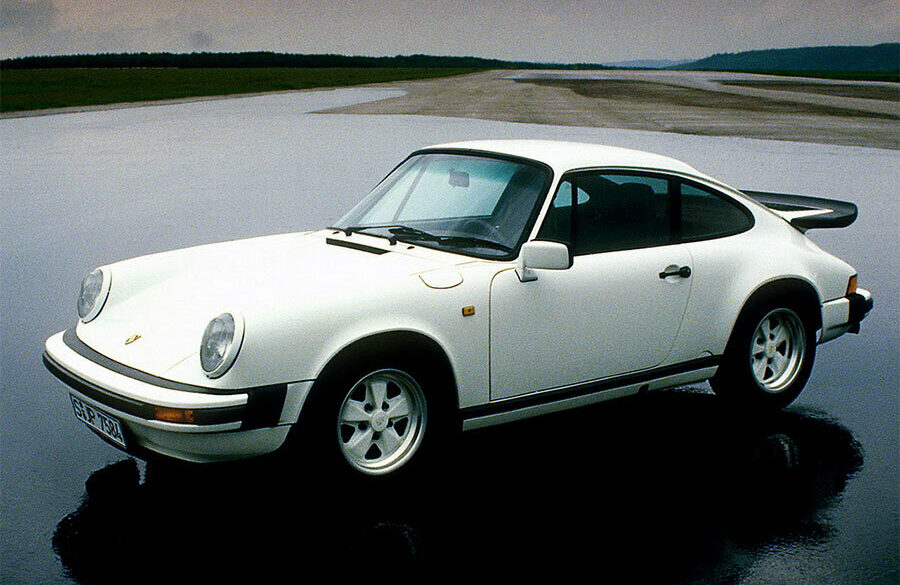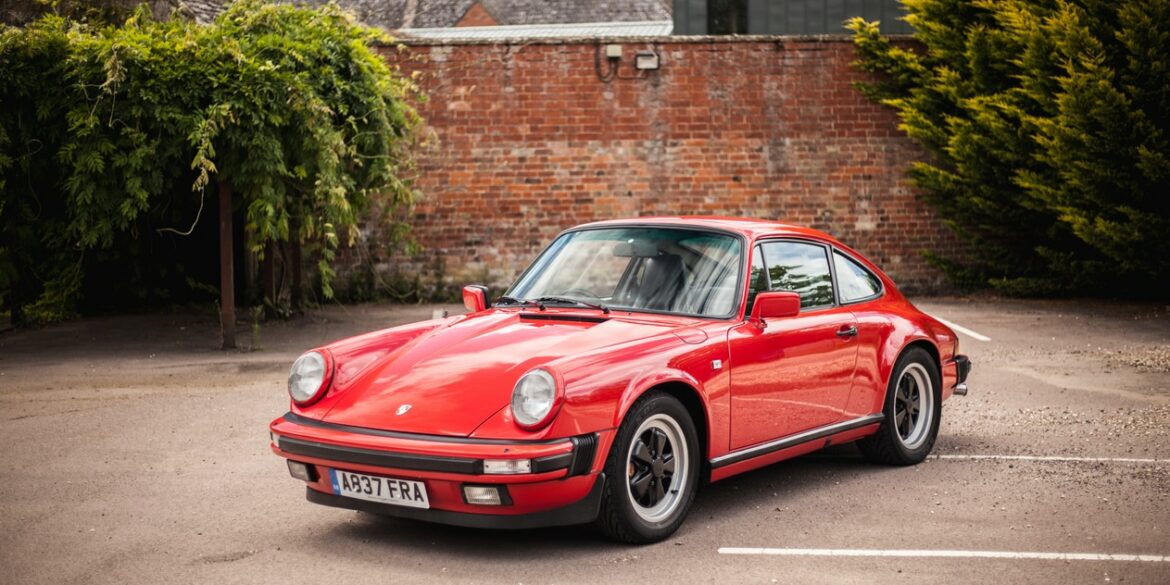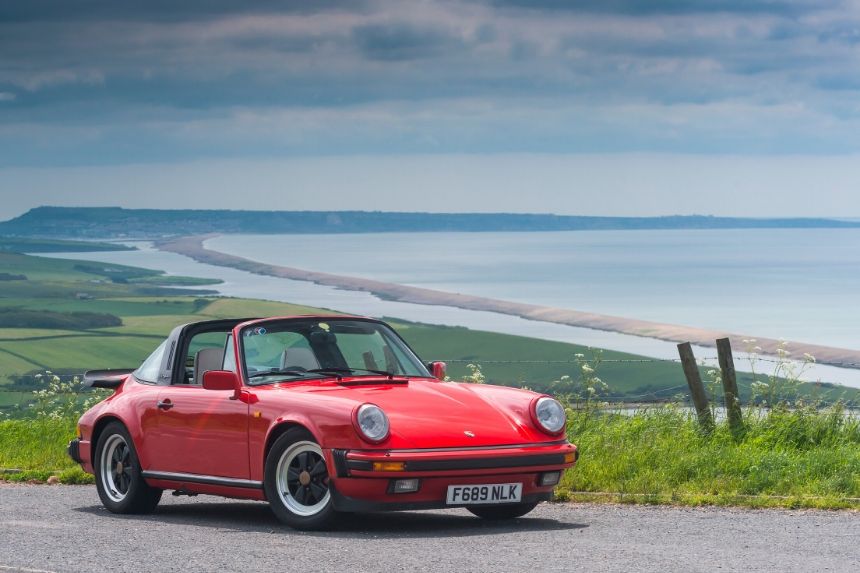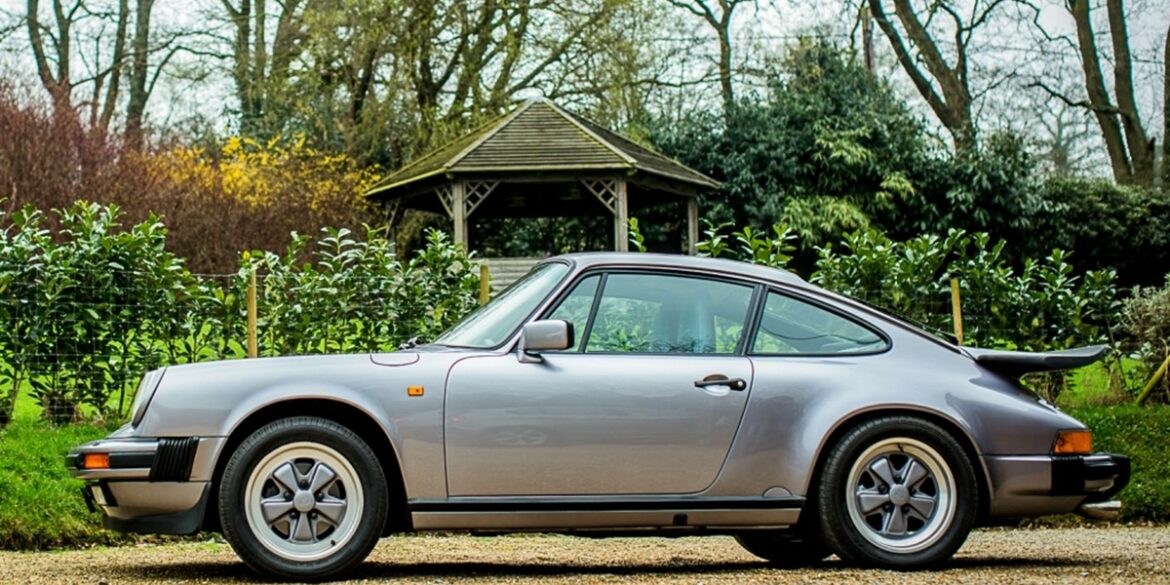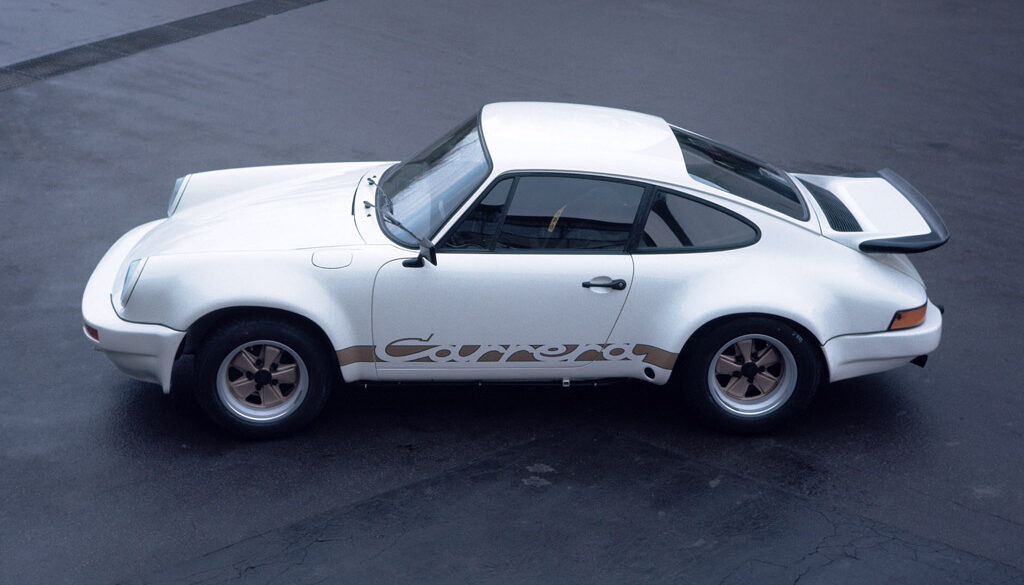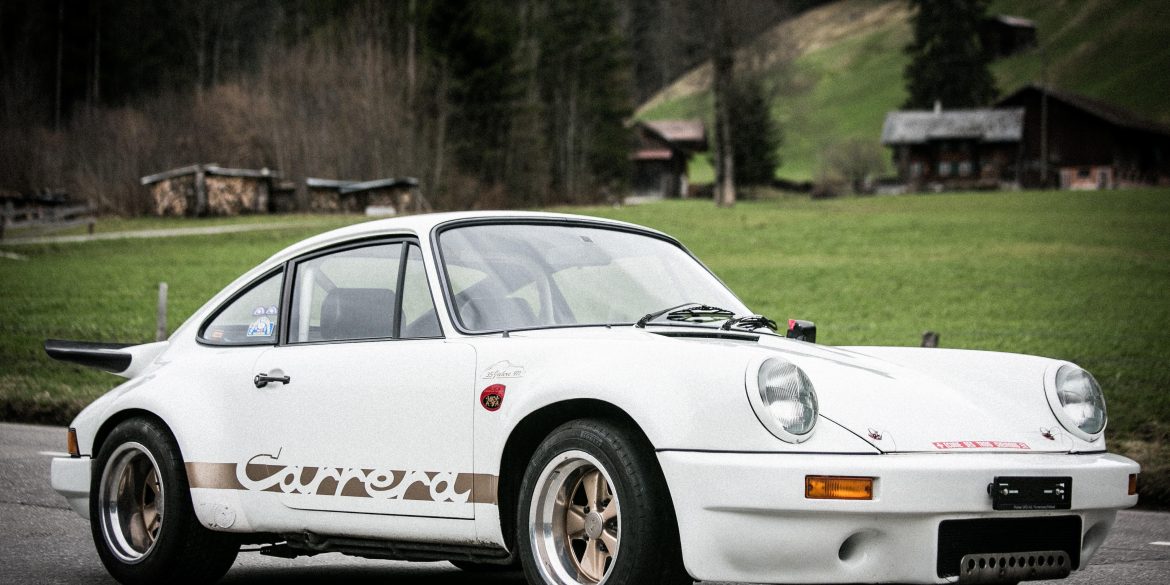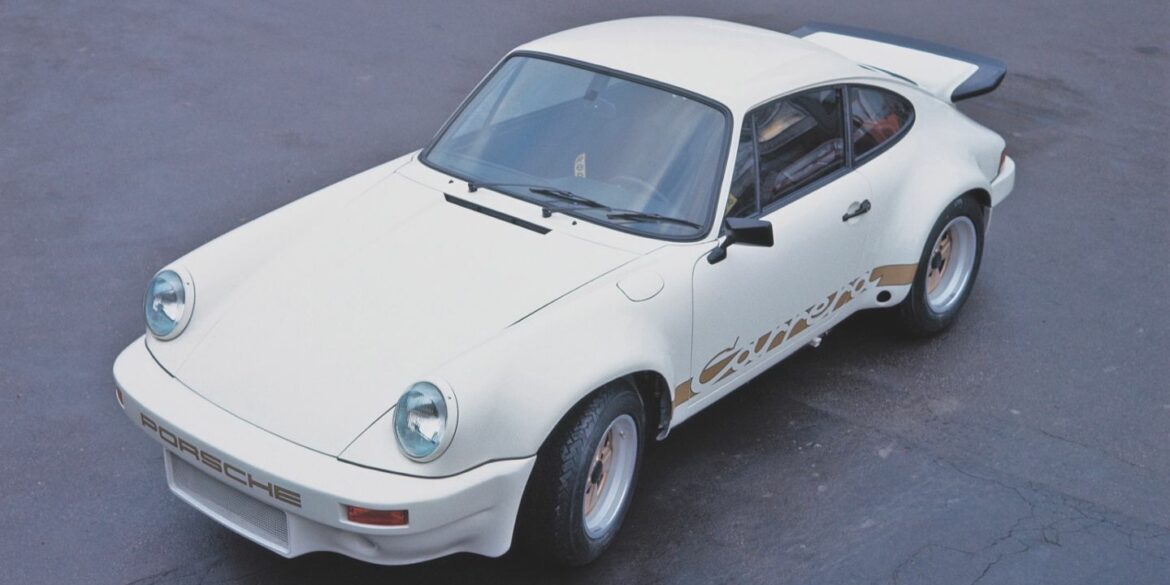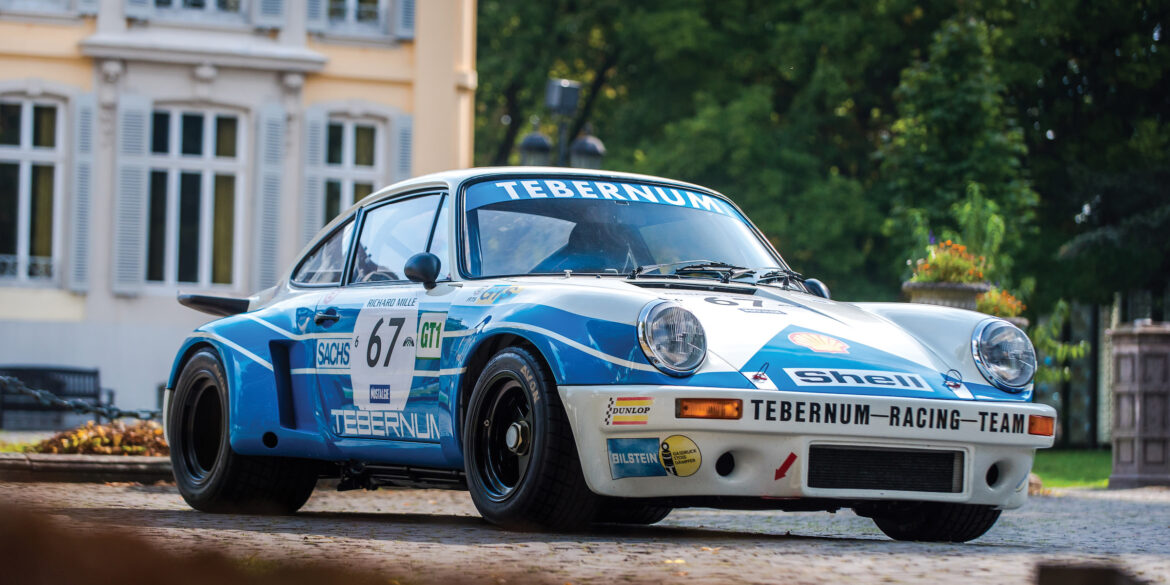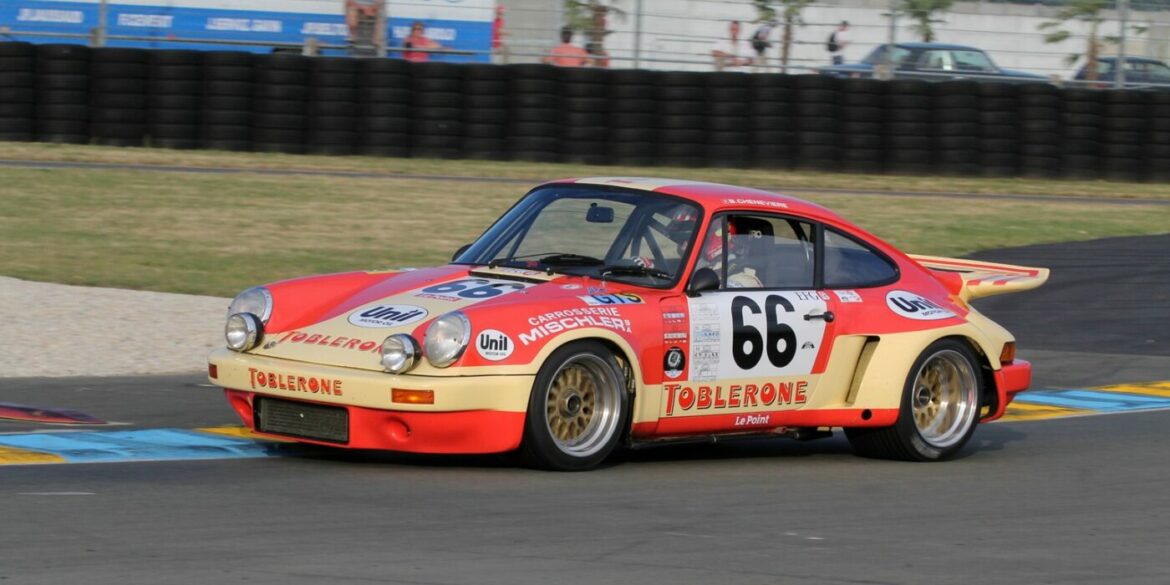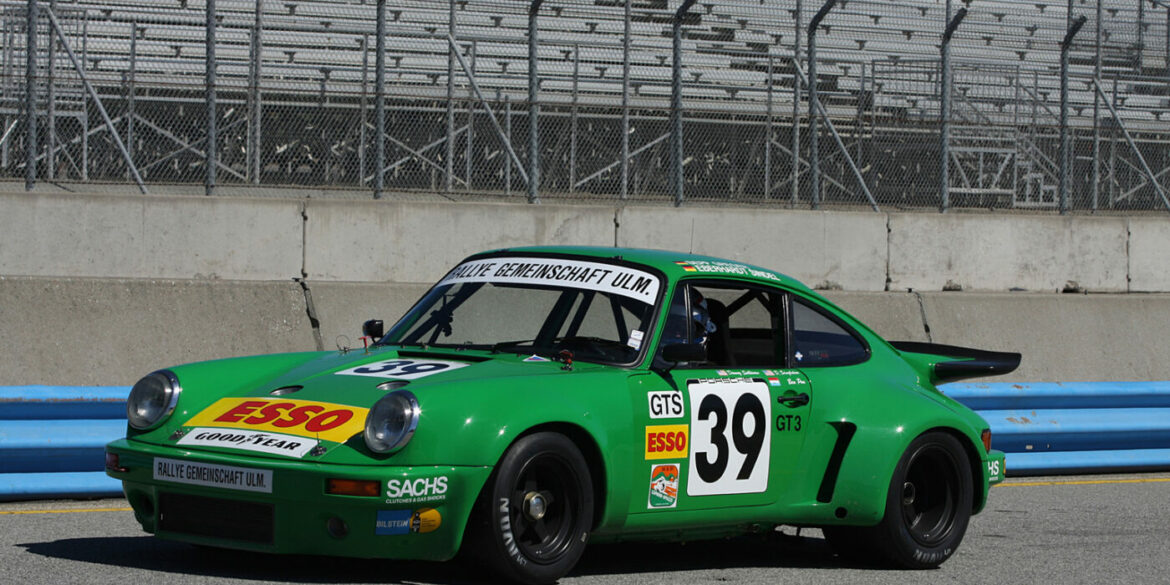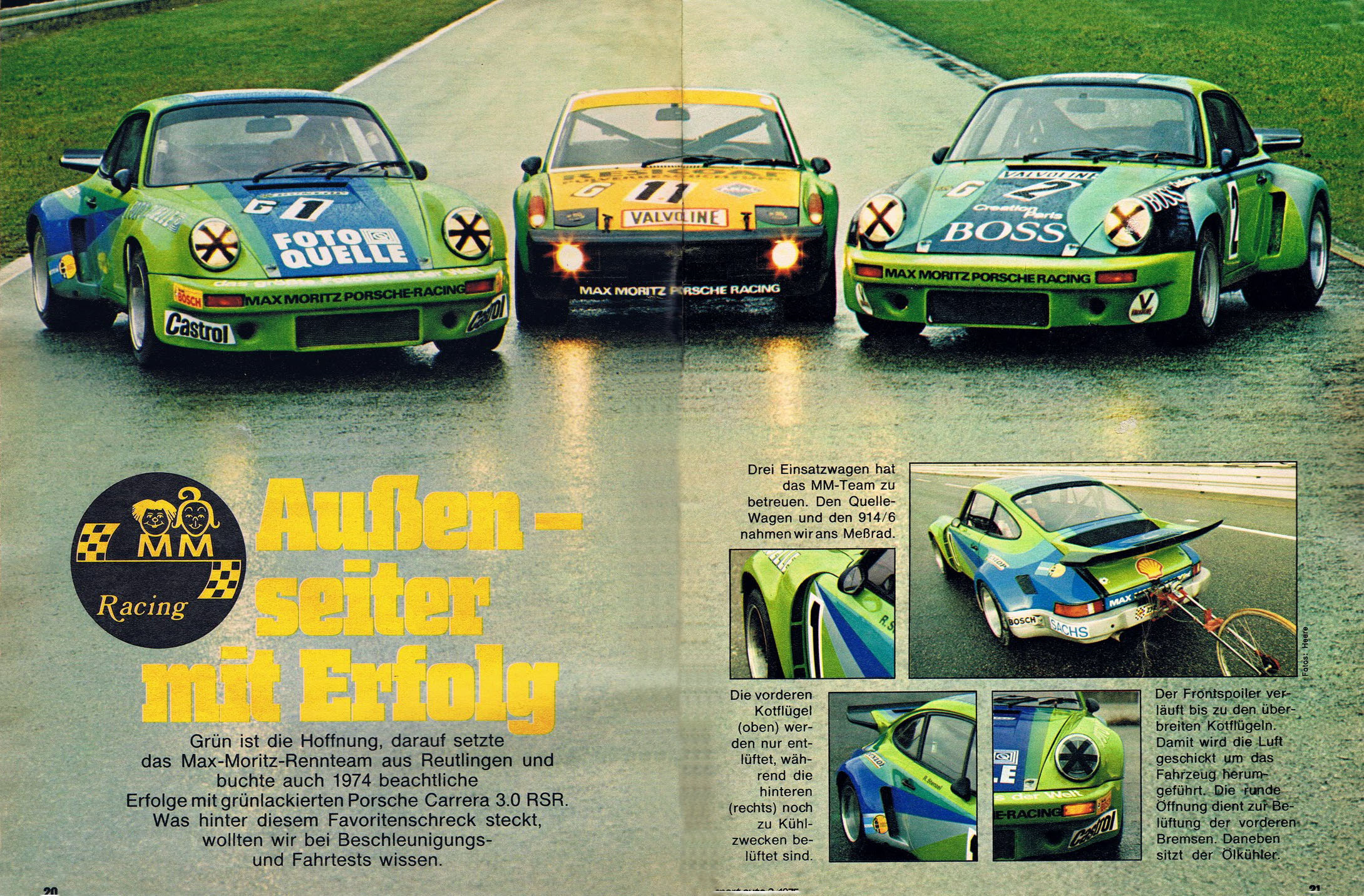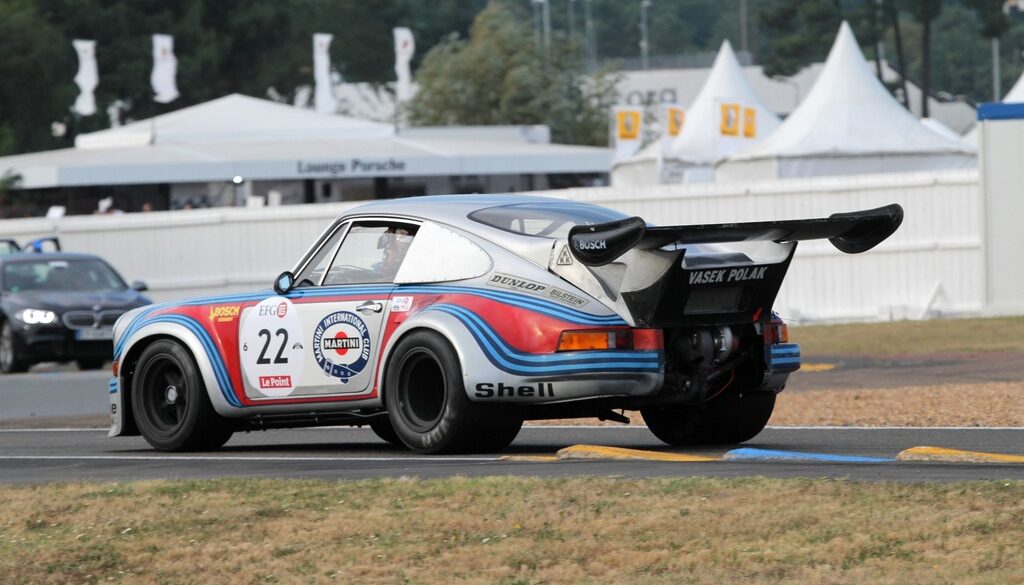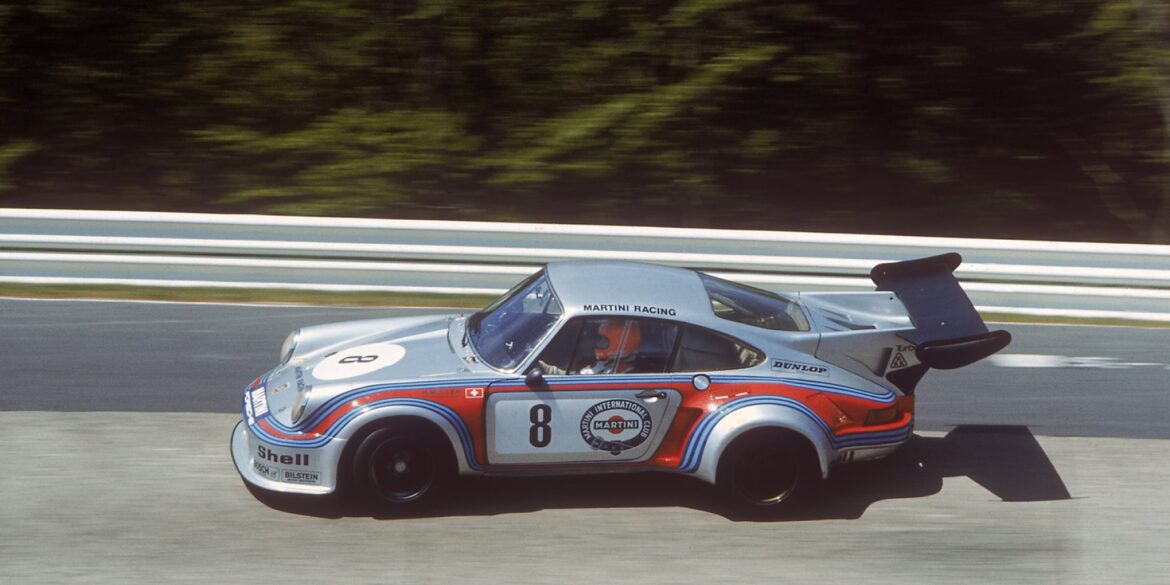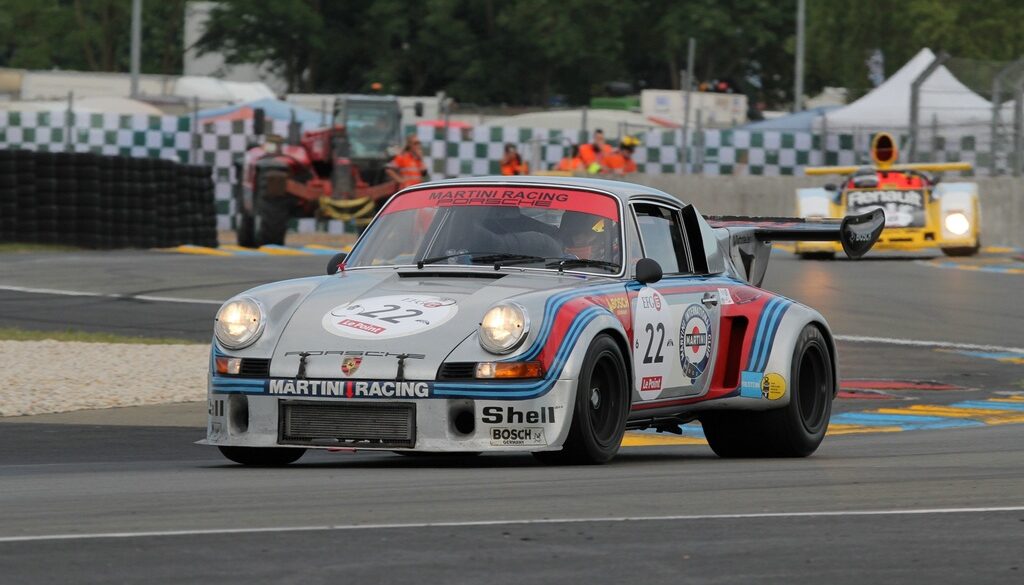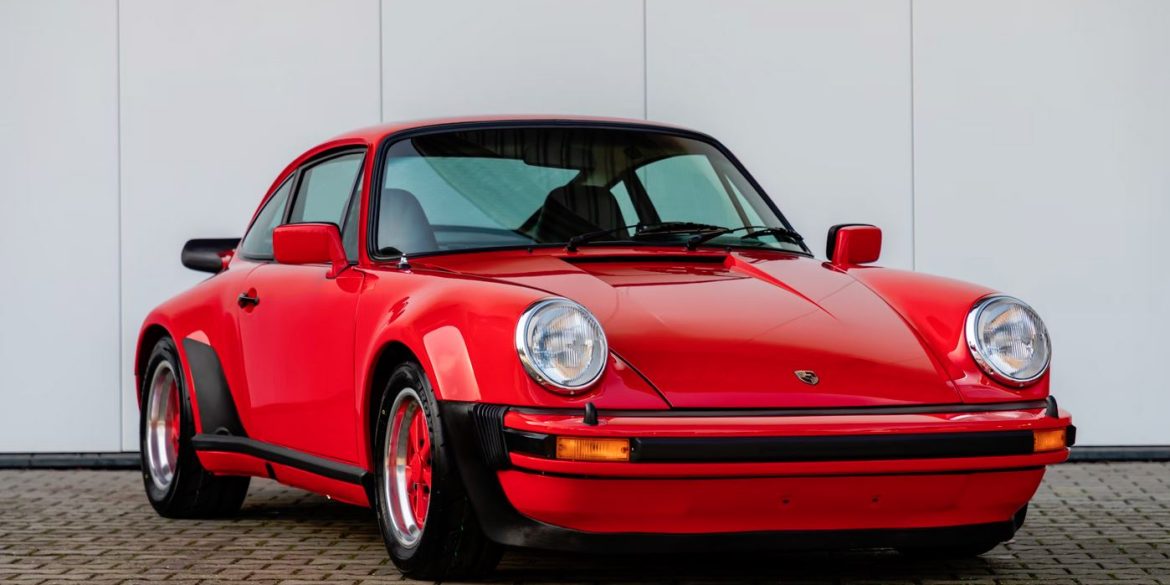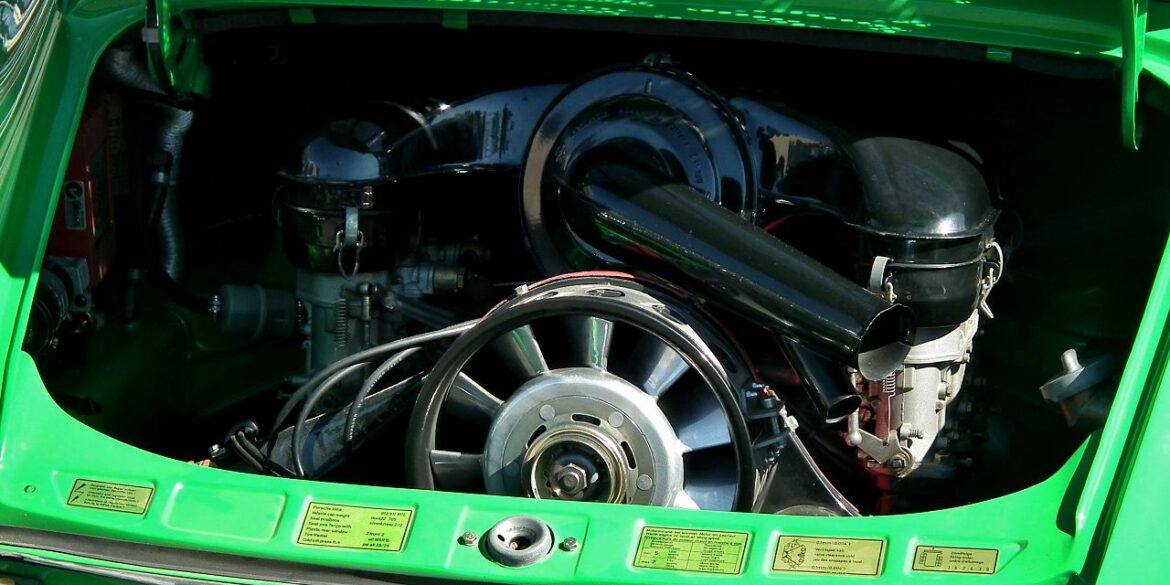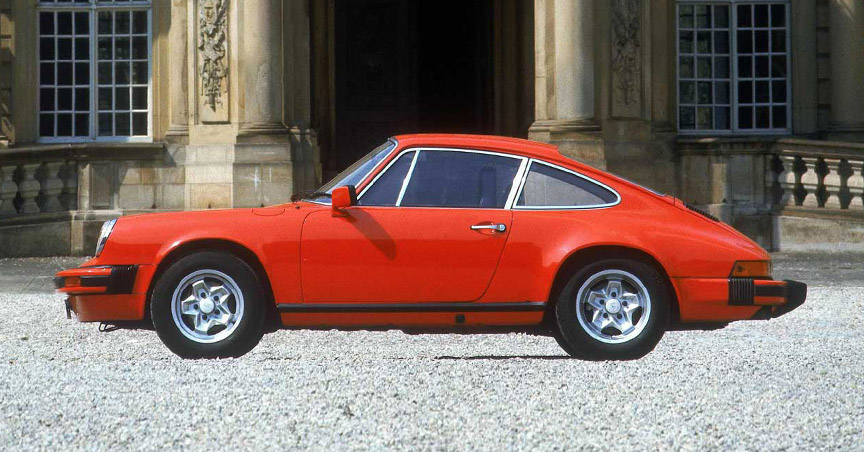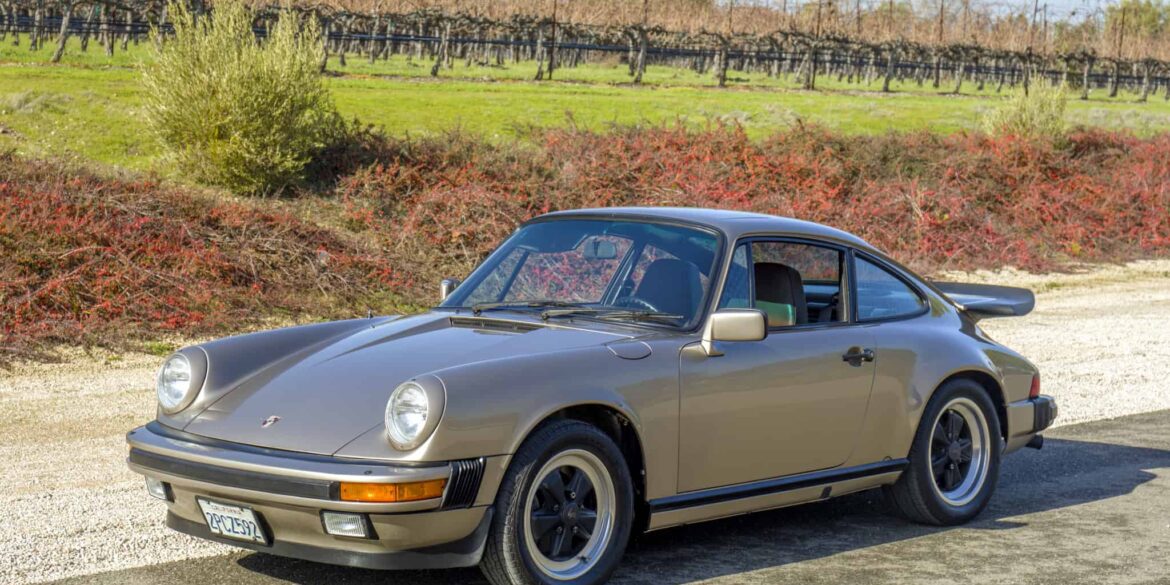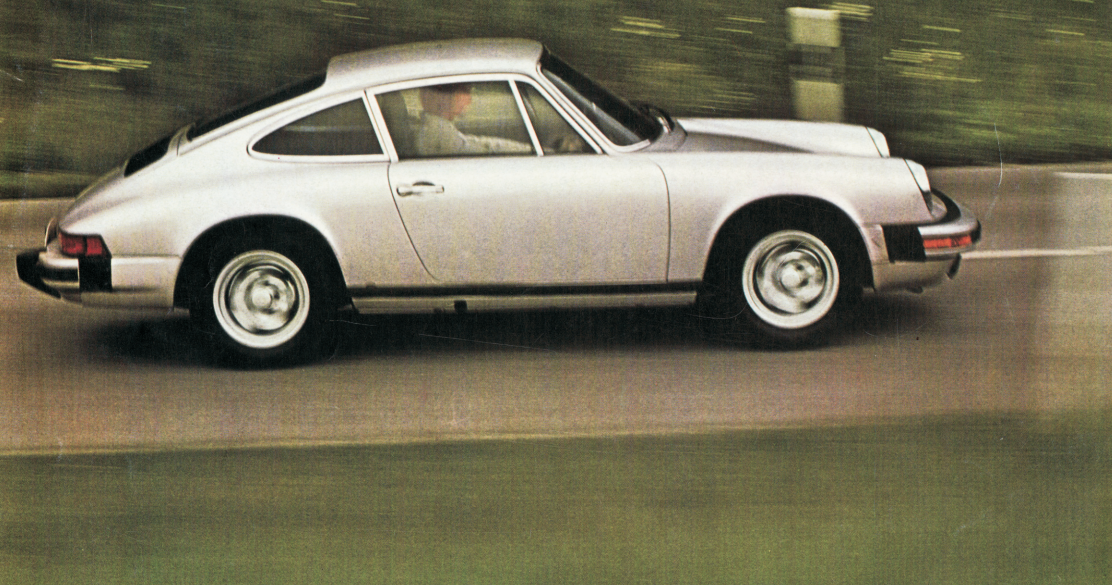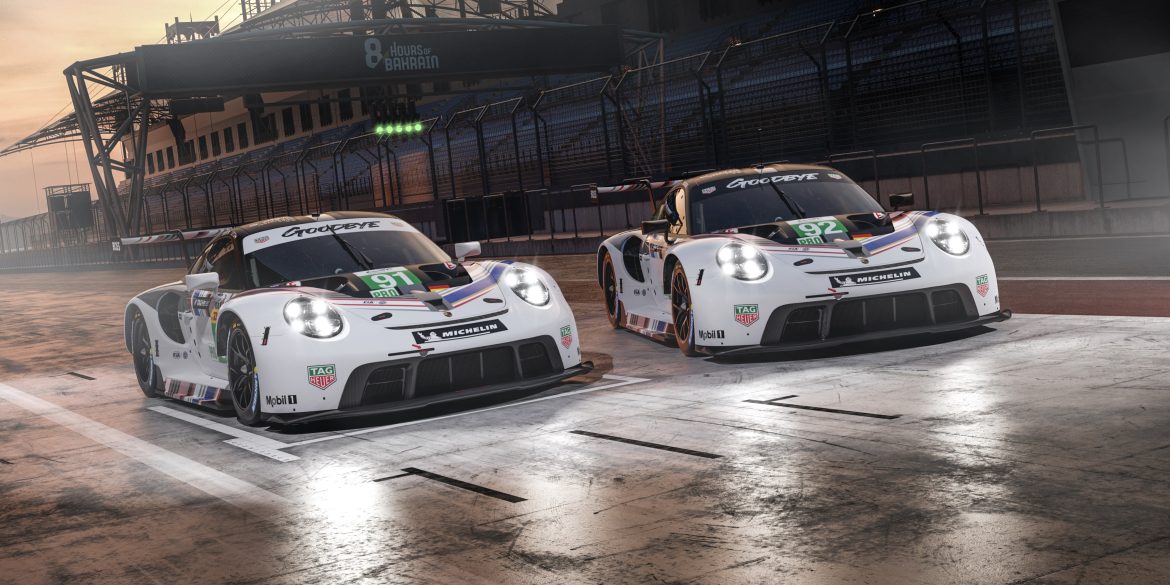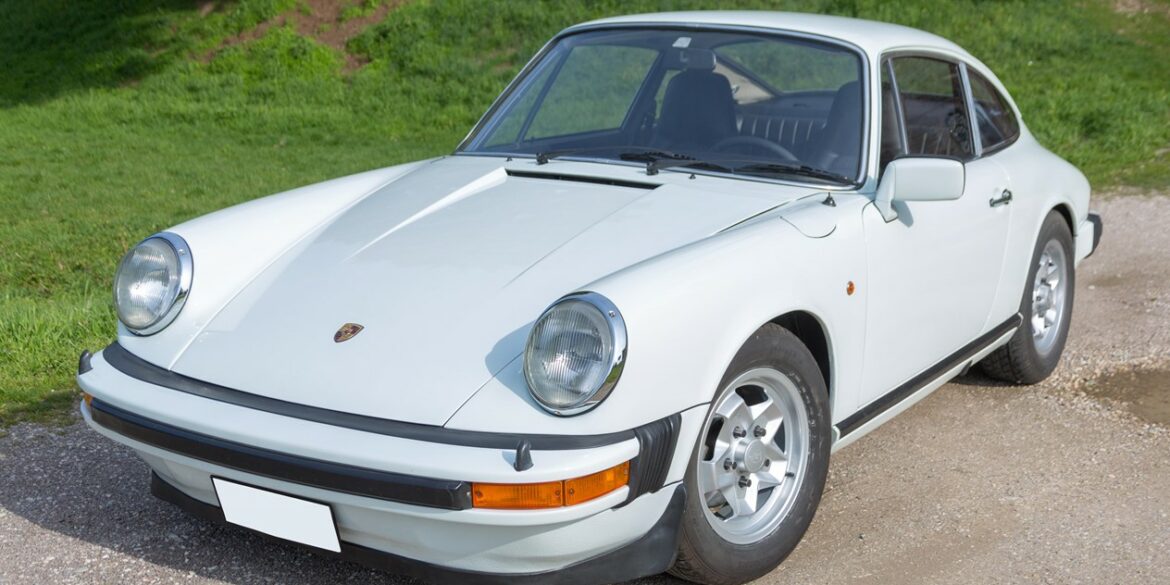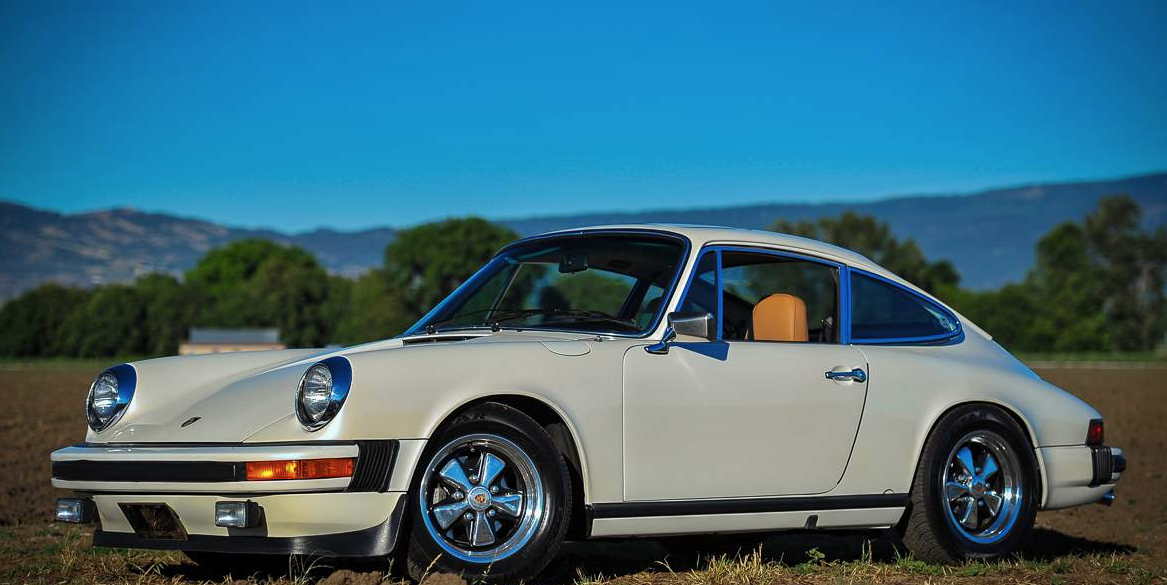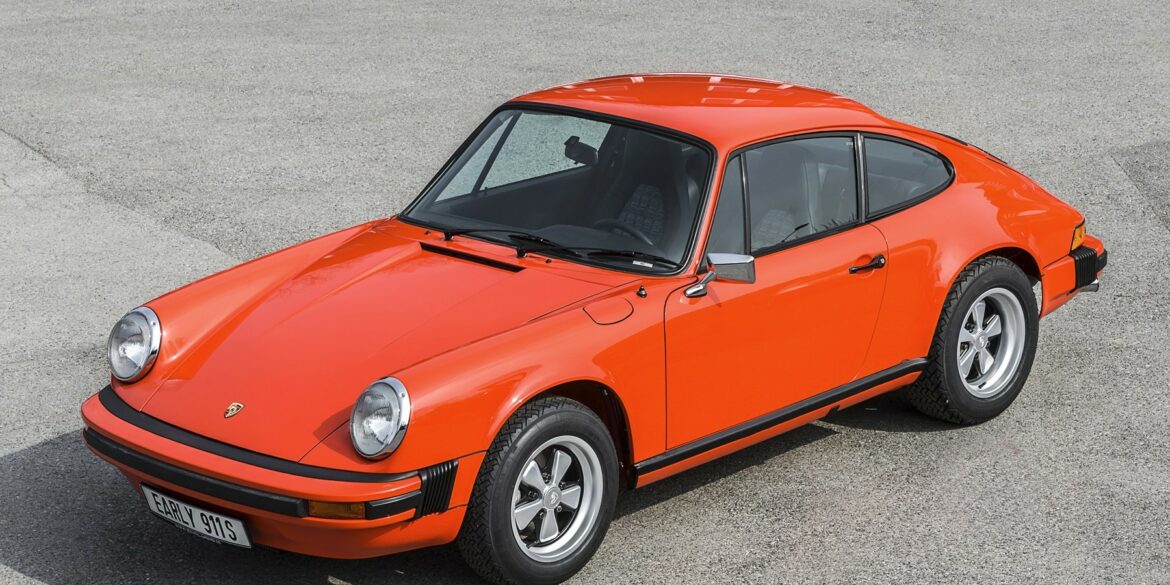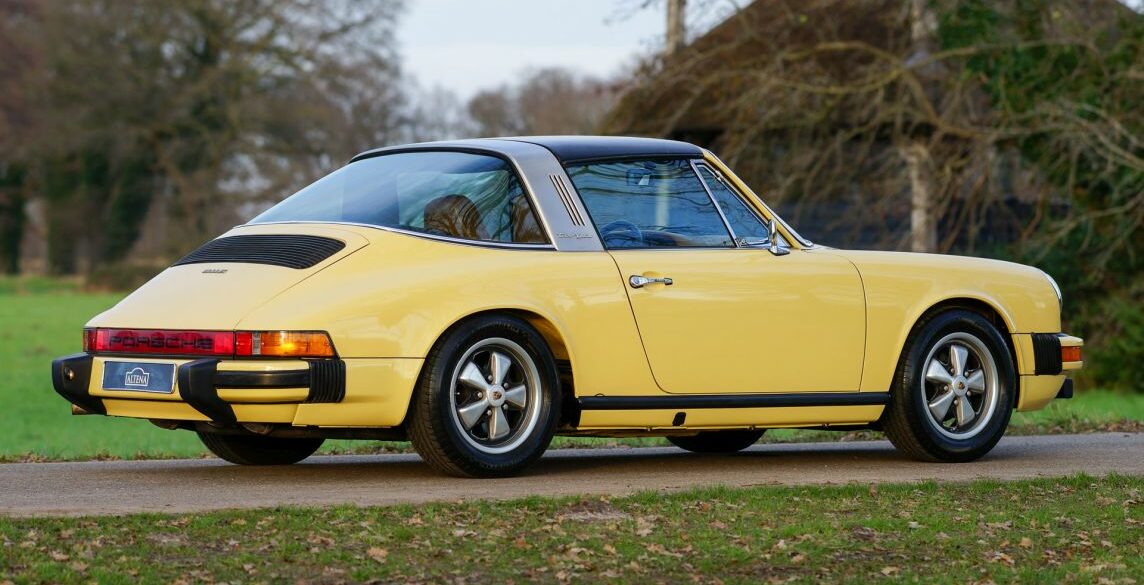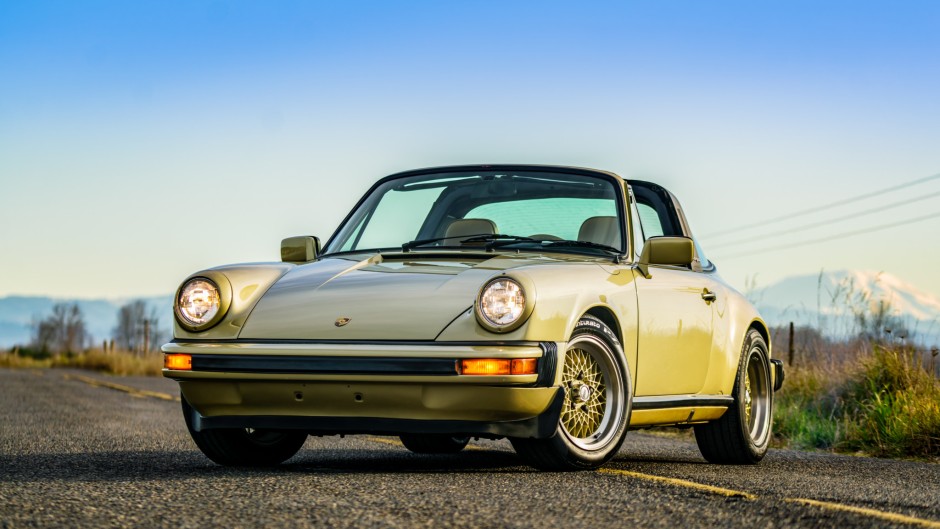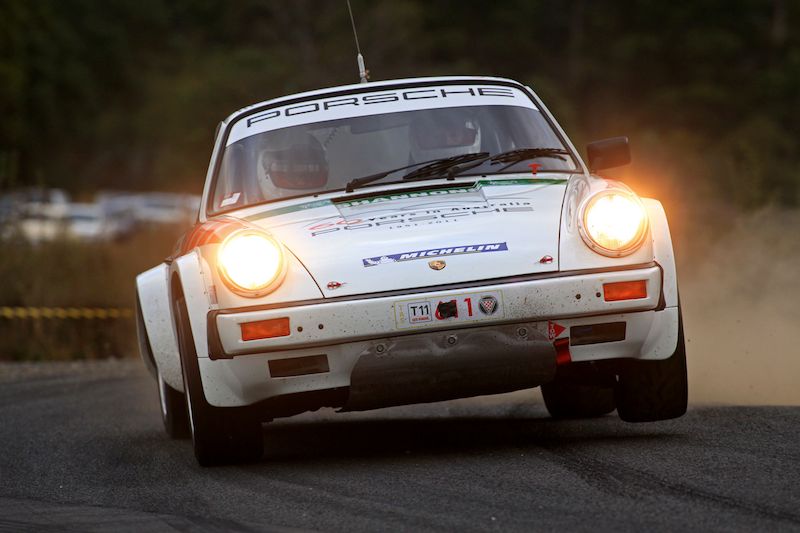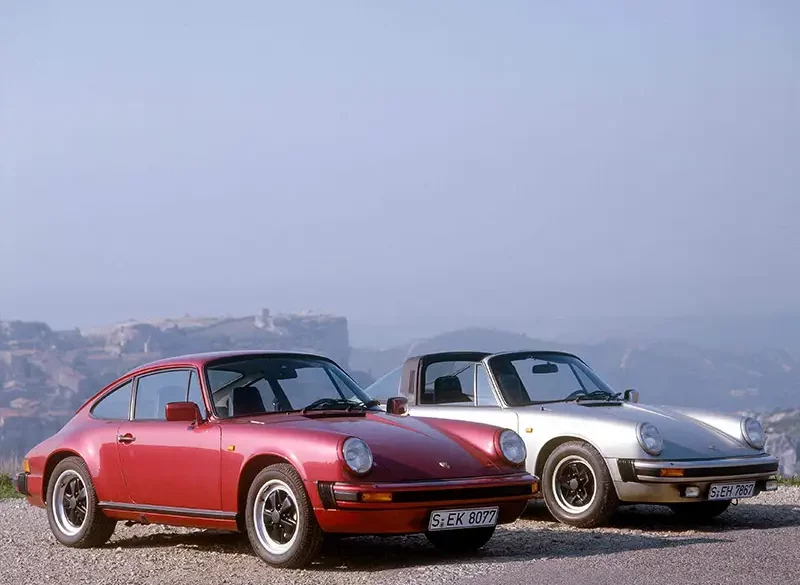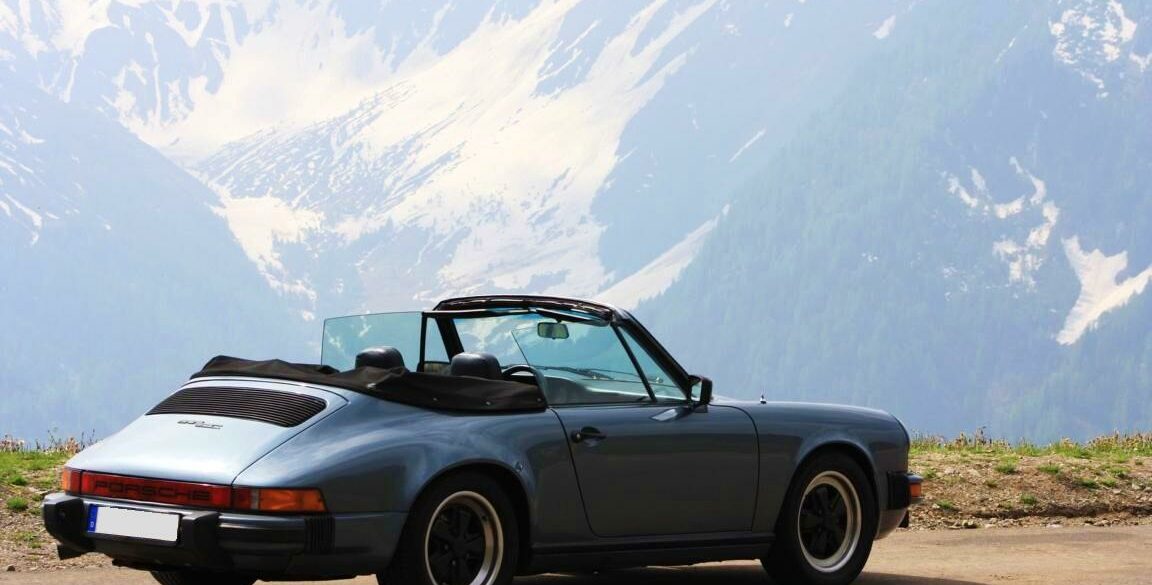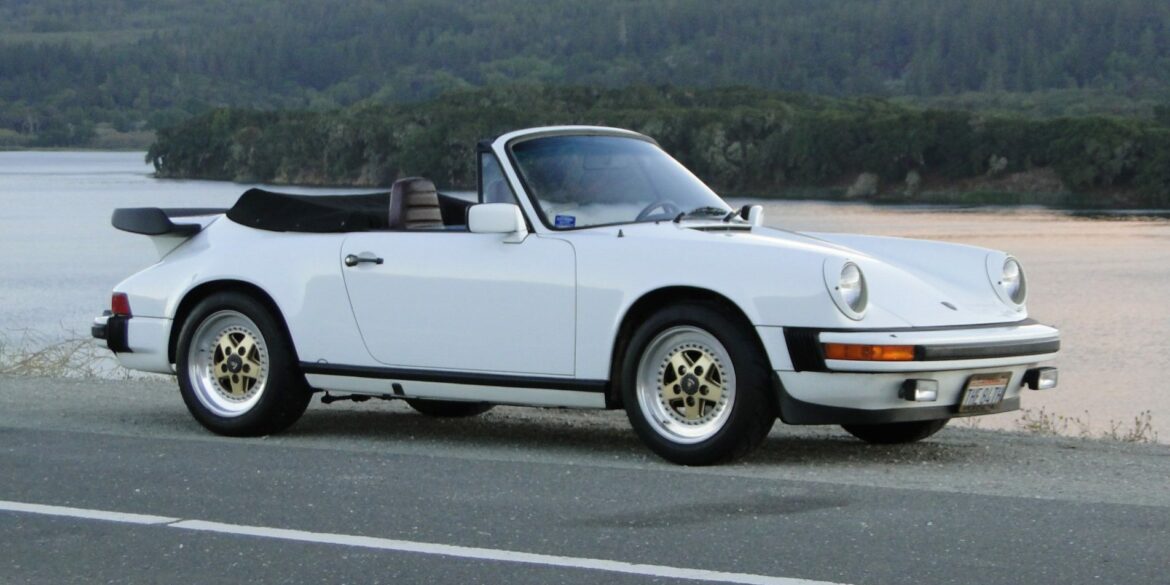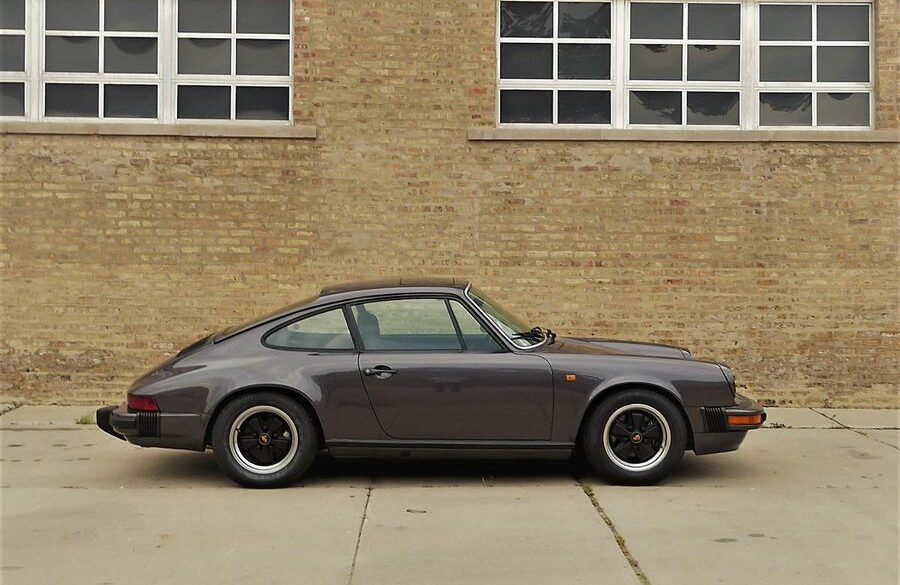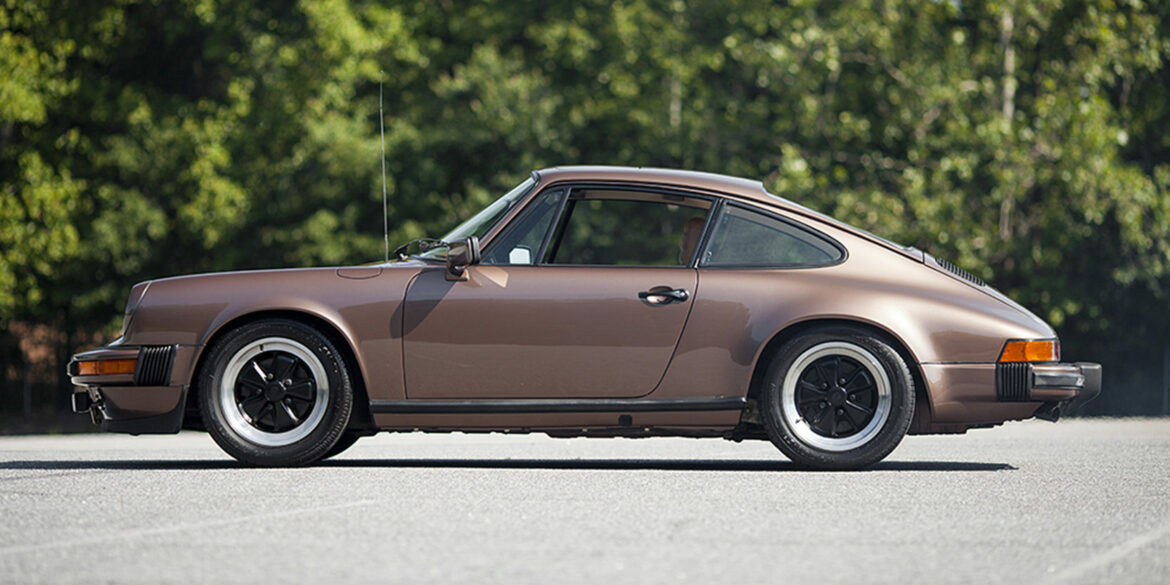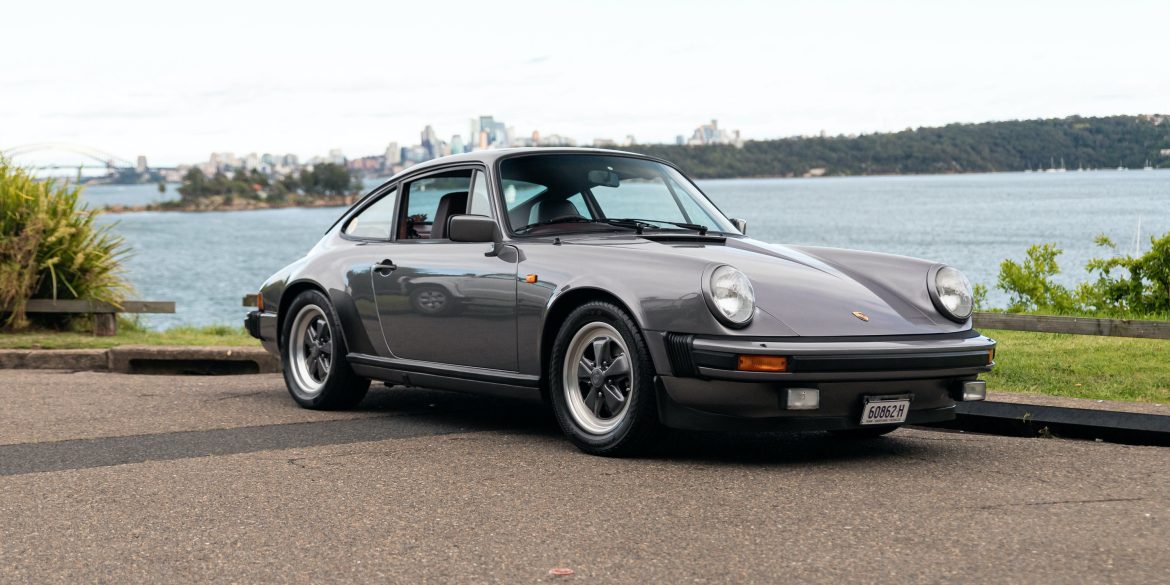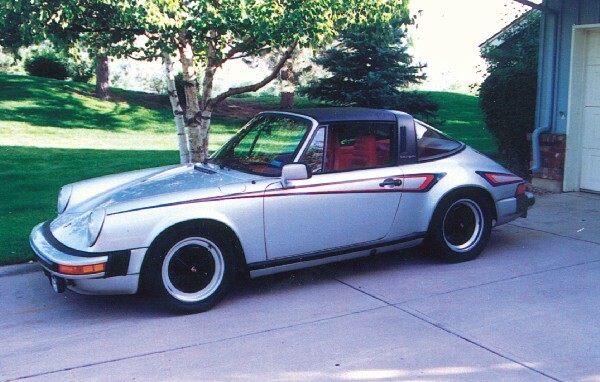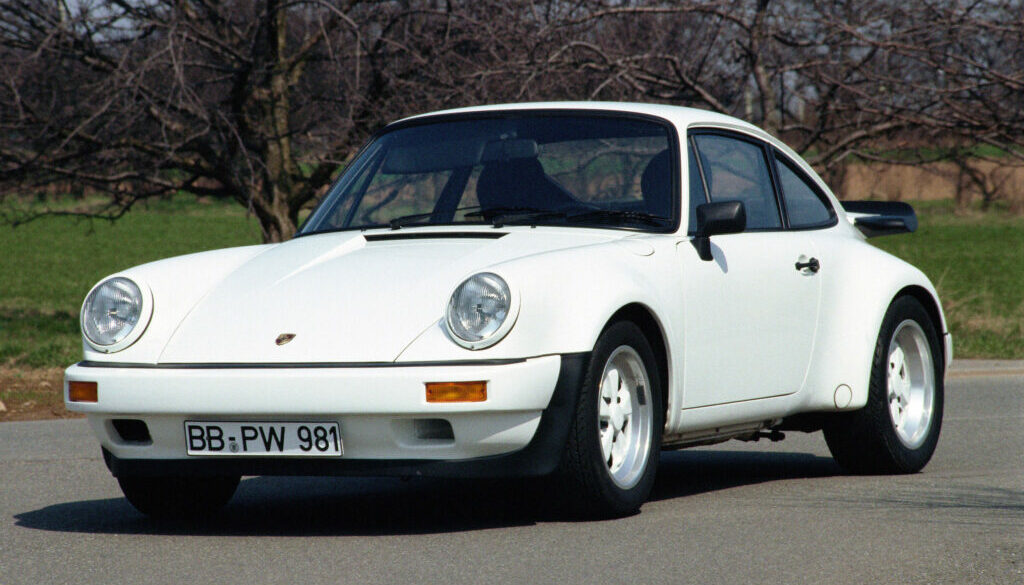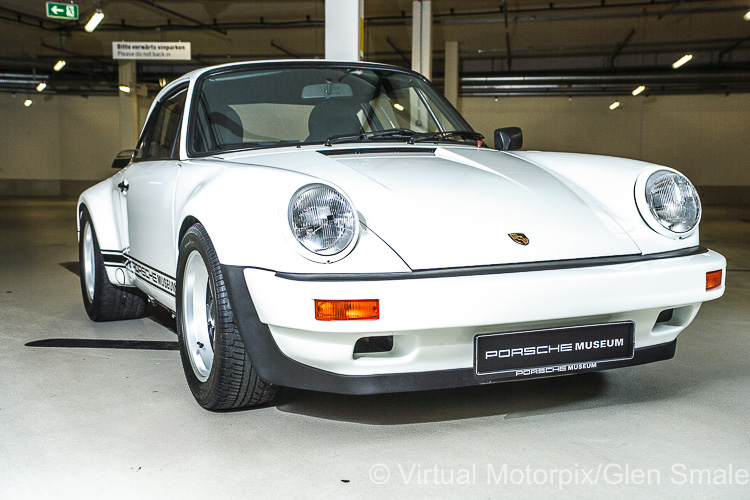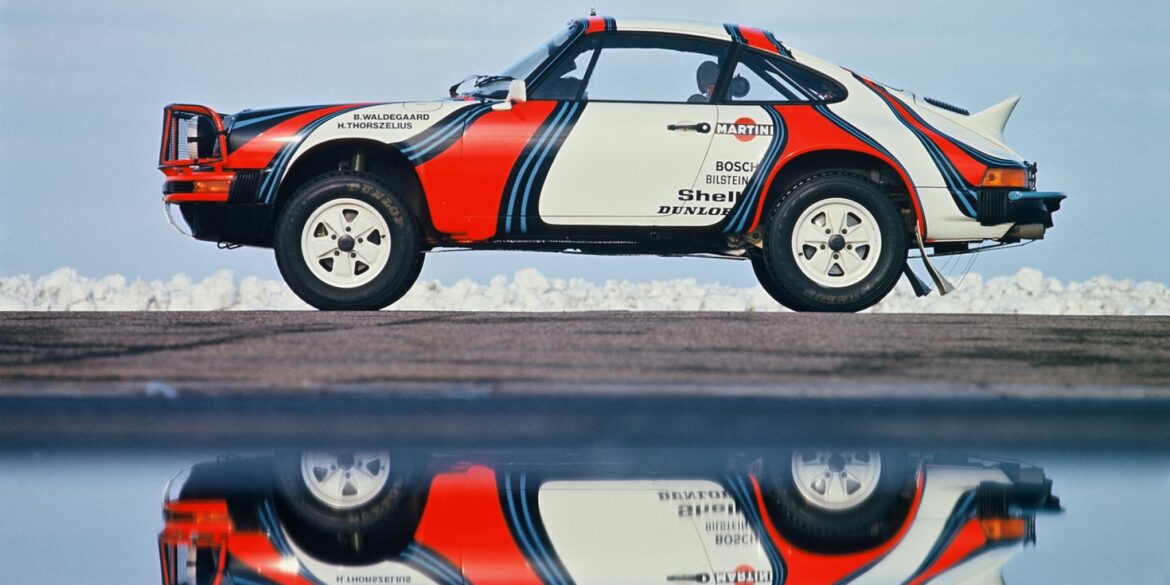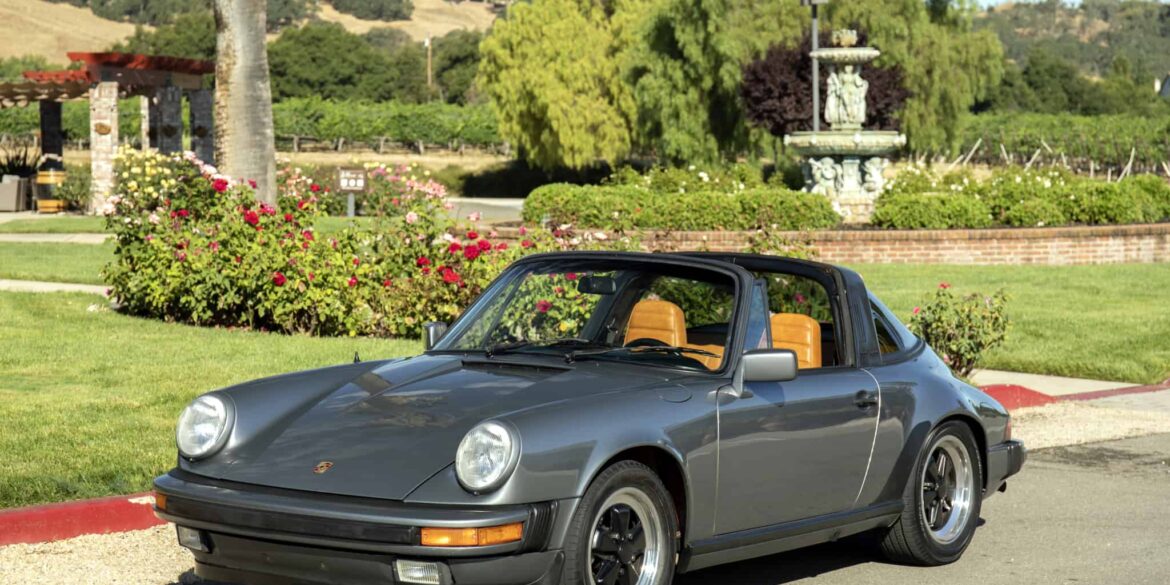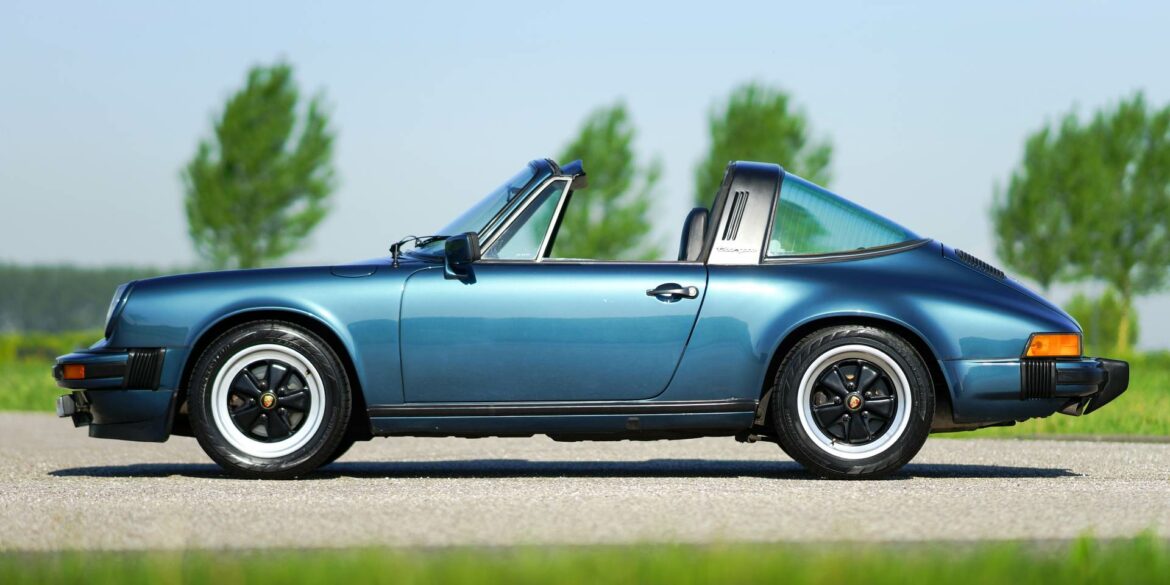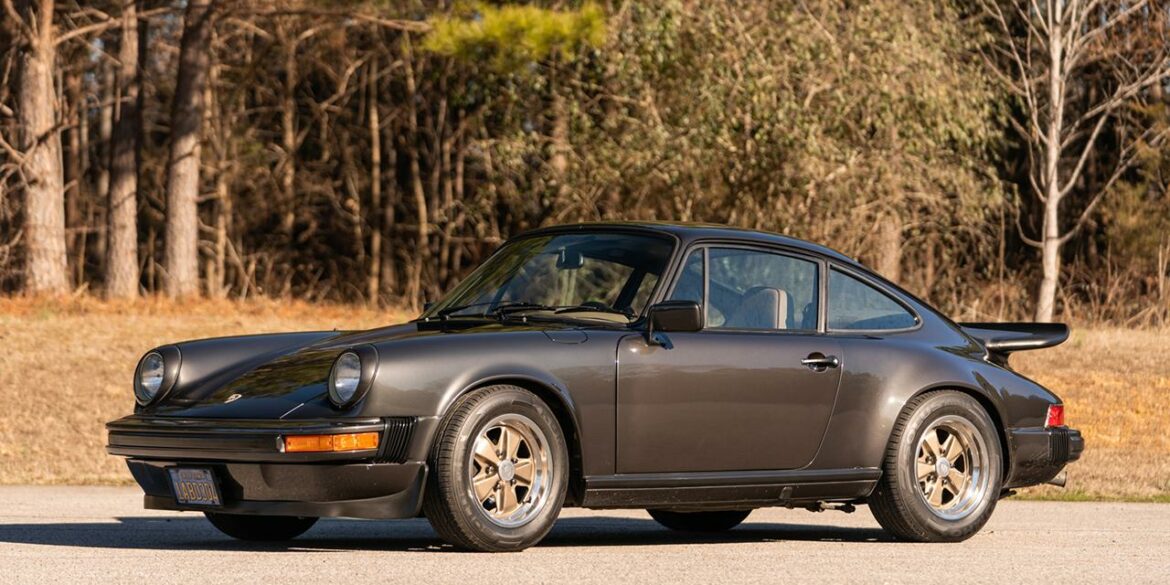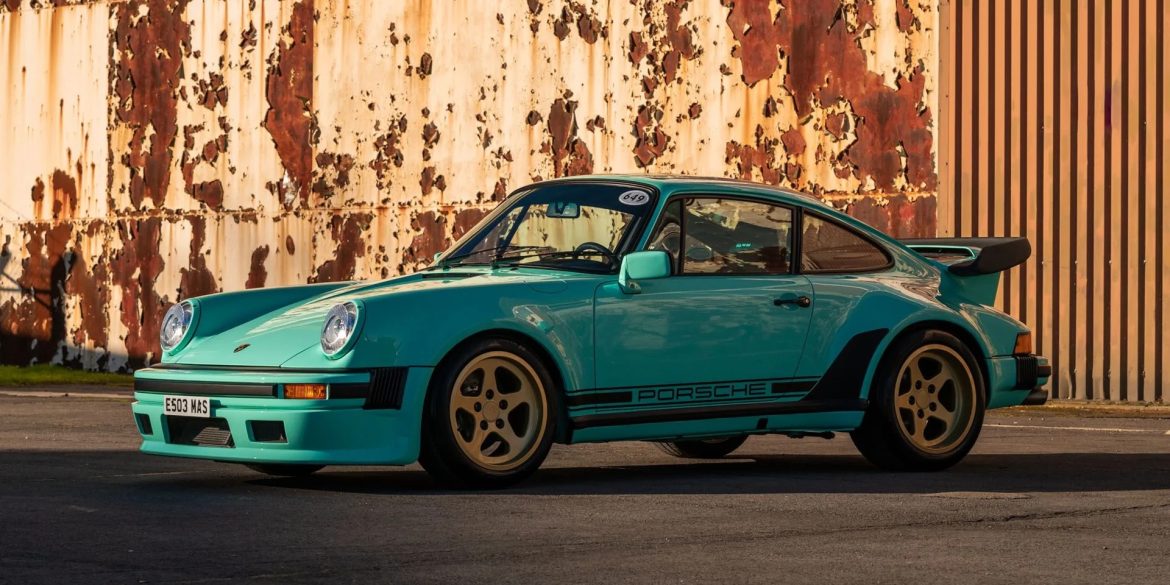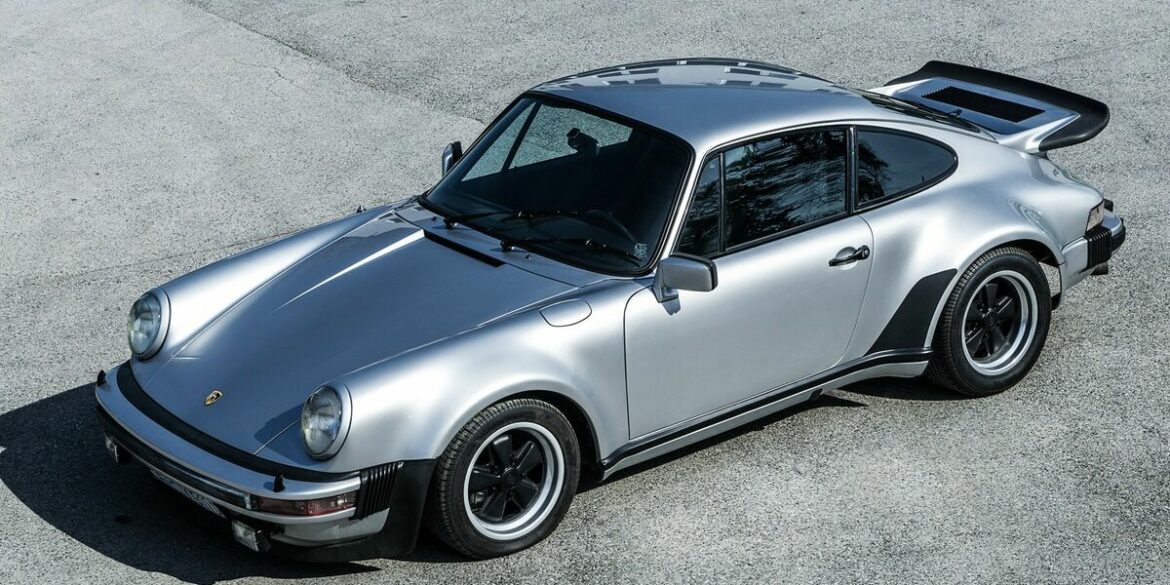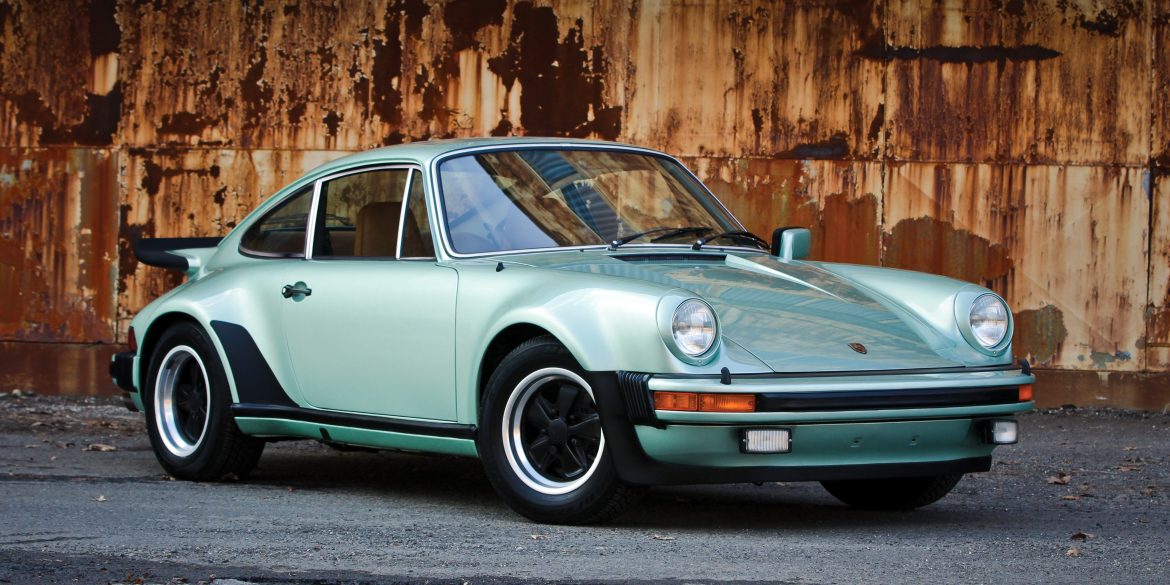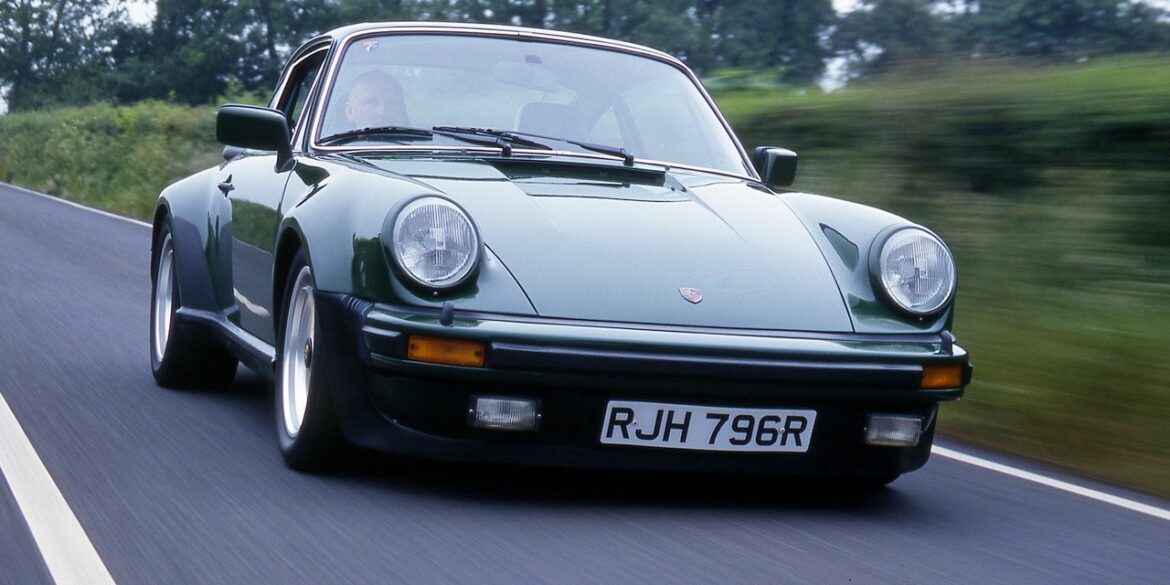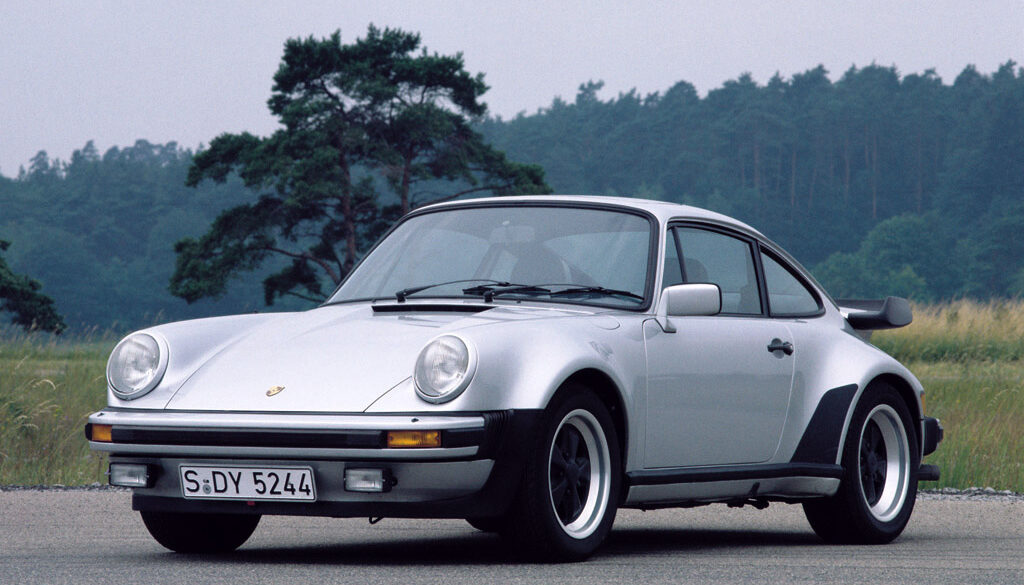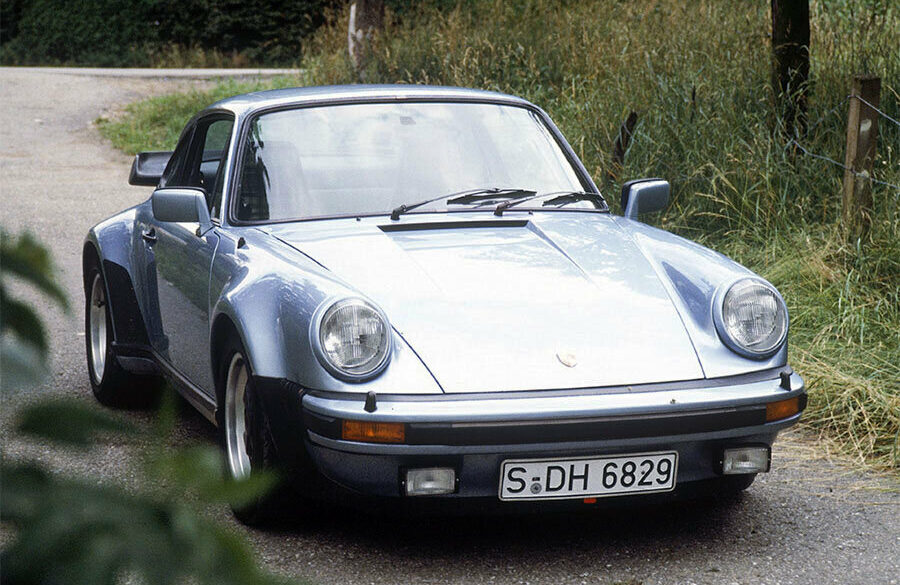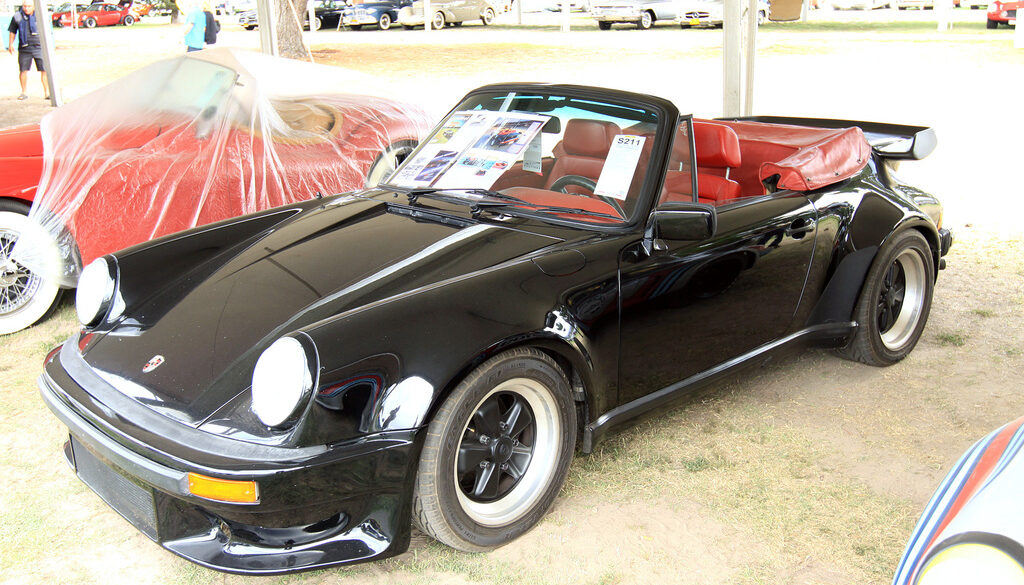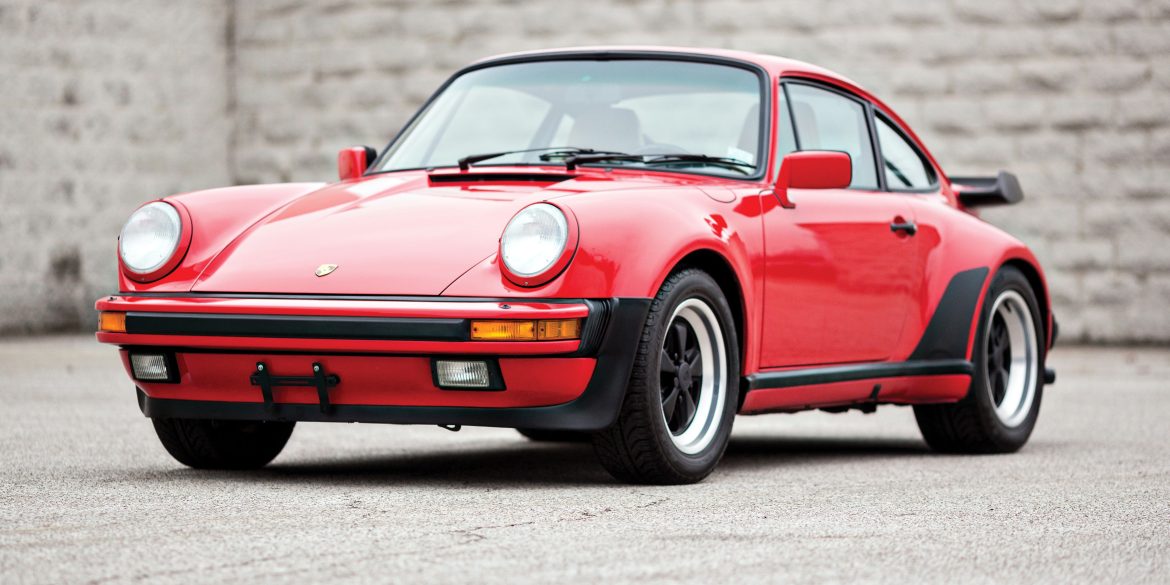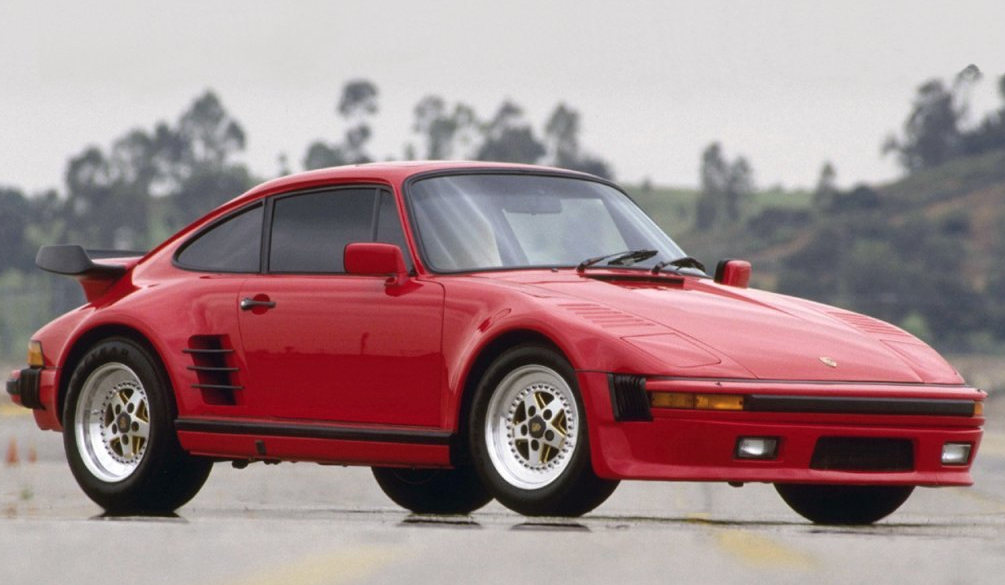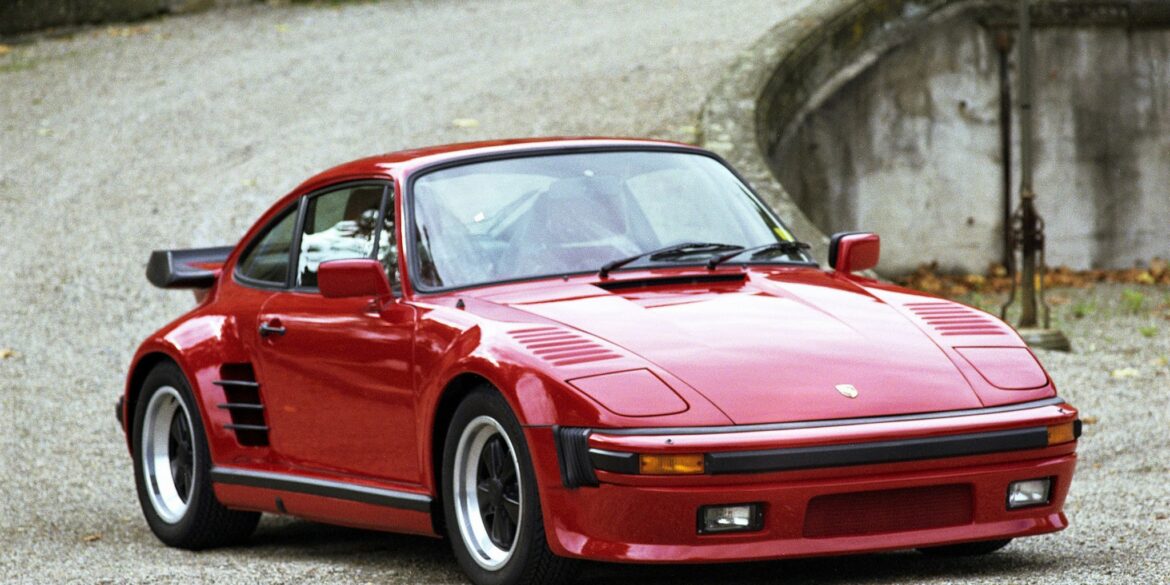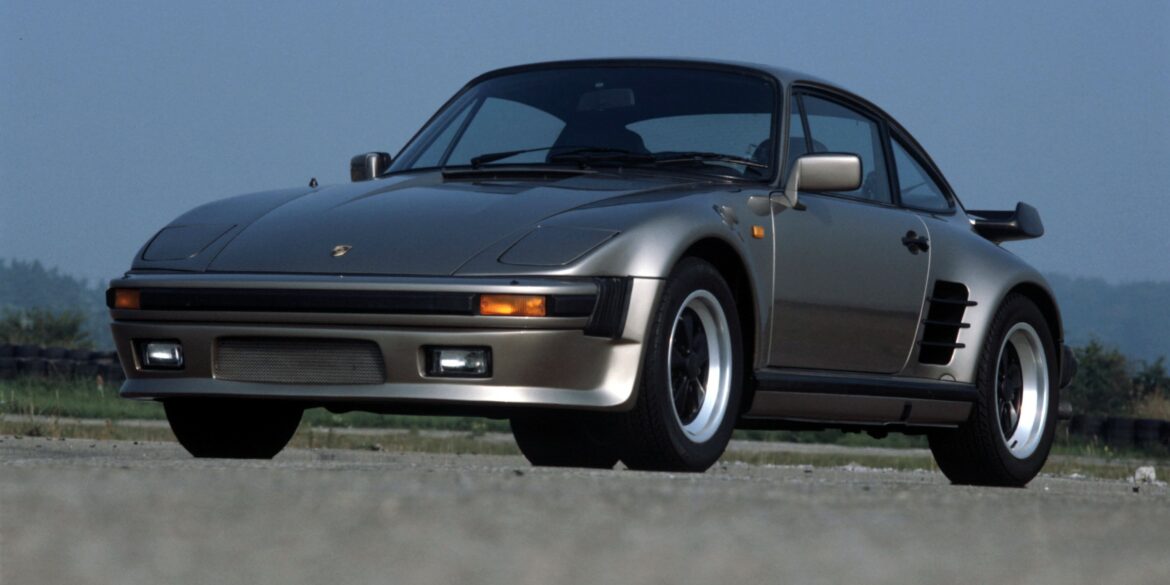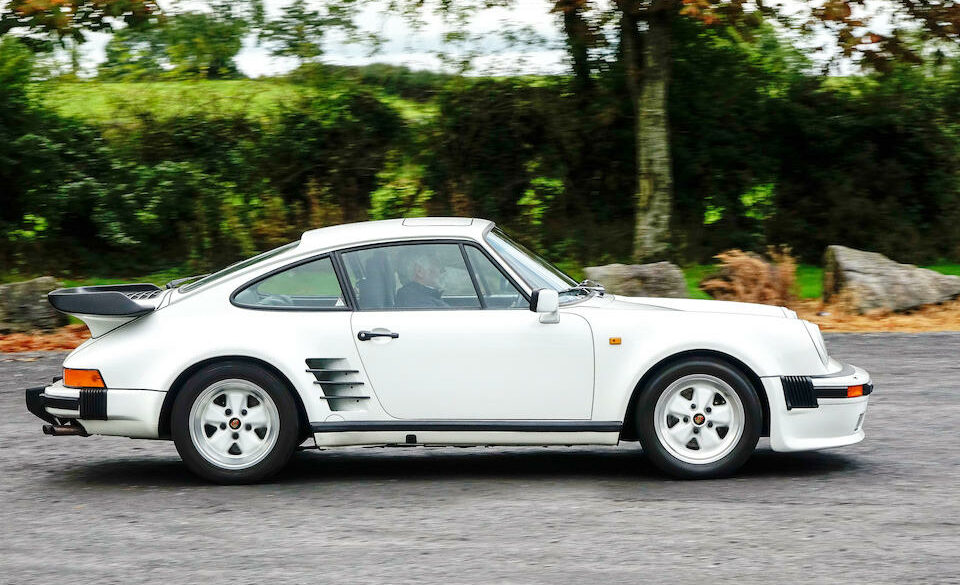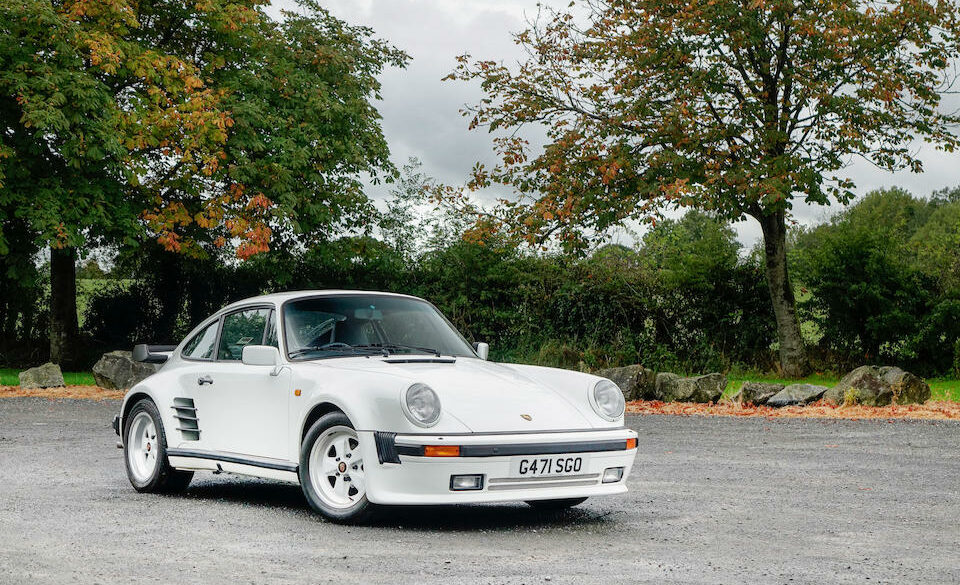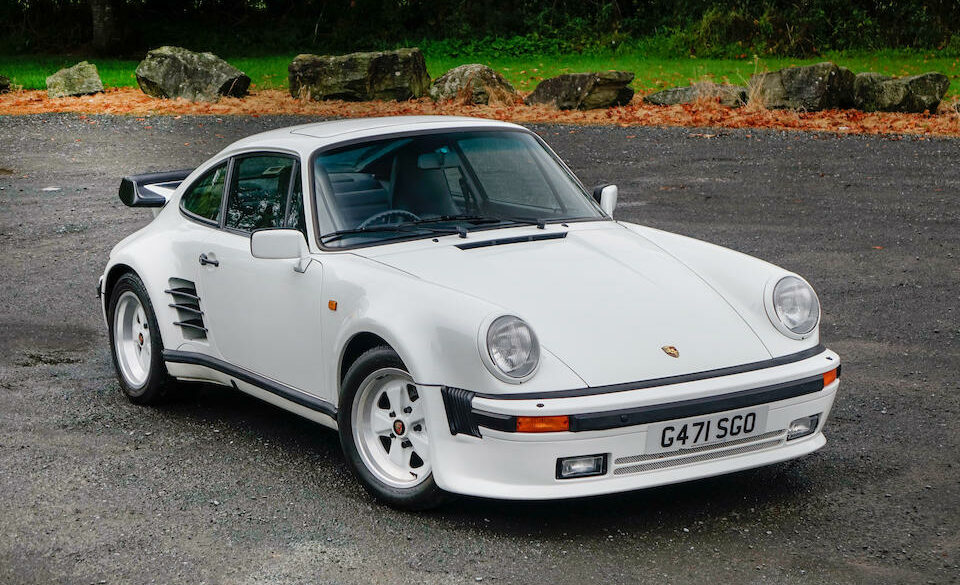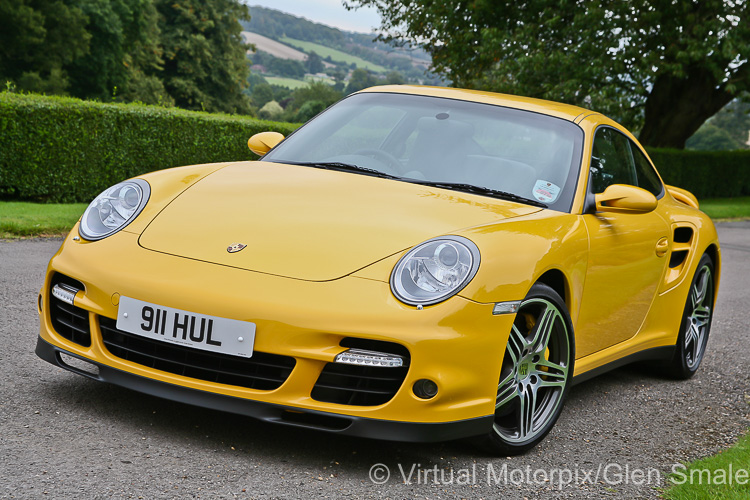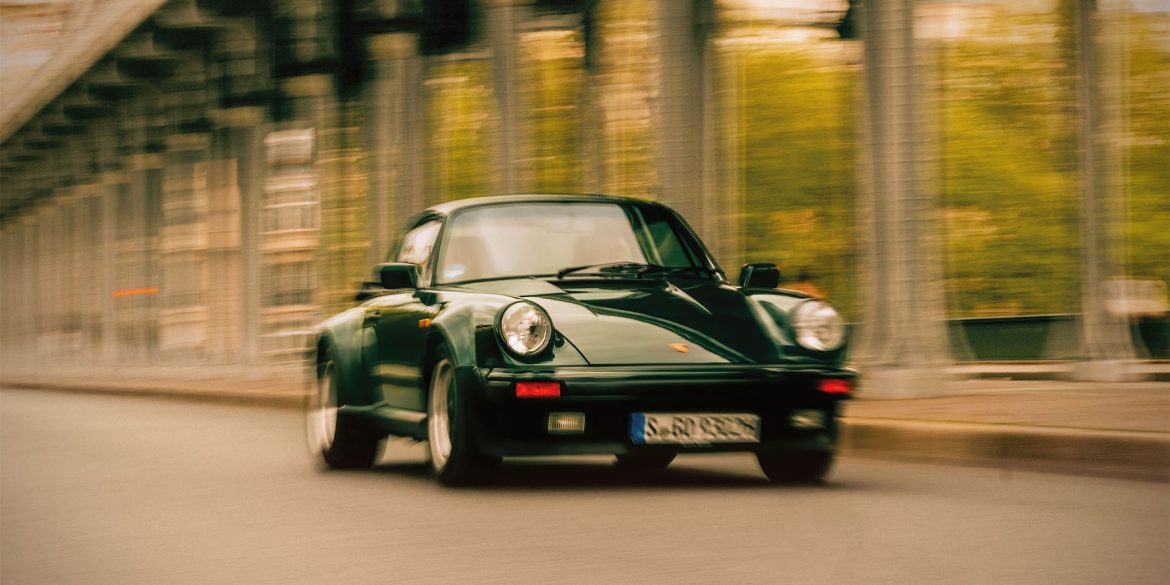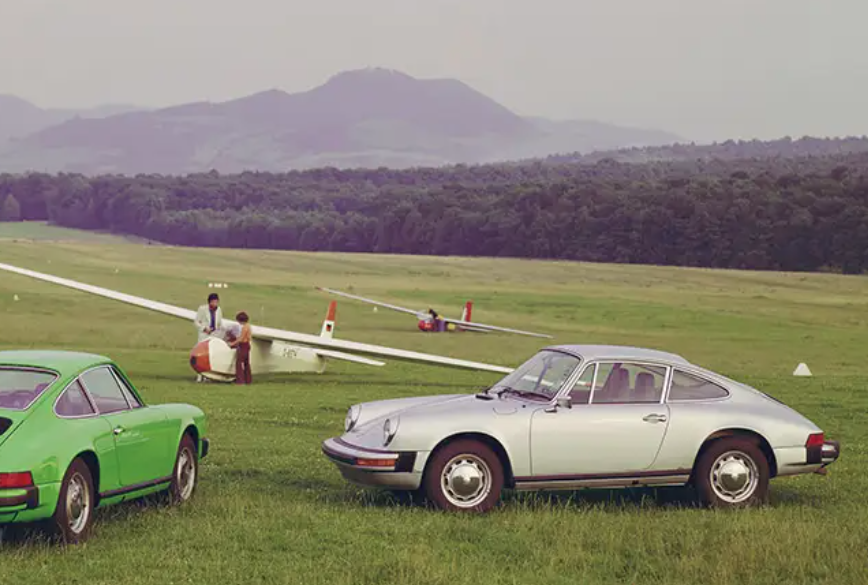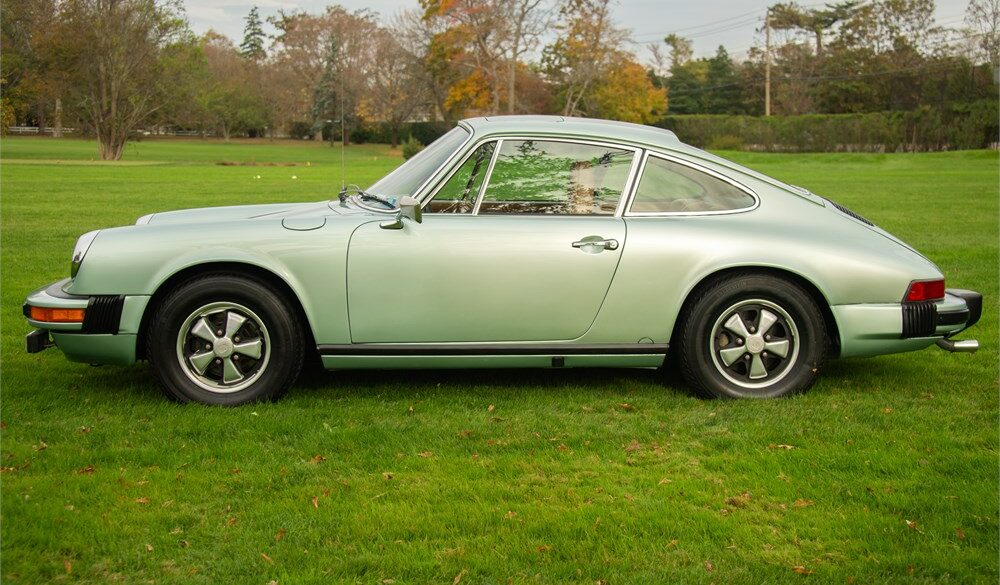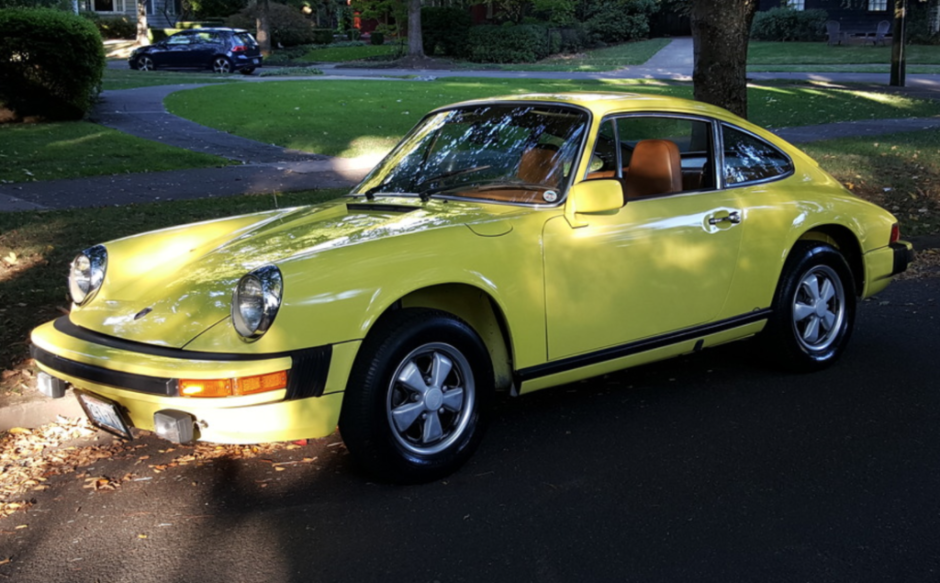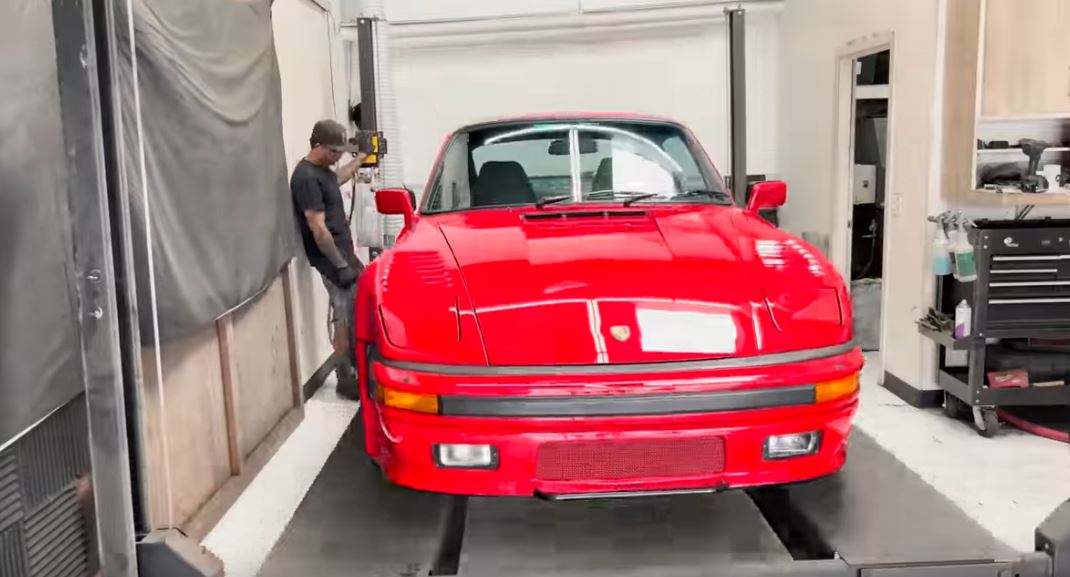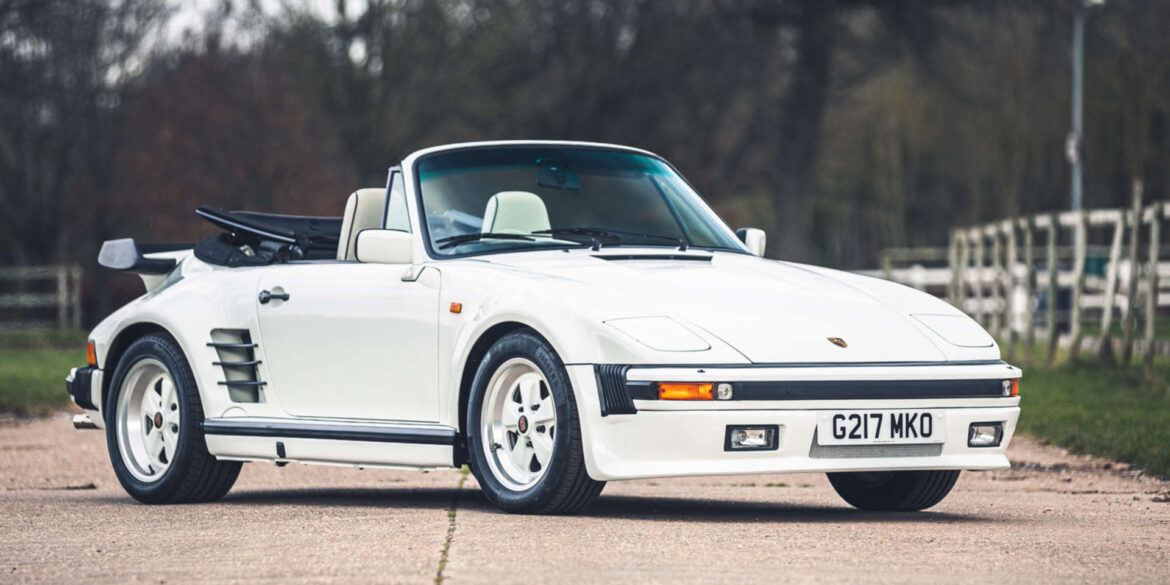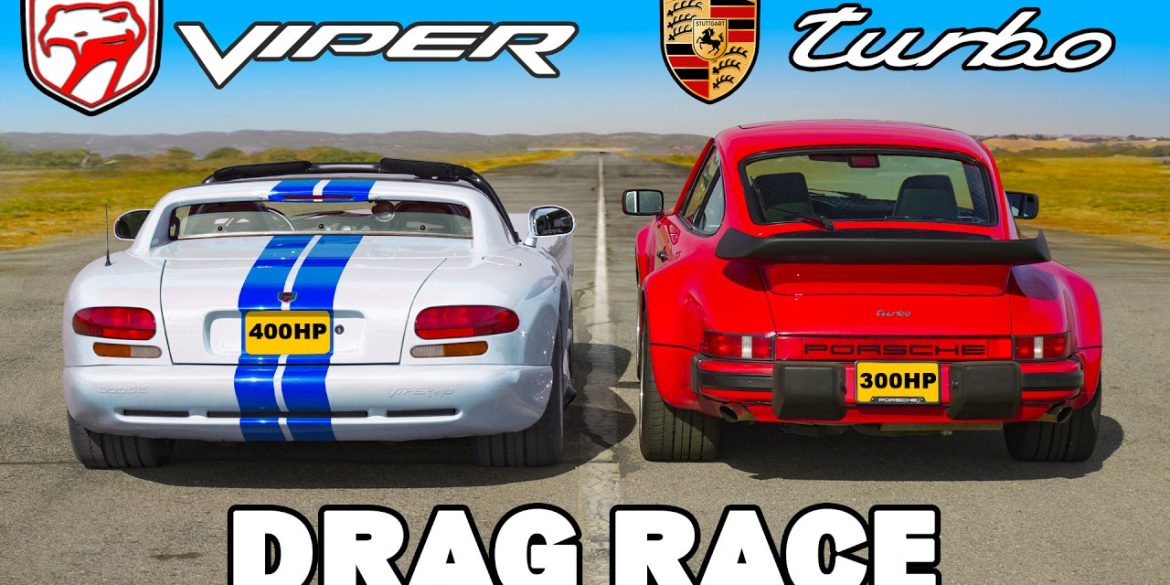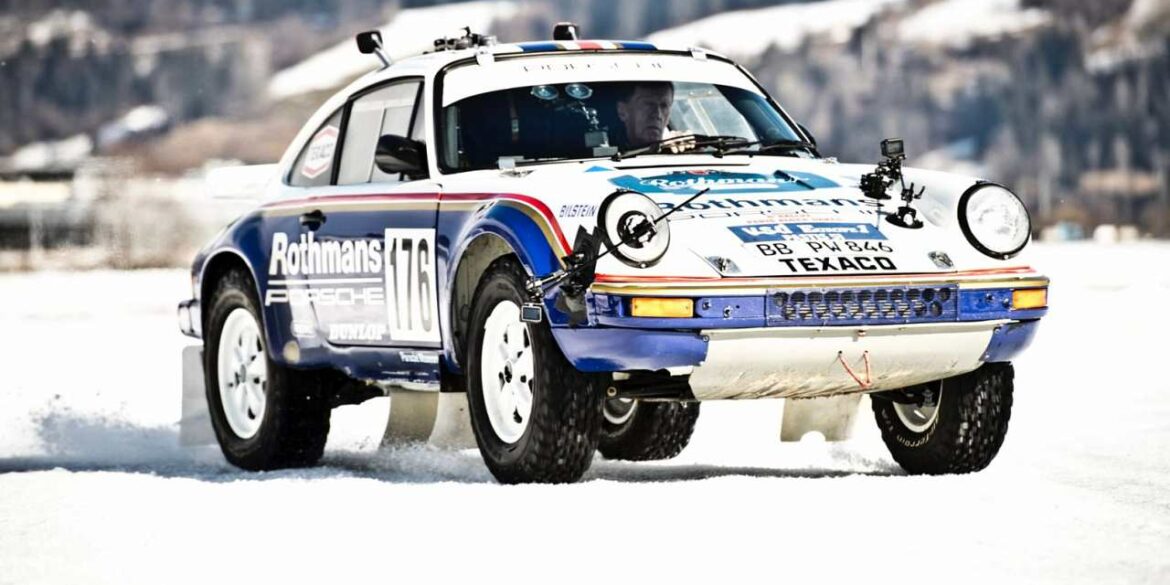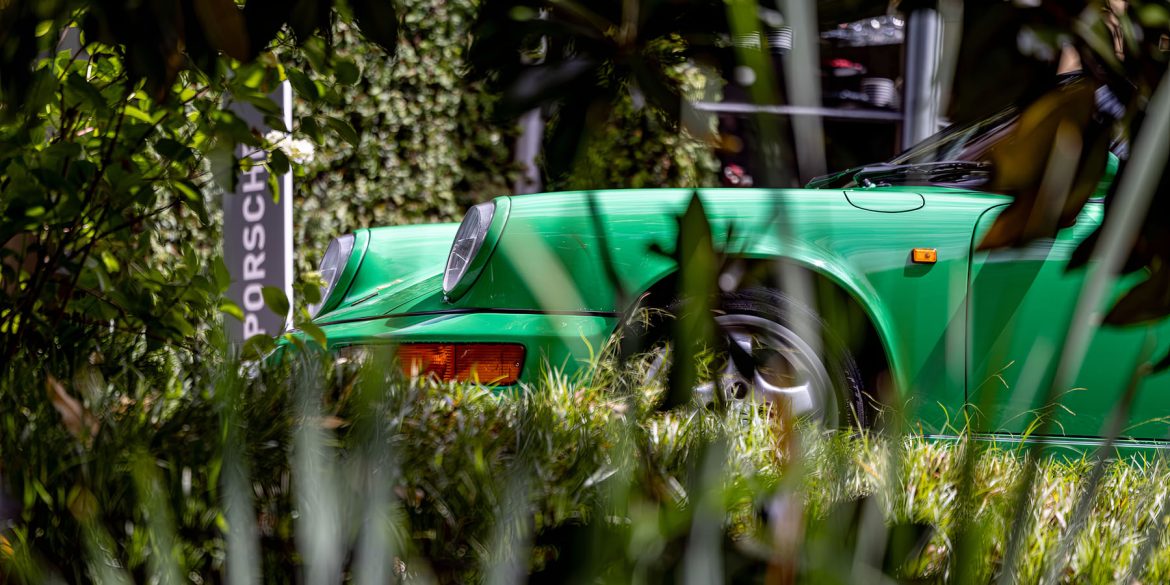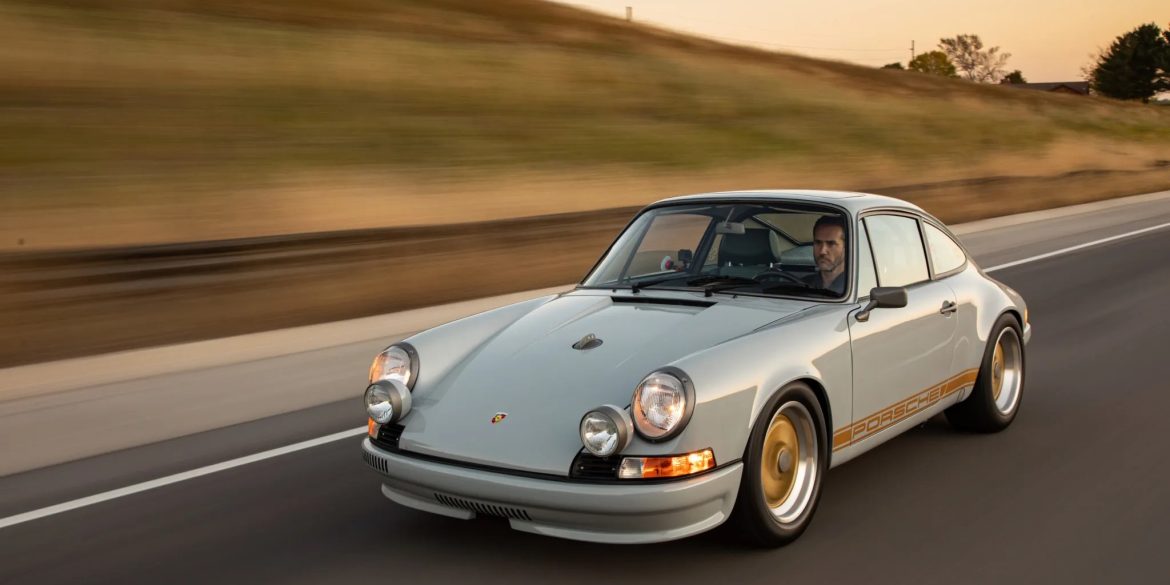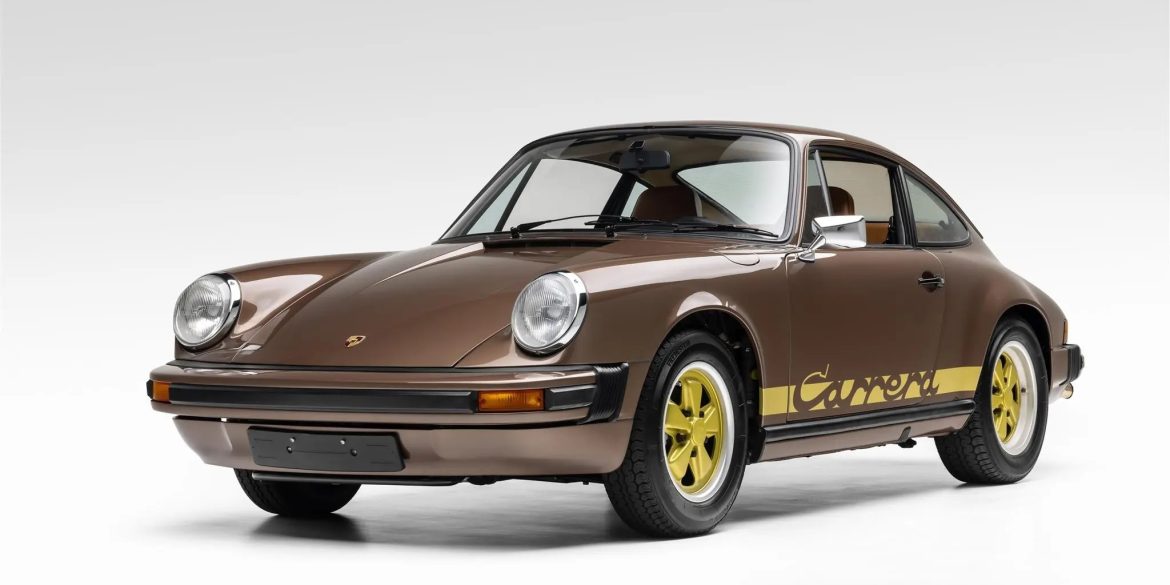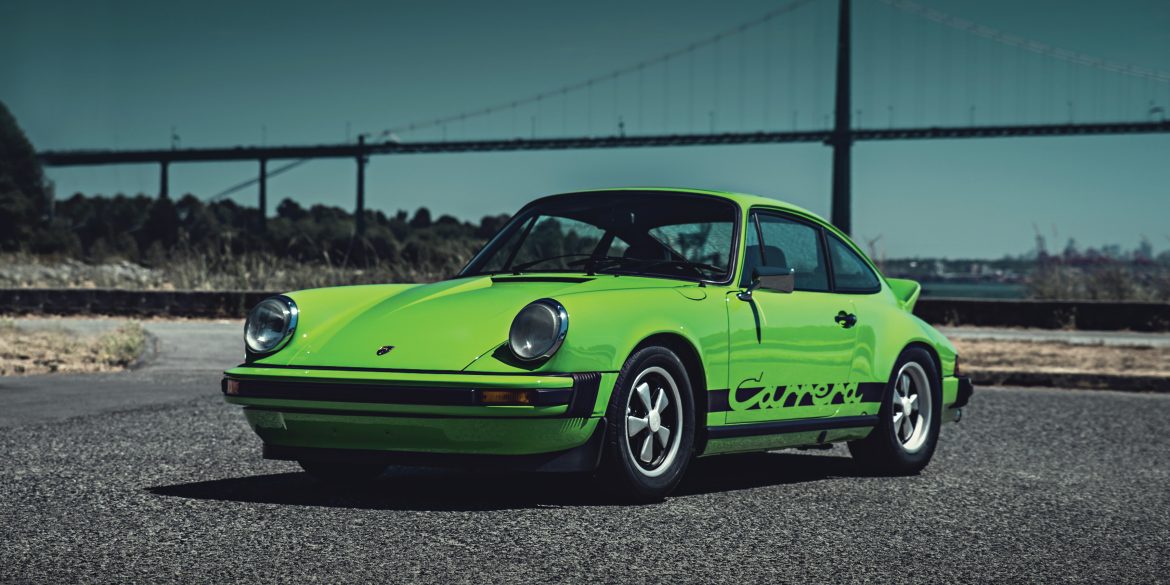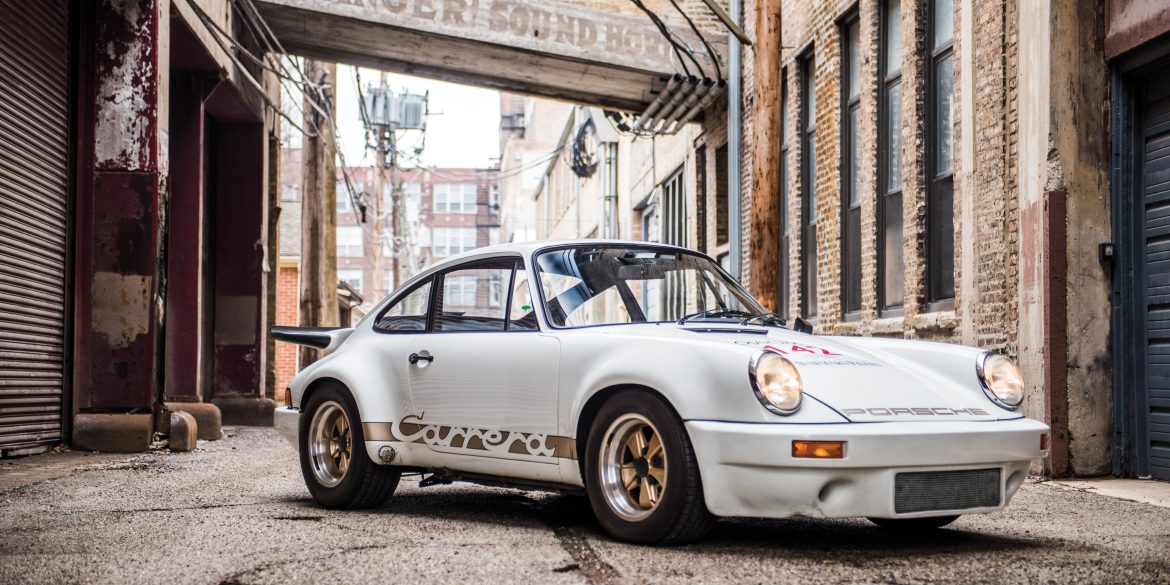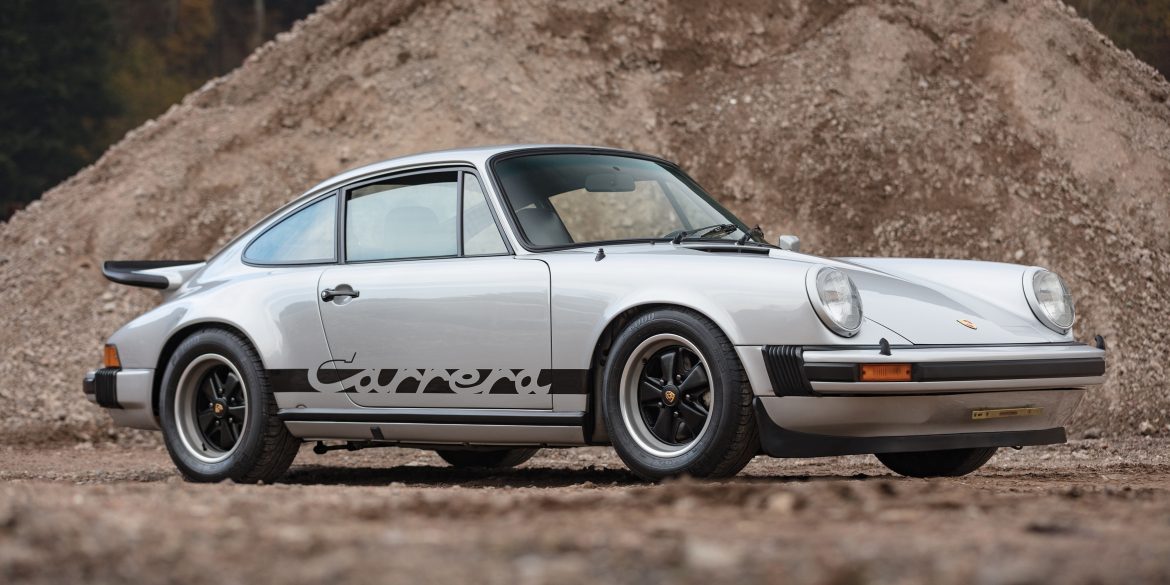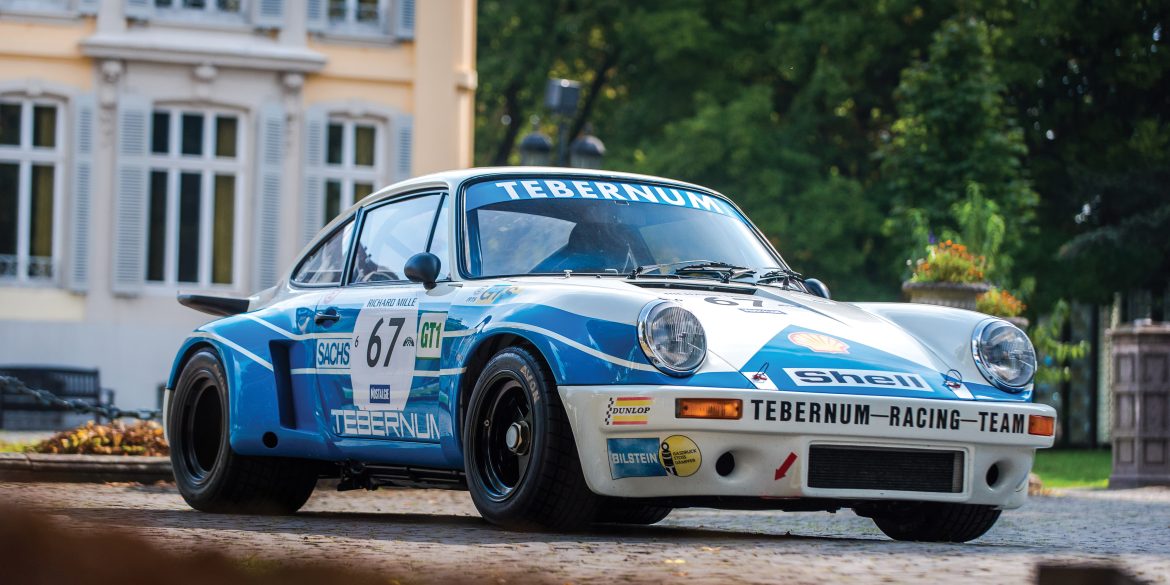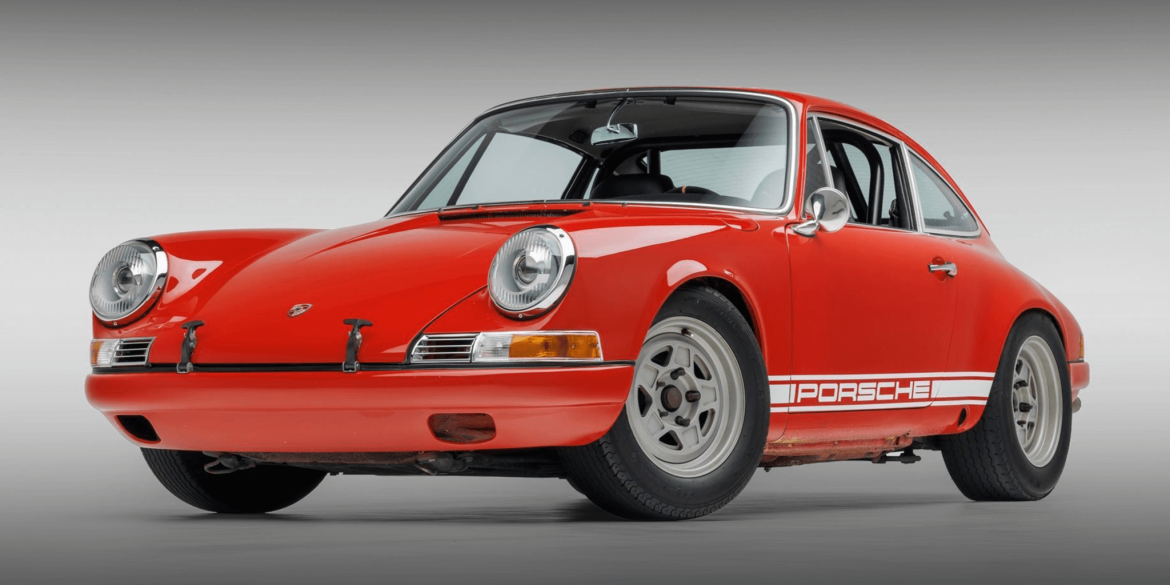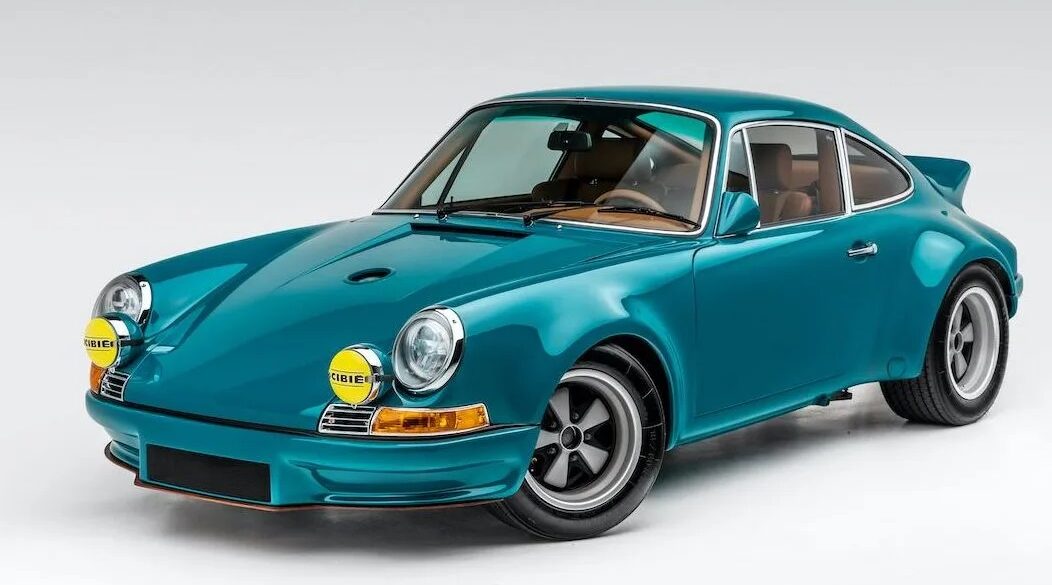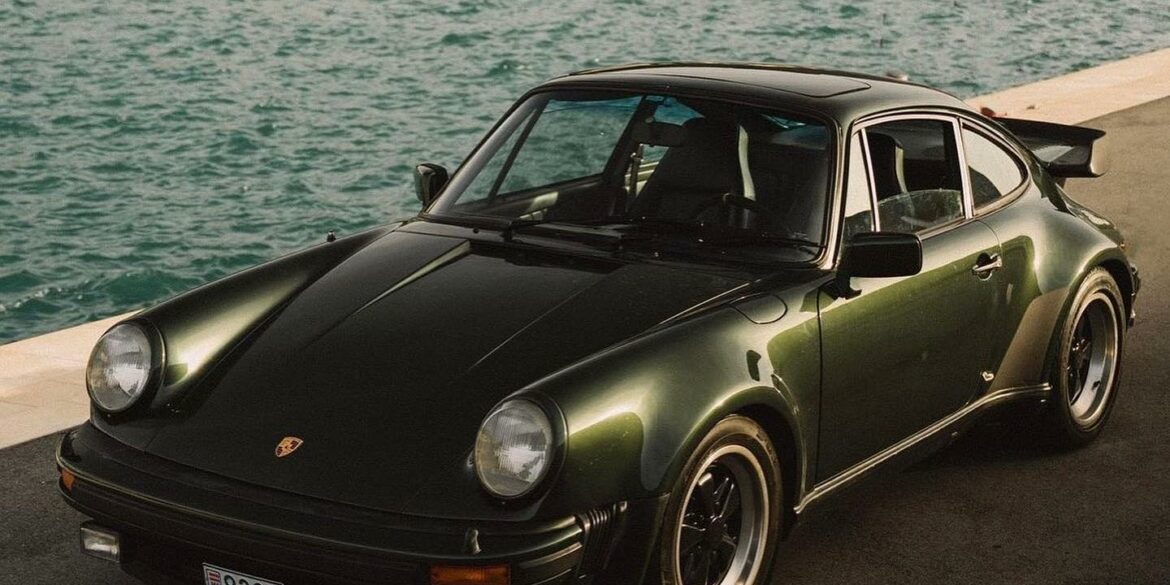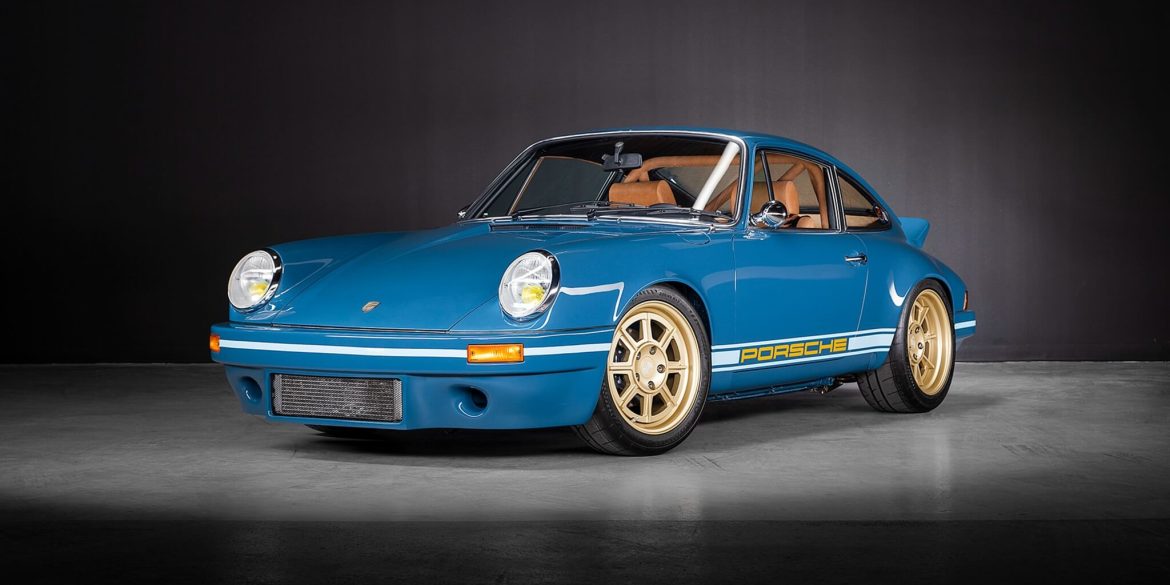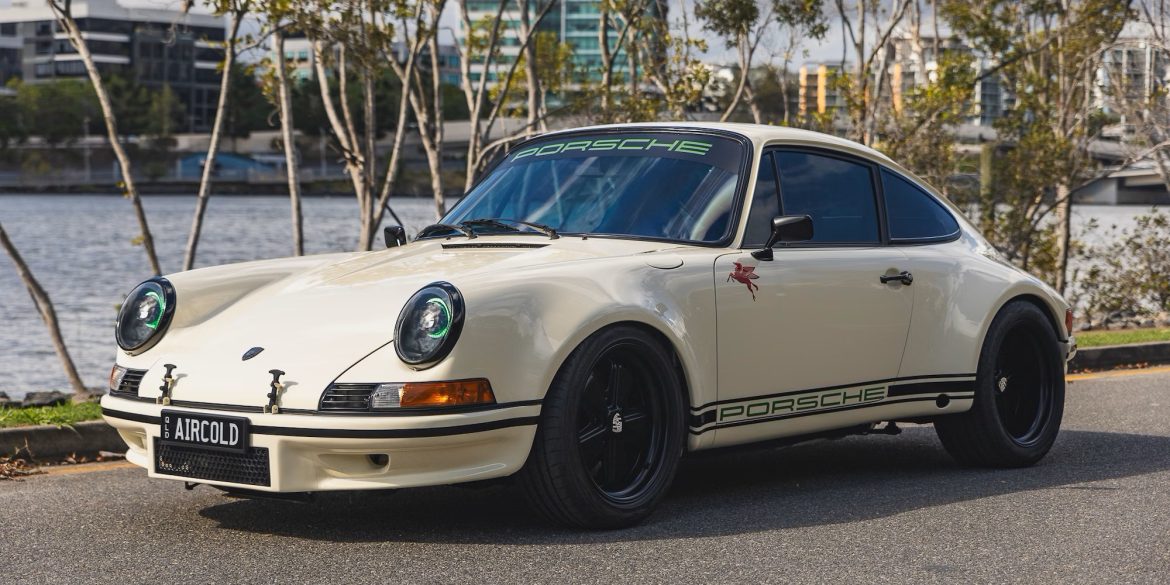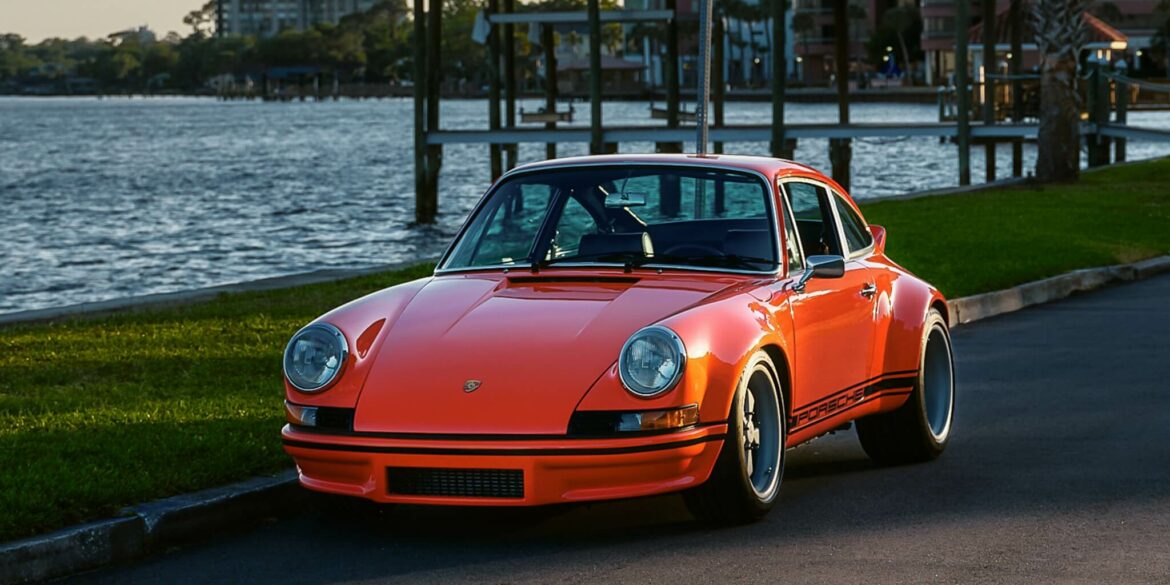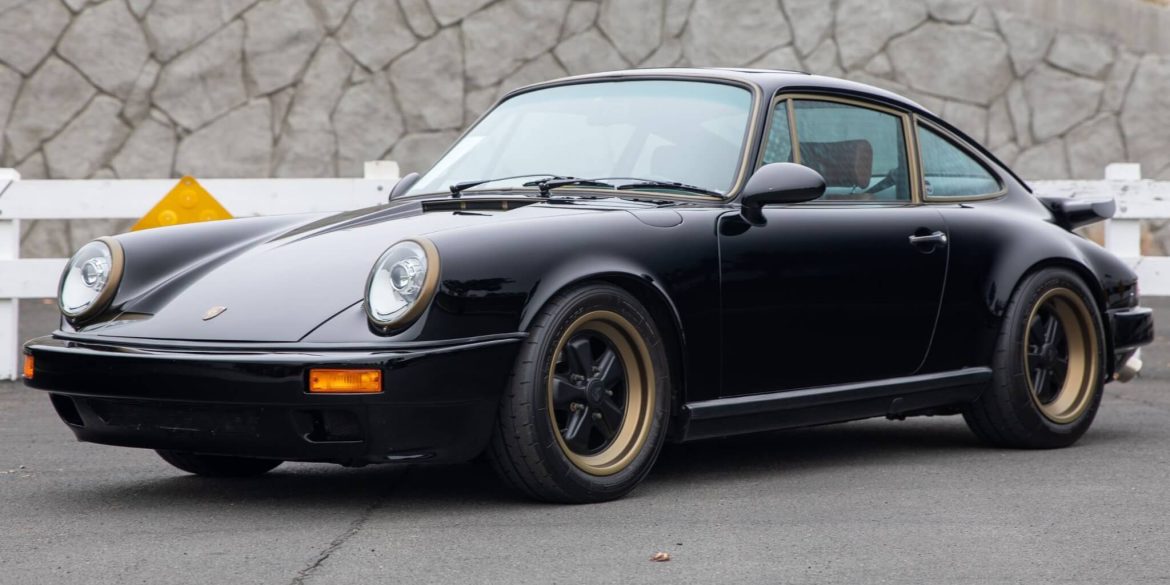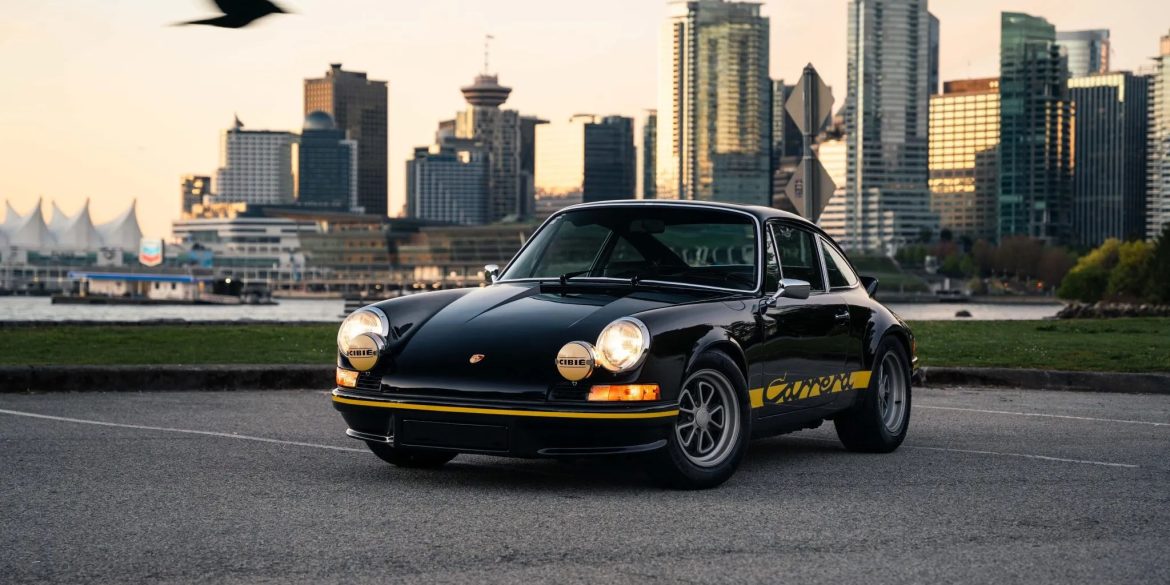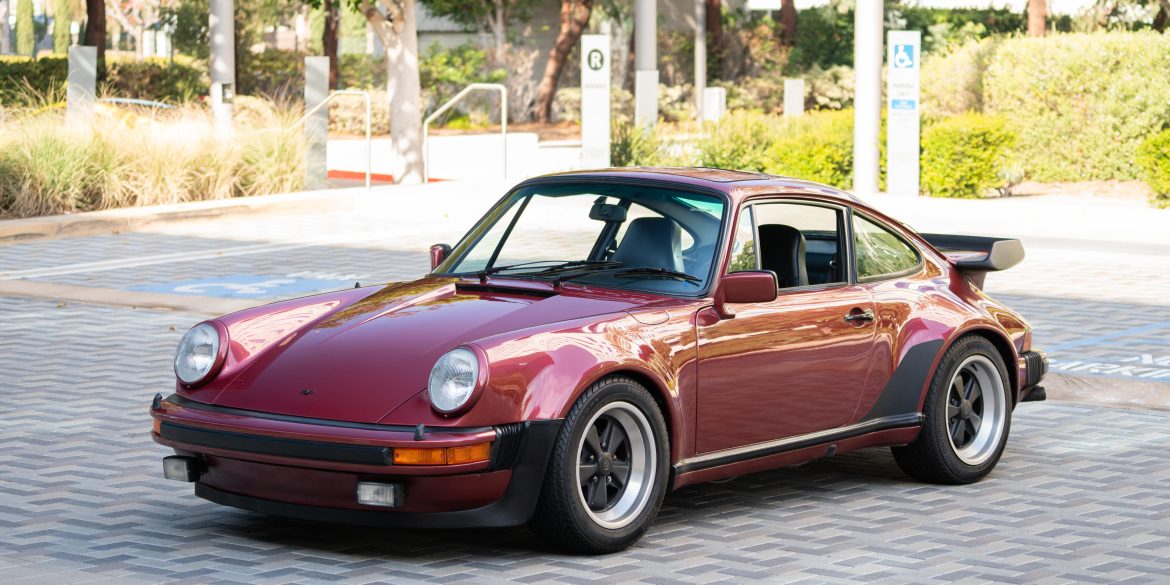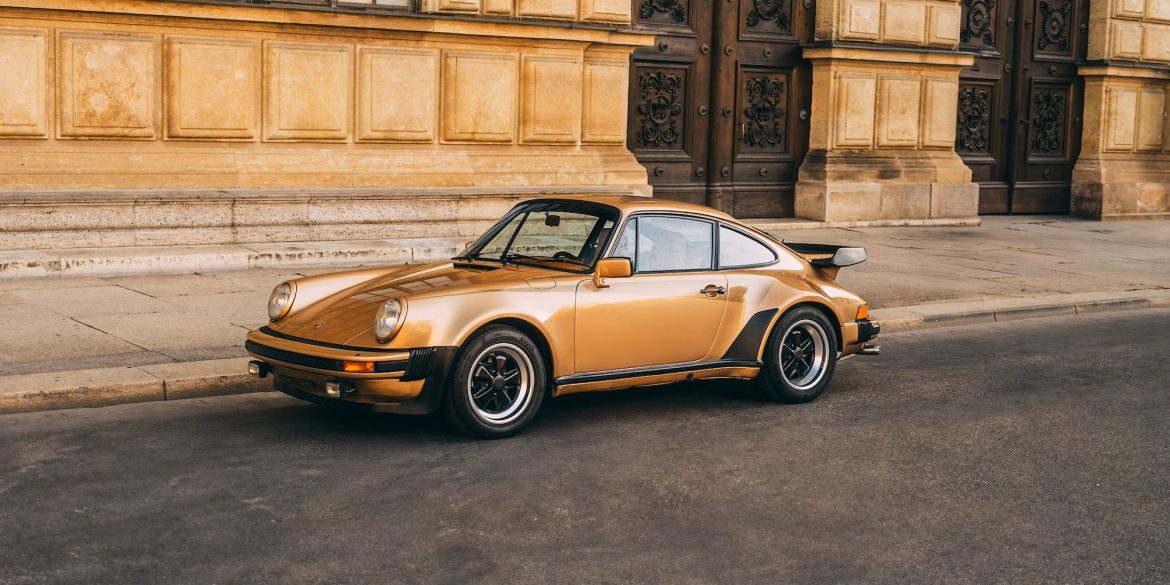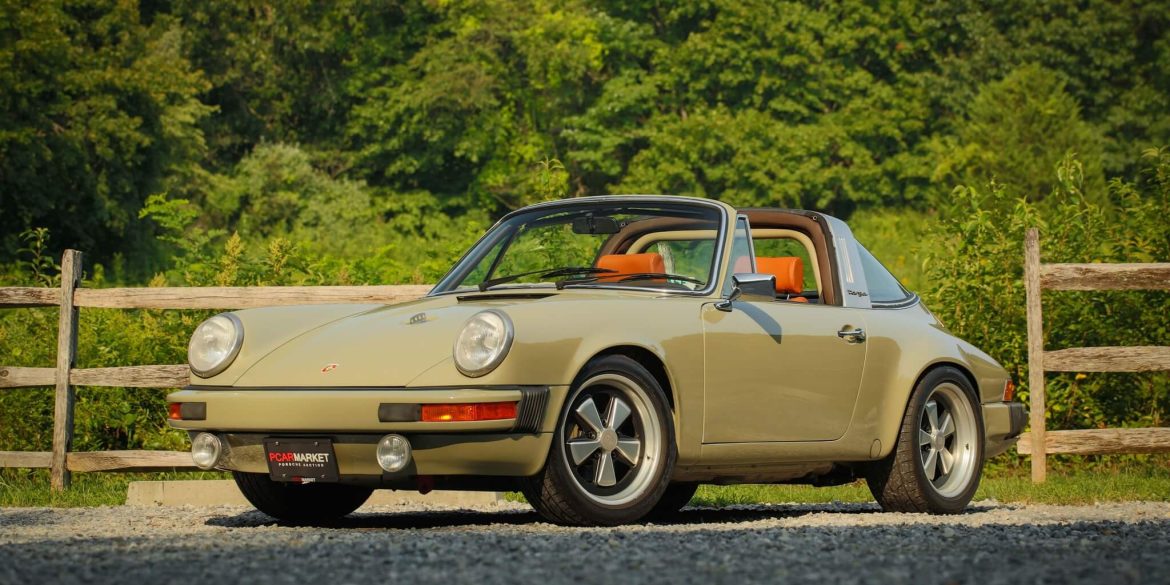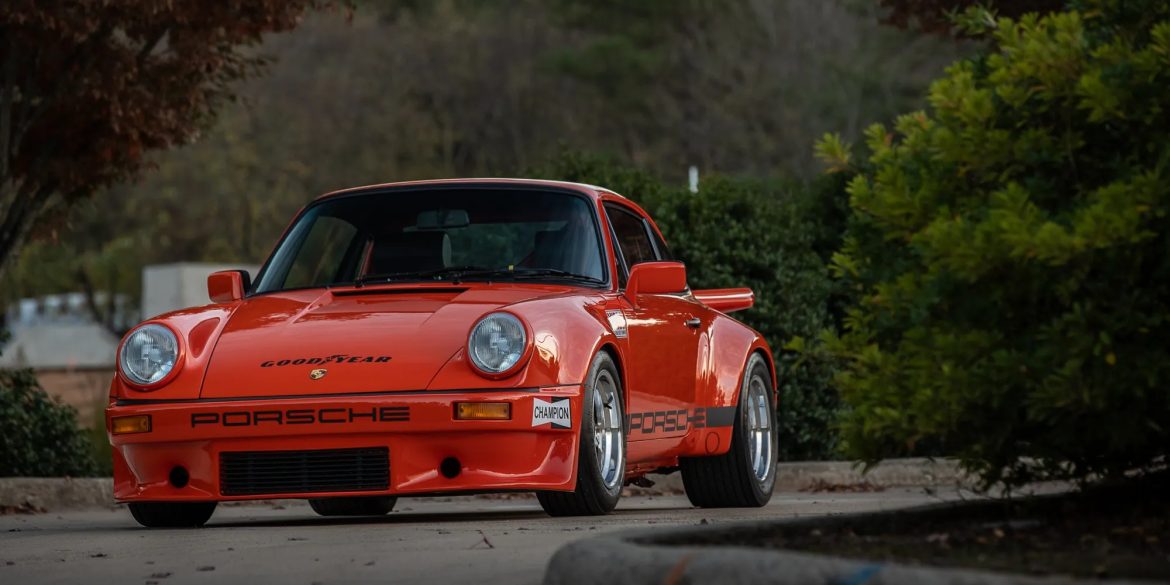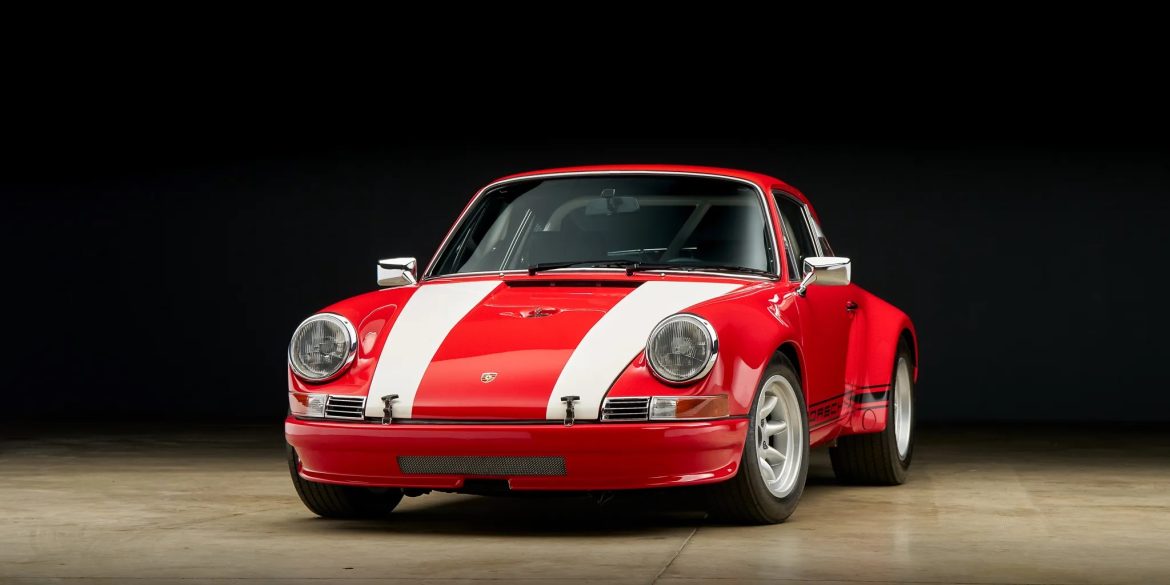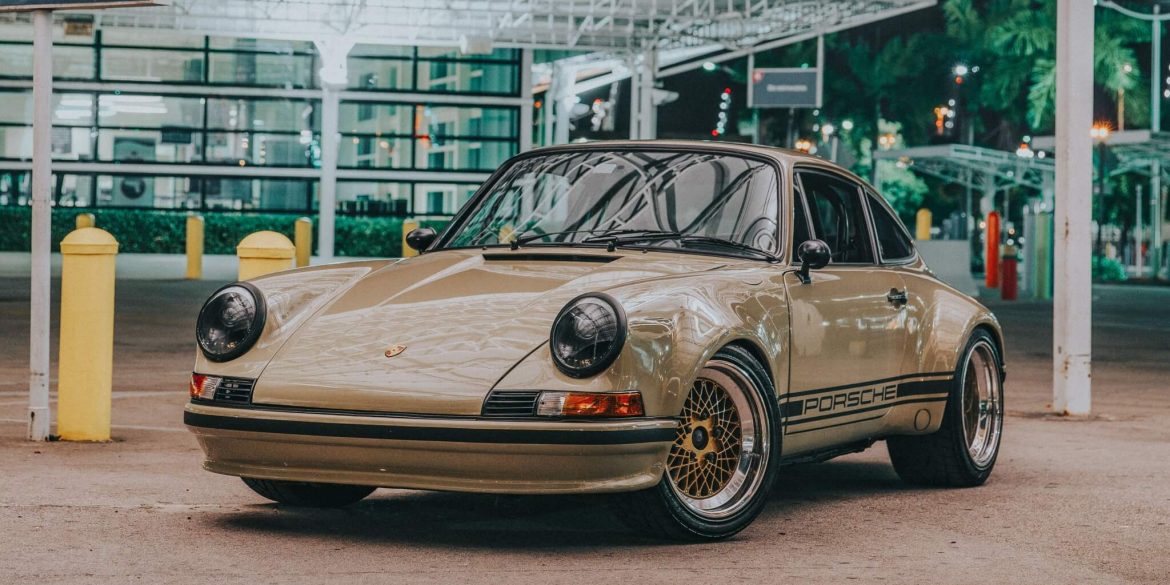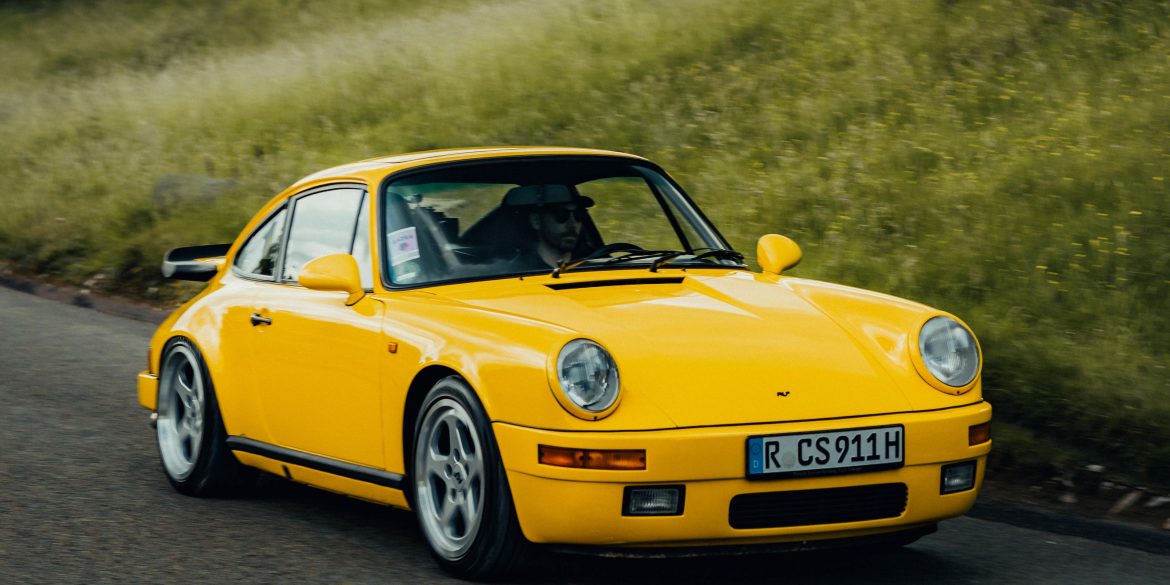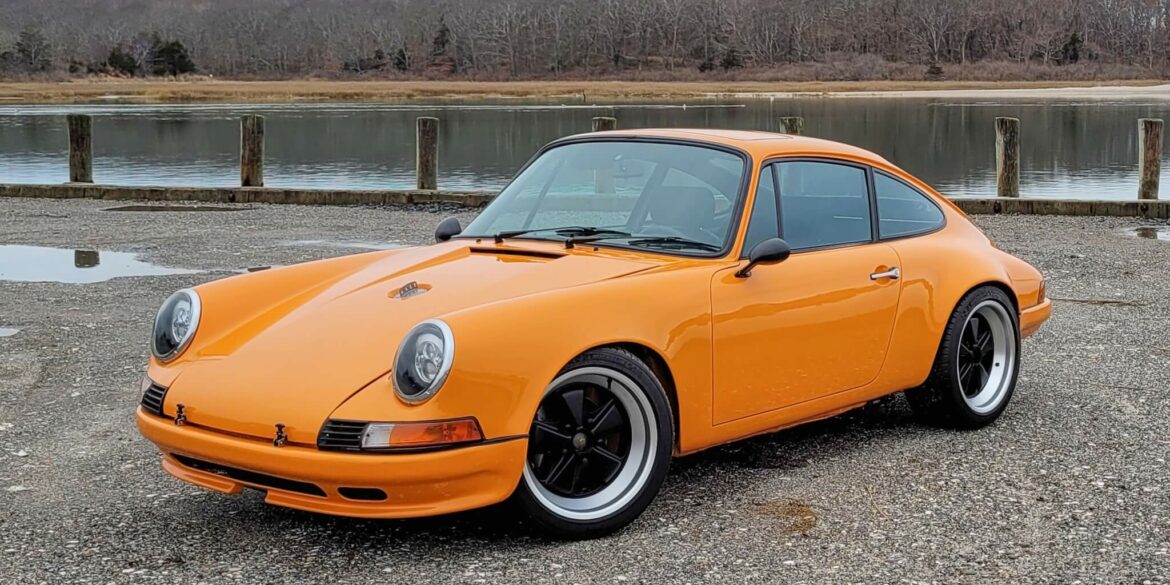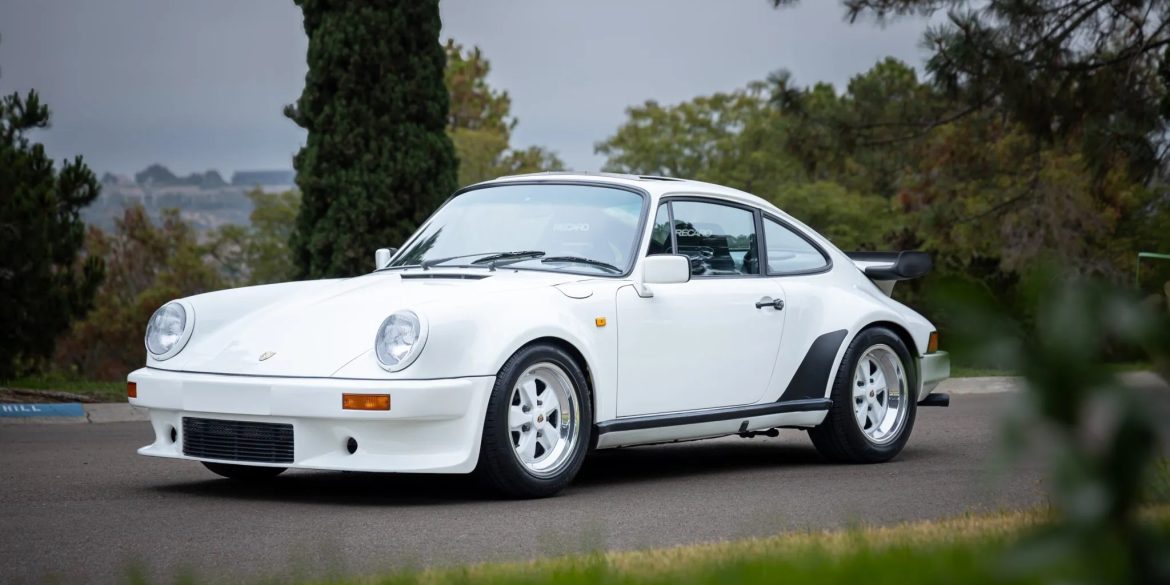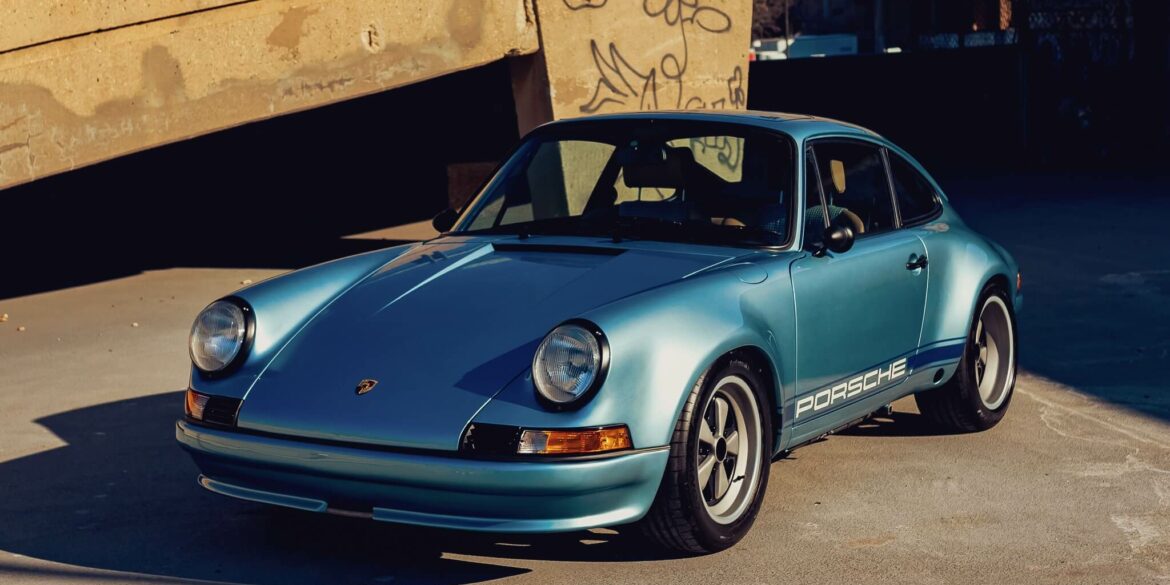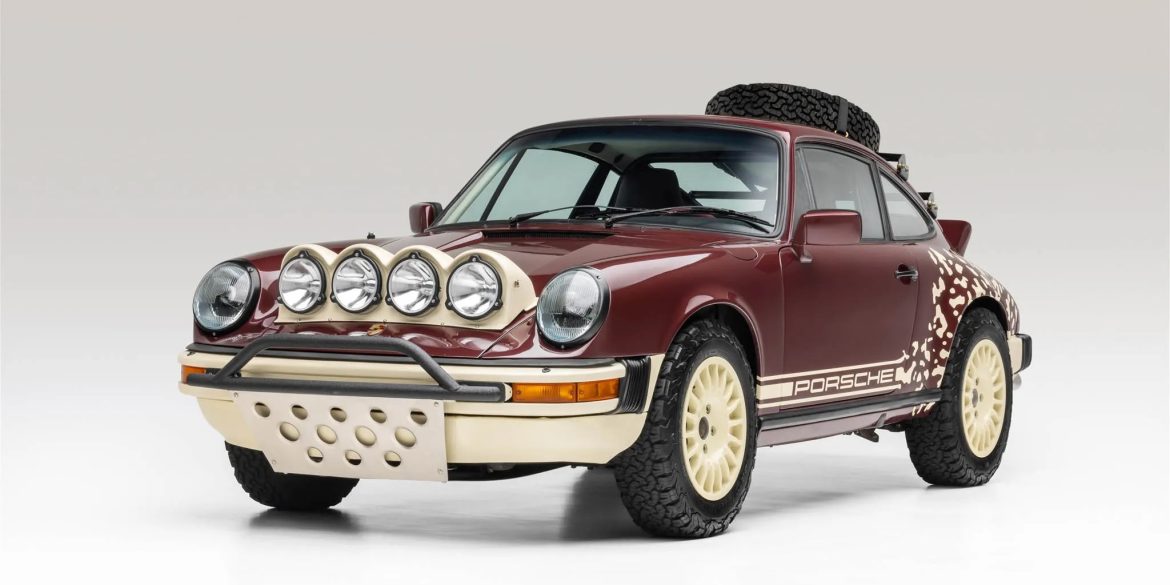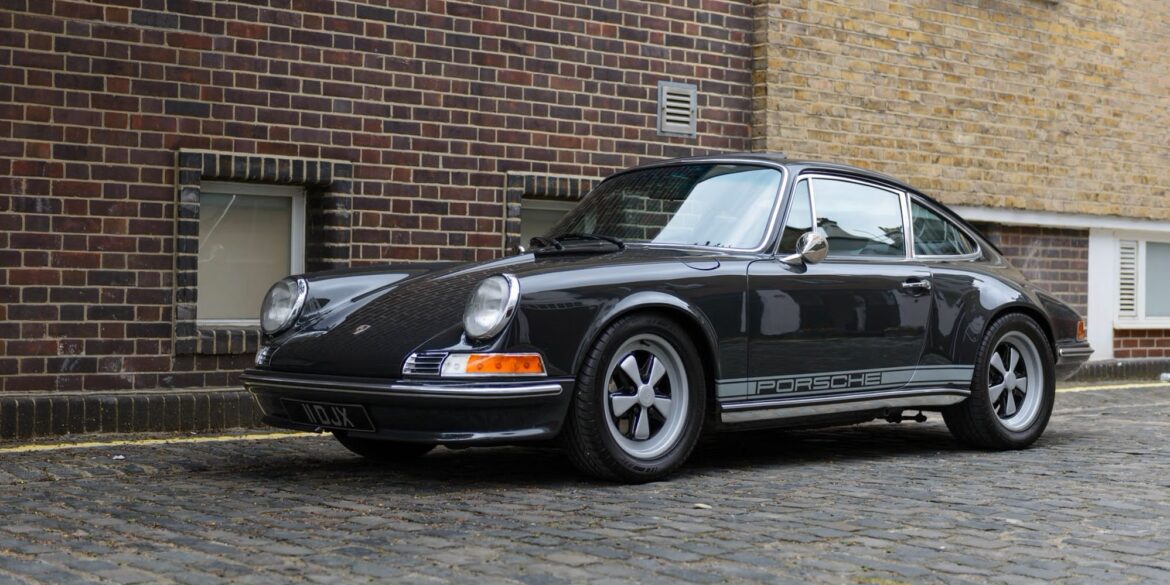For 1989, Porsche produced the 25th Anniversary Special Edition model to mark the 25th year of 911 production. The 1989 Porsche brochure lists production of 500 U.S. market cars, of which 300 were coupés (240 in silver metallic paint and 60 in satin black metallic), and 200 cabriolet models (160 in silver and 40 in black). All had "silk grey" leather with black accent piping and silk grey velour carpeting. Includes small bronze "25th Anniversary Special Edition" badges.
Porsche 911 (G-Series)
The Porsche 911 G model was a true perennial and was built for a full 17 years. During this time, engines were built with 2.7, 3.0 and 3.2 liters. The narrow G-model (from 1974 to 1977) over the 911 SC, the Carrera 3.0 to the Carrera 3.2 gave it a large variety of variants, colors and equipment. The G-Body saw the introduction of impact bumpers to conform with low speed protection requirements of U.S. law, these bumpers being so successfully integrated into the design that they remained unchanged for 15 years. In 1974 the engine size was increased to 2,687 cc, giving an increase in torque. The use of K-Jetronic CIS Bosch fuel injection in two of the three models in the line up – the 911 and 911S models, retaining the narrow rear wings of the old 2.4, now had a detuned version of the RS engine producing 150 and 175 bhp (110 and 129 kW) respectively. See all of our G-Body (2nd Gen 911) Research.
All
- 911 (G-Series)
- 911 Carrera 3.0 (G-Series)
- 911 S (G-Series)
- 911 SC (G-Series)
- 911 Carrera 3.2 (G-Series)
- 911 SC Safari
- 911 Turbo (930)
- 911 Carrera RSR Turbo 2.1
- 911 Carrera RSR 3.0
- 911 SC San Remo
- 911 Carrera 3.2 Clubsport
- Porsche 953
- 911 Carrera 25th Anniversary
- 911 Carrera RS 3.0
- 911 SC RS
- 911 Turbo LE
- 911 3.2 Speedster
- 911 Carrera 2.7 (G-Series)
- 911 Carrera Commemorative
- 911 Turbo 2.7
- Porsche 954
As a successor to the Carrera 2.7 MFI, the Carrera 3.0 was fitted with a variation of the 930's engine without a Turbo. During its production period only 3,687 cars were made. The Carrera 3.0 was replaced by the Porsche 911 SC for model year 1978. Between 1976 and 1977, Porsche introduced the Carrera 3.0 with wide rear flares, optional whale-tail, and other luxury options. Built before the ‘911 SC’ it has everything the SC has, and more. It’s a different drive with more power @200bhp; more torque @188 ft/lb @4200rpm and it was 10% lighter too.
1976 – 1977 Porsche 911 Carrera 3.0 Technical Specifications Type 2+2 FHC Number of doors 2 Engine 3.0 L Aircooled Flat 6 Engine Position Rear Engine Layout Longitudinal Drive Wheels Rear wheel drive Layout Flat 6 Type Dry sumped, SOHC, 2 valves per cylinder Main bearings 8 Bore x stroke...
1976-1977 Porsche 911 Carrera 3.0 Coupe Pictures & Gallery ...
1976-1977 Porsche 911 Carrera 3.0 Targa Pictures & Gallery...
Porsche introduced a new wide-body package option. Known as the M491 option it was commonly known as the "Turbo-Look". It gave the naturally aspirated cars the look and style of the 930 Turbo with wide wheel arches and the distinctive "tea tray" tail. It wasn't just about looks however, because M491 also got you the stiffer suspension shared with the Turbo and the superior Turbo braking system as well as the wider Turbo wheels. It was available on the Coupe, Cab and Targa.
The replacement for the SC series came in 1984 as the 911 3.2 Carrera, reviving the Carrera name for the first time since 1977. This was the last iteration in the original 911 series, with all subsequent models featuring new body styling and new brake, electronic, and suspension technologies. Almost the same galvanised body as the SC. Engine was claimed to be 80 per cent new, and the first production 911 to feature an ECU to control the ignition and fuel systems.
1984 – 1989 Porsche 911 Carrera 3.2 Technical Specifications USA-Market Cars Engine USA (1984 – 1986) USA (1987 – 1989) Type Flat 6 Flat 6 Induction Normally-aspirated Normally-aspirated Cooling Air/oil-cooled Air/oil-cooled Valvetrain Single overhead camshaft Single overhead camshaft Injection Port injection Port injection Bore X Stroke 3.74 in/95 mm x...
1984-1989 Porsche 911 Carrera 3.2 Cabriolet Pictures & Gallery...
The 911 Carrera Club Sport was Porsche refocusing on what they do best – high performance, lightweight motoring. This is probably the most underrated Porsche ever made. Manufactured between August 1987 and September 1989 only 340 cars. It had a blueprinted, high revving engine mated to a modified short-shift, close-ratio G50 gearbox. It had track-bias suspension modifications too.
1987 – 1989 Porsche 911 Carrera 3.2 CS Pictures & Gallery...
No Subscription? You’re missing out Get immediate ad-free access to all our premium content. Get Started Already a Member? Sign in to your account here....
1984-1989 Porsche 911 Carrera 3.2 Coupe Pictures & Gallery ...
1984-1989 Porsche 911 Carrera 3.2 Targa Pictures & Gallery...
In 1988, Porsche produced 875 examples of the CE or Commemorative Edition 911 Carrera in coupe, targa and cabriolet variants to mark the production of the 250,000th 911. Distinguishing features include special diamond blue metallic paint with color-matched Fuchs wheels, front and rear spoilers, and interior carpets and leather. These cars also featured Dr. Ferdinand Porsche's signature embroidered on the seats in the headrest area.
Following the famous 1973 F-model 911 Carrera RS 2.7, Porsche built its successor based on the G-model and it was called the 911 Carrera RS 3.0. With its 172 kW engine, it was the most powerful series production street-legal Porsche made so far. With its new 3.0-liter engine, featuring mechanical fuel injection, it was capable of 230 hp. While 1,580 Carrera RS 2.7s were built for 1973, only 56 Carrera RS 3.0s were built for 1974.
1974 Porsche 911 Carrera RS 3.0 Pictures & Gallery...
No Subscription? You’re missing out Get immediate ad-free access to all our premium content. Get Started Already a Member? Sign in to your account here....
For the 1974 racing season 911 Carrera RSR 3.0 (246 kW) and RSR Turbo 2.1 (338+ kW) were created - the 3.0L for the customer teams and the 2.1 turbo for Porsche’s own team. The Carrera RSR 3.0 was made in small numbers for racing. The 3.0 RSR would go on to become the most successful Group 4 racing car of its time thanks to its combination of low weight, immense Porsche 917 brakes, impeccable handling, and a 330+hp naturally aspirated flat-6.
1974 – 1975 Porsche 911 Carrera RSR 3.0 Pictures & Gallery ...
1974 -1975 Porsche 911 Carrera RSR 3.0 Technical Specifications Engine Configuration 911/75 B6 Location Rear, longitudinally mounted Construction magnesium alloy block and head Displacement 2,996 cc / 182.8 cu in Bore / Stroke 95.0 mm (3.7 in) / 70.4 mm (2.8 in) Compression 10.5:1 Valvetrain 2 valves / cylinder, SOHC...
1974 Porsche 911 Carrera RSR Turbo 2.1 Technical Specifications Engine Location Rear Drive Type Rear Wheel Body / Chassis Monocoque chassis and Fiberglass body Model Years 1974 Weight 1808 lbs / 820.095 kg Engine Turbocharged Flat 6 | 911/76 B6 Displacement 2142 cc / 130.7 cu in. / 2.1 Liters...
For 1974 both the 911 Carrera RSR 3.0 and RSR Turbo 2.1 were created - the 3.0L for the customer teams and the 2.1 turbo for Porsche’s own team. The 911 Carrera RSR Turbo 2.1 developed 338-368 kW in power, but as the engine was small, the turbo lag was big and it wasn’t as easy to drive out of the corners as it was with the 3-litre normally aspirated car. Weight reduction measures included plastic hoods, fender flares and doors and an aluminium safety cage.
1974 Porsche 911 Carrera Turbo 2.1 Pictures & Gallery...
Collecting Cars is offering two very interesting Porsche 911s, a beautifully presented Porsche 911 Carrera 3.0 and a Porsche 911 Junior. 1976 Porsche 911 Carrera 3.0 This Porsche 911 Carrera is beautifully presented and has been sensitively restored. It is believed that before the M491 package was officially in the...
Porsche 911 (Early Years & G-Series) Engine Codes By the time the G-Series was release, the standard engine was now 2.7-litres in comparison to 2.4 in the earlier model. 2.7 – 3.0-litre engines had been used earlier, but were reserved for motorsport models. The 154 kW Bosch/Kugelfischer-injected Carrera-engine used in...
Porsche 911 (G-Body) Paint Color Options This post outlines all the color options for the original G-Body generation Porsche 911 over its production life, from 1973 model year through to end of 1989 production. We have official books and catalogs of all the color options for the G-Series Porsche 911s....
Porsche 911 Spare Parts Catalogs (G-Series, 1974 – 1989 Model Year) These official Porsche PET Diagrams and codes for the G Series Porsche 911 (1974 – 1989) models. Free for you to download and view. Whether you are working on your own Porsche 911 and need the total parts guide or...
Porsche 911 Sales Brochures (2nd Generation – G Series) Relive the evolution of one of Porsche’s most beloved generations! We’ve gathered every sales brochure for the second-generation Porsche 911 (1974–1989), and they’re available for free download. Spanning the iconic G-Series models, these brochures cover the entire lineup, from the 911...
At the FIA World Endurance Championship WEC, two 911 RSR by the Porsche GT Team will be saying farewell to the GTE-Pro class with a special livery. The two 911s will be showcasing its striking colors from ten years of competition with the GT racing car in Bahrain, at the...
Production of the second generation 911 started in August 1973. The 1974 model year G-series derivative replaced the outgoing 1973 model year F-series. Visually, the new 911 was given a major facelift and all three production variants now came with fuel-injected 2.7-litre engines. The entry level 911 had 150bhp, the mid-range 911 S offered 175bhp and the flagship 911 Carrera came with 210bhp. Once again, customers were given the choice of either Coupe or Targa body styles.
1974 – 1977 Porsche 911 S 2.7 Technical Specifications Body Type 2+2 seater fixed-head coupé Number Of Doors 2 Wheelbase 2268 mm / 89.3 inches Track/tread (Front) 1371 mm / 54 inches Track/tread (Rear) 1359 mm / 53.5 inches Length 4290 mm / 168.9 inches Width 1610 mm / 63.4...
1974 – 1977 Porsche 911 S 2.7 Coupe Pictures & Gallery...
1974 – 1977 Porsche 911 S 2.7 Targa Pictures & Gallery...
Commemorating 25 years of Porsche sports car production, the 911S Silver Anniversary Edition is distinguished by unique Diamond Silver Metallic paint and a special black leatherette and tweed interior. The first of Porsche’s commemorative ‘celebration’ cars, this Silver Anniversary was produced in a limited run of 1,063 examples, of which approximately 500 are reported to have made their way to the United States.
Röhrl and Geistdörfer very nearly won that San Remo Rally, after a comeback that would have been one for the ages. Röhrl and Geistdörfer were up against a field of faster, more powerful four-wheel-drive cars in their rear-wheel-drive Porsche 911 SC, and somehow managed to pull within an eyelash of victory. Unfortunately, a broken driveshaft forced the pair to retire, leaving Michele Mouton's Audi Quattro to run away with the race.
The 911 SC effectively replaced the 911 S and was one of Porsche's first models that was meant for the international market. It was sold as a cheaper alternative to the 911 Turbo. The SC used an unblown version the 930 Turbo unit that offered 180 to 200 bhp depending on model year. Options included the rear whale tail, front chin spoiler, Bilstein dampers, 16 inch wheels with Pirelli P7 tires and sports seats. Sometimes dealers lumped these options together to create their own sport package. It was available as a Coupe and Targa from 1978 - 1983, while the Cabriolet version was only available in 1983.
1983 Porsche 911 SC Cabriolet Pictures & Gallery ...
No Subscription? You’re missing out Get immediate ad-free access to all our premium content. Get Started Already a Member? Sign in to your account here....
No Subscription? You’re missing out Get immediate ad-free access to all our premium content. Get Started Already a Member? Sign in to your account here....
1978-1983 Porsche 911 SC Coupe Pictures & Gallery...
Finally, in 1982 the model 911 SP 'Ferry Porsche' was introduced as a special edition to celebrate 50 years of Porsche. This special edition was finished in Meteor metallic paint with burgundy leather interior and a 'Ferry Porsche' signature on the headrests. Only 200 of these now-classic special cars were built (130 Coupes and 70 Targas). The 911 SC “Jubilee” or “Ferry Porsche” is the first “limited series” sold in Europe.
The 'Martini' edition of 1978, was identifiable by a set of side stripes similar to those that appeared on the 1976 British Motor Show 911 Turbo which was clad with the stripes to celebrate victories in the World Manufacturers Championship and the World Sports Car Championship, as well as the fourth consecutive racing season with sponsors Martini & Rossi. The stripes were so popular that Porsche quickly made them an option available to any owner as a factory or retro fit.
No Subscription? You’re missing out Get immediate ad-free access to all our premium content. Get Started Already a Member? Sign in to your account here....
Built so that the factory Rothmans Porsche Rally Team could hit the international stage, the SC RS used the Turbo’s body with fibreglass bumpers and aluminium doors. In Autumn 1983, Porsche presents the 911 SC/RS for motor racing. The engine originates from the 911 SC, with improved performance achieved by the mechanical ball fuel injection, increased compression, the cylinder heads from the 935 and forged pistons. Racing seats are fitted in place of the standard seats.
In 1978, the works team fields two 911 SC at the East African Safari Rally. The name of game is to survive 5,000 kilometres of the toughest tracks in sweltering heat and torrential rain. The conditions take their toll: of the 72 starters, 13 reach the finish line. Martini Racing Porsche System Engineering signs on two specialists to drive: Sweden’s Björn Waldegård (Start No. 5) and Kenyan Vic Preston Jnr (Start No. 14).
No Subscription? You’re missing out Get immediate ad-free access to all our premium content. Get Started Already a Member? Sign in to your account here....
1978-1983 Porsche 911 SC Targa Pictures & Gallery ...
In 1980, a true limited edition model 911SC was produced for the American market. The 'Weissach' edition was a standard SC with special paint. It was built in 1980 to honor the Porsche Motorsport team working in Weissach Germany. 468 units were made and half were painted Metallic Black, the other half in Platinum Metallic. The interiors were wrapped in Doric Grey leather with burgundy piping. Additional body and mechanical specs included whale tail spoiler, Bilstein dampers and Fuchs wheels.
One of only 11 Porsche 911 TAG Turbos built by Lanzante, this exceptional vehicle has been offered with fewer than 300 miles since its completion. Inspired by the unique Formula One-powered Porsche 911 Turbo road car developed by Porsche’s R&D Department, this masterpiece is powered by the legendary 1.5-liter TAG...
The 911 Turbo was put into production in 1975. While the original purpose of the 911 Turbo was to gain homologation for the 1976 racing season, it quickly became popular among car enthusiasts. Ernst Fuhrmann adapted the turbo-technology originally developed for the 917/30 CAN-AM car and applied it to the 3.0 litre flat-six used in the Carrera RS 3.0, thus creating what Porsche internally dubbed as the 930. Total power output from the engine was 260 bhp and 254 ft lbs of torque.
(1975 – 1977) Porsche 911 Turbo 3.0 Pictures & Gallery...
No Subscription? You’re missing out Get immediate ad-free access to all our premium content. Get Started Already a Member? Sign in to your account here....
Porsche made its first and most significant changes to the 930 for 1978 model year, enlarging the engine bore by 2 mm (0.08 in) to a total displacement of 3,299 cc (3.3 L; 201.3 cu in) and adding an air-to-air intercooler. The suspension benefitted from new anti-roll bars, firmer shocks and larger diameter rear torsion bars. While the increase in displacement increased power output and torque, it also increased the weight of the vehicle, which contributed to a substantial change in the handling and character of the car compared to the Earlier 3.0-Litre Models.
No Subscription? You’re missing out Get immediate ad-free access to all our premium content. Get Started Already a Member? Sign in to your account here....
1987 – 1989 Porsche 911 Turbo 3.3 Cabriolet (930) Pictures & Gallery...
1978 – 1989 Porsche 911 Turbo 3.3 Coupe (930) Pictures & Gallery ...
No Subscription? You’re missing out Get immediate ad-free access to all our premium content. Get Started Already a Member? Sign in to your account here....
Slantnosed and based on that of the 935 racecars, with pop-up headlamps. The front spoiler was made deeper in order to accommodate the extra oil cooler, while intakes in the rear wings fed air to the brakes. The larger turbocharger and four-outlet exhaust gave 30bhp of extra power. Porsche began their “special order program” offering a Flachbau option (Slantnose) for the 930 in very limited production. All of this at a cost of nearly 2 times the standard 930S.
1981-1989 Porsche 911 Turbo 3.3 SE ‘Flachbau’ Pictures & Gallery ...
1989 Porsche 911 Turbo LE Pictures & Gallery...
Only 50 units made. The 911 Turbo Limited Edition comes equipped with the 330 bhp power unit normally only available in the 911 Turbo with Sport Equipment. In addition, the fitment of a limited slip differential as standard ensures the the increased engine performance can be used to it’s fullest extent. This Limited Edition also adopts the rear wheel air intakes of the Sport Equipment version. Essentially an SE without a slantnose front.
No Subscription? You’re missing out Get immediate ad-free access to all our premium content. Get Started Already a Member? Sign in to your account here....
1974 Porsche 911 Turbo #1 chassis no. 911 560 0042. First owned by the late Louise Piëch (older sister of Ferry Porsche), the 2.7-litre 911 Turbo prototype is now on display in the Porsche Museum Inspiration for this feature came from the post published by Porsche in December 2020. It...
The 1974 world premiere of the 911 Turbo at the Paris Motor Show caused a sensation. Half a century later, we return to a place that saw the dawning of a new era to tell a story of boldness, energy, and timeless elegance. The Champs-Élysées and the Élysée Palace are...
Also produced for the 1976 "model year", for the U.S. market, was the 912E, a 4-cylinder version of the 911 like the 912 that had last been produced in 1969. It used the I-series chassis and the 2.0 Volkswagen engine from the Porsche 914. In all, 2092 units were produced. In 1976, the Porsche 924 took this car's place for the 1977 "model year" and beyond. The power was supplied by a 4-cylinder high-performance fuel injection motor also used in the Volkswagen 411.
1976 Porsche 912 E Pictures & Gallery...
No Subscription? You’re missing out Get immediate ad-free access to all our premium content. Get Started Already a Member? Sign in to your account here....
The Porsche 930 Turbo might not be as valuable or coveted as the early Porsche 911, but recently a special Porsche 930 Turbo Slantnose got some much-needed attention. This rare Slantnose was given a dry ice cleaning to prepare it to be sold again. Although the popularity of the Slantnose...
Just 50 ‘C16’ cars were manufactured for the UK-market, initially equipped with an uprated engine of 330bhp (from 300) mated to a 4-speed transmission. However, at the end of 1988, the uprated 5-Speed G50 gearbox was introduced, dramatically easing the peaks in power delivery by reducing the effects of ‘turbo-lag’. The factory SE also benefited from a dual-exit exhaust system, limited-slip differential, heated front seats and a sunroof.
In a head-to-head competition presented by carwow, two classic cars, the 1986 Porsche 930 Turbo and the 1992 Dodge Viper, engage in a series of drag races to determine which iconic vehicle is faster, showcasing German engineering and American power at the same time. The Porsche is equipped with a...
The Porsche 953 ranks as one of the finest off-roaders Porsche has ever made. It was basically a souped-up 911 designed specially to give Porsche an advantage in the 1984 Paris–Dakar Rally. Just a year later, it was replaced by the 959. Despite its brief run, it still managed to make quite the impression. Built around a massively enhanced suspension and a supremely powerful 300 bhp (224 kW), 6-cylinder engine, it showed Porsche knew more than just sportscars.
Last weekend, the ‘Fuori Concorso’ was staged on the western shore of Lake Como for the fifth time now. This year’s motto was ‘British Racing Green’. In keeping with this theme, Porsche invited car culture enthusiasts to the greenhouse at Villa del Grumello. Known for its wide range of options...
This Porsche began life as a 1981 911 SC sunroof coupe before it was modified with a custom backdated bodywork finished in Sport Classic Grey with gold accents and features a 1972-style oil filler door, a vented decklid and valances, and a through-the-hood fuel filler. The 3.0L flat-six engine and...
In 1974, Porsche offered a high performance fuel injected Carrera specifically for the European market. These were close to 2.7 RS specification and are often referred to as the 2.7 or Euro Carrera. The Carrera 2.7 MFI used the 210 hp RS 911/83 engine with Bosch mechanical fuel injection pump...
In 1973, Porsche introduced the legendary 911 RS in response to the realization that the weight of its top-tier 2.4-liter 911S production model limited its racing potential. To address this, Porsche created and homologated a special lightweight variant for competition. This resulted in the 1973 Carrera RS (RennSport), which used...
The 1974 Porsche 911 Carrera RS 3.0 stands as the ultimate evolution of the naturally aspirated Porsche 911 designed for competitive purposes. It integrates insights gleaned from its predecessors in the 911 lineage and incorporates features reminiscent of the dominant Porsche 917. In its street configuration, the 3.0-liter six was...
From 1974 to 1976, Porsche introduced a limited number of high-performance lightweight Carreras, exclusively for the European market. Known as “Euro Carreras,” these cars were equipped with the famous Type 911/83 2.7-liter engine, producing 210 horsepower with Bosch mechanical fuel injection (MFI) – the same engine that powered the iconic...
The Carrera RSR 3.0 is one of those rare and super-special Porsches, and one of the most successful Group 4 racing cars ever. Today, the Carrera RSR models rank among the most sought after of all Porsche 911 variants. The Carrera RSR 3.0 was made in small numbers for racing. For the privateer in...
Originally from California, this 1975 Porsche 911S underwent a remarkable transformation. Acquired in 2014, it was customized into a backdate 911 with classic long hood styling. The modifications include steel RS fender flares, the removal of the sunroof, custom wheels, and an upgraded interior featuring a bolt-in roll bar, leather...
This 1975 Porsche 911S was customized by Patrick Motorsports of Phoenix, Arizona with a range of modifications, including widened steel fenders, a backdated-style hood, RSR-style bumpers, and a custom rear decklid with an integrated ducktail spoiler. The car boasts a blue finish with tan leather interior and body-color houndstooth accents....
The 930 Turbo with its 3.0 L turbocharged flat 6 was the fastest production car in the world at the time of its launch and it was the flagship of the Porsche carmaker. It was hard to drive and became known as the Widowmaker, with a mystique and speed that...
This custom Porsche 911 is a unique creation by CC Speedline of California, built for the owner of the company, utilizing a 1977 Carrera 3.0 Coupe as its base. The car showcases IROC-style bumpers and is finished in an eye-catching Montana Blue color. Inside, the vehicle boasts a bespoke tan...
This Porsche 911 SC has been backdated to ‘F-model’ styling, featuring various modifications. It’s powered by a naturally aspirated 3.6-liter flat-six from a 993-generation 911, delivering around 272bhp to the rear wheels through a ‘915’ five-speed manual transmission. Finished in an attractive cream color with black side stripes, green ‘Porsche’...
This 1977 Porsche 911S is a stunning RSR-inspired custom build by by Zurlinden Gruppe in Monterey, California. During the restoration, the car was stripped to bare metal and repainted in its original rare color of Continental Orange (107). It received bodywork modifications with steel fender flares and fiberglass bumpers, along...
This 1978 Porsche 911 Outlaw showcases a high-quality custom finish and a powerful 993 3.6L engine, delivering both visual excitement and thrilling driving performance. The exterior of this Outlaw displays a deep and glossy black paint, known to have a price tag exceeding $25,000. Notable exterior features include RS style...
This 1978 Porsche 911 SC coupe was transformed into the style of a 1973 Carrera RS lightweight model during a two-year build completed in 2018. The car’s body was stripped down and updated to capture the essence of the ’73 Carrera RS. Key modifications include the addition of a longnose...
Porsche introduced the 930 Turbo in 1975, pairing a KKK turbocharger with the 3.0-liter Carrera RSR engine in road trim, delivering 260bhp for a top speed of 155mph. Beyond top speed, the Turbo distinguished itself as the best-equipped 911, featuring a remarkably flexible four-speed gearbox capable of accelerating from a...
The development of the Porsche 911 was significantly influenced by the factory’s racing program. The FIA Group 4 homologation rules mandated the production of 400 road cars, leading to the creation of the iconic 911/930 Turbo, also known as “Project 930.” Launched in April 1975, this model combined a KKK...
This is a one-of-a-kind 1979 Porsche 911SC Targa featuring a Stone Grey exterior complemented by a bespoke interior featuring brand-new brown leather upholstery and early-style German square weave carpeting. Meticulously restored over the course of a year by a renowned Porsche specialist, this one-of-a-kind 911SC Targa exemplifies unrivaled craftsmanship and...
This 1979 Porsche was originally a 930 Turbo coupe before it was transformed and modified into a 911 RSR Tribute by Patrick Motorsports in Phoenix, Arizona. The process include stripping the car to bare metal, repainting the car in orange, installation of an IROC RSR-style front bumper cover and a...
This 1979 Porsche 911SC coupe was modified using a backdated bodywork along with a long-hood conversion, S/T-style decklid, bumpers, and rear fender flares. Power comes from a 3.0-liter flat-six modified to displace 3.4 liters. The engine received upgrades like a Mahle Motorsports 3.4L piston and cylinder set, a Web Cam...
This 1979 Porsche 911SC pays homage to the iconic 911 RSR and ST racing cars with a meticulous restoration and customization process lasting almost a year. Inspired by the RSR/ST models, it boasts a glass-out refinish in timeless Stone Grey (5710), reminiscent of classic Porsches. The bodywork features integrated TRE...
Starting as a humble service station in Pfaffenhausen, Germany, RUF evolved within three decades into a renowned creator of some of the world’s most exceptional super sports cars. Alois Ruf Junior, inspired by his father’s business, developed a deep passion for automobiles, particularly the Porsche 911. Initially, RUF’s creations were...
This 1981 Porsche 911SC Coupe underwent a custom backdate-style restoration that spared no expense on high-end equipment. The Coupe was completely disassembled and stripped down to bare metal, then modified with steel fender flares, fiberglass RS-style bumpers, classic pop-out rear quarter windows, a 964 decklid/spoiler, and a backdated nose section...
This 1982 Porsche 911 Turbo was reportedly converted to BTR Lightweight specifications when new. RUF stripped the car to reduce weight, replacing parts with their own lightweight components. The car’s exterior was modified with RUF-designed front and rear valances for better aerodynamics and cooling. The car is finished in Grand...
This 1982 Porsche 911SC Coupe has undergone various upgrades and modifications. The car’s bodywork has been backdated with 911ST-style fender flares and fiberglass bumpers. The car has been repainted in its original color, Light Blue Metallic, with RS-style “PORSCHE” stripes on each side. The cabin has been redone with saddle...
In model year 1978, the 911 model range was reduced to two models. The 911 SC (Super Carrera) took the place of the 911 and Carrera models. The 911 SC effectively replaced the 911 S and was one of Porsche’s first models that was meant for the international market. It...
Retro Works has restored a 1984 Porsche 911 by merging the design of a 1973 classic with a newer Carrera model. The vehicle features a 3.2-liter flat-six engine and a five-speed manual gearbox, producing around 230 horsepower. The car was stripped down to its shell and given a full exterior...


